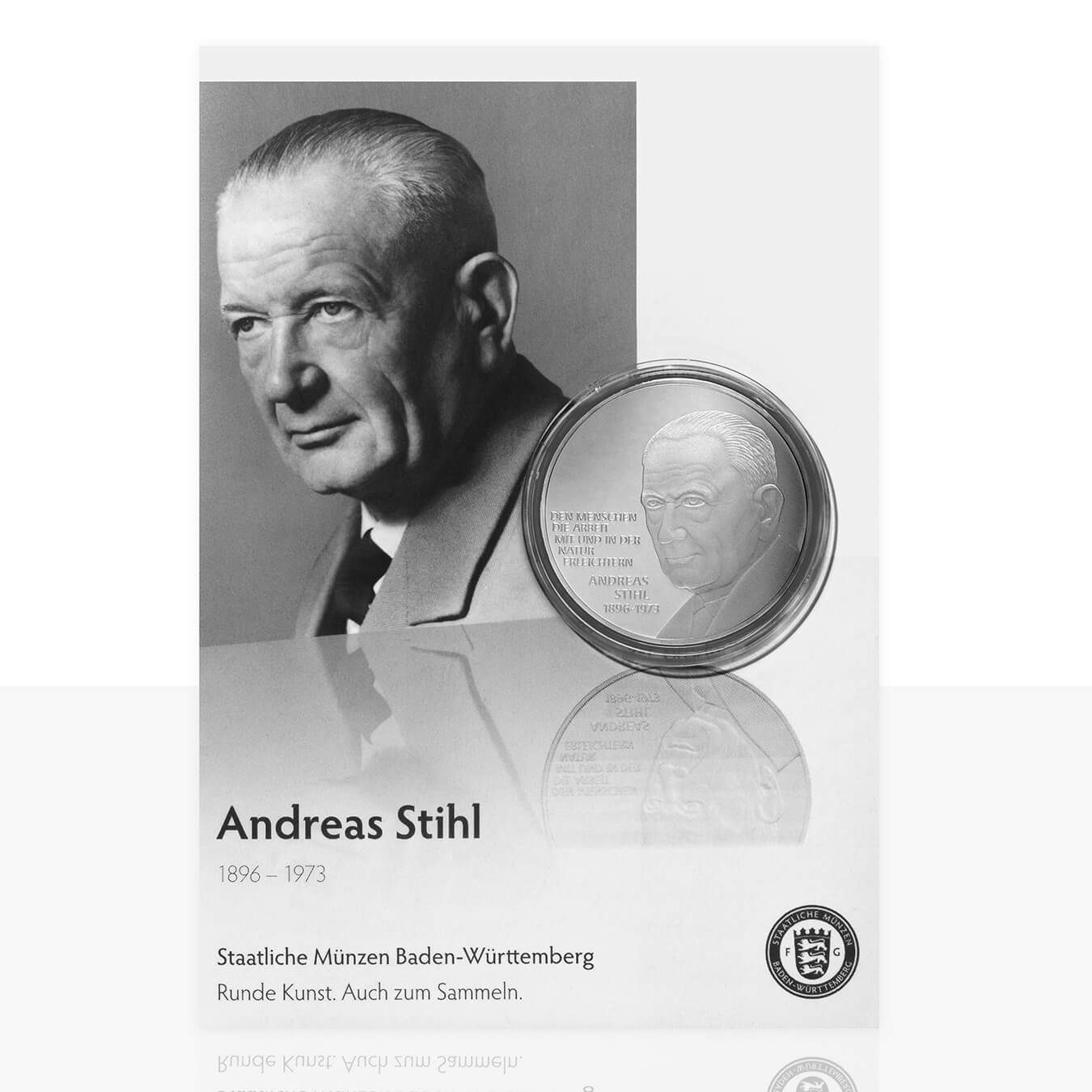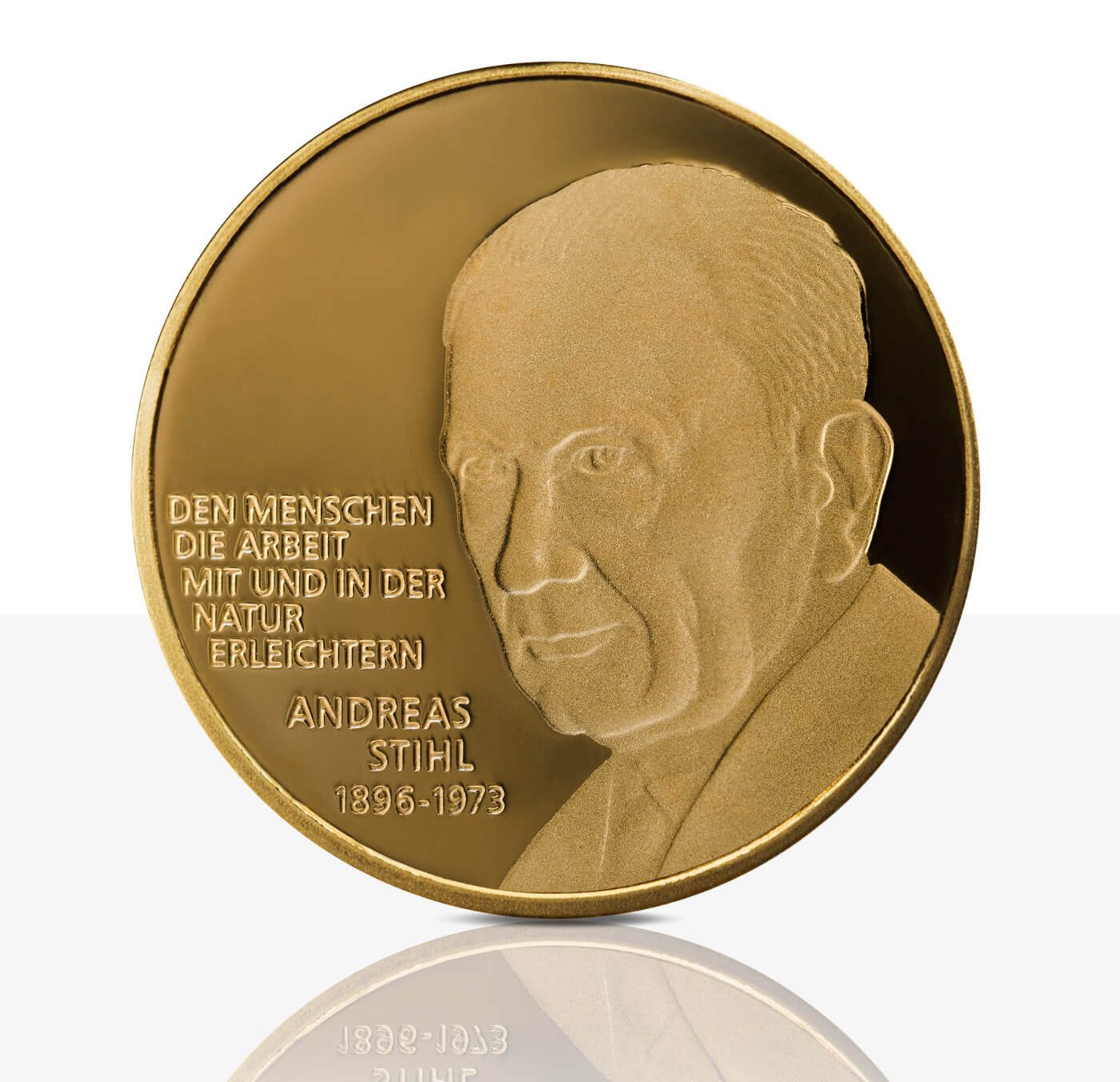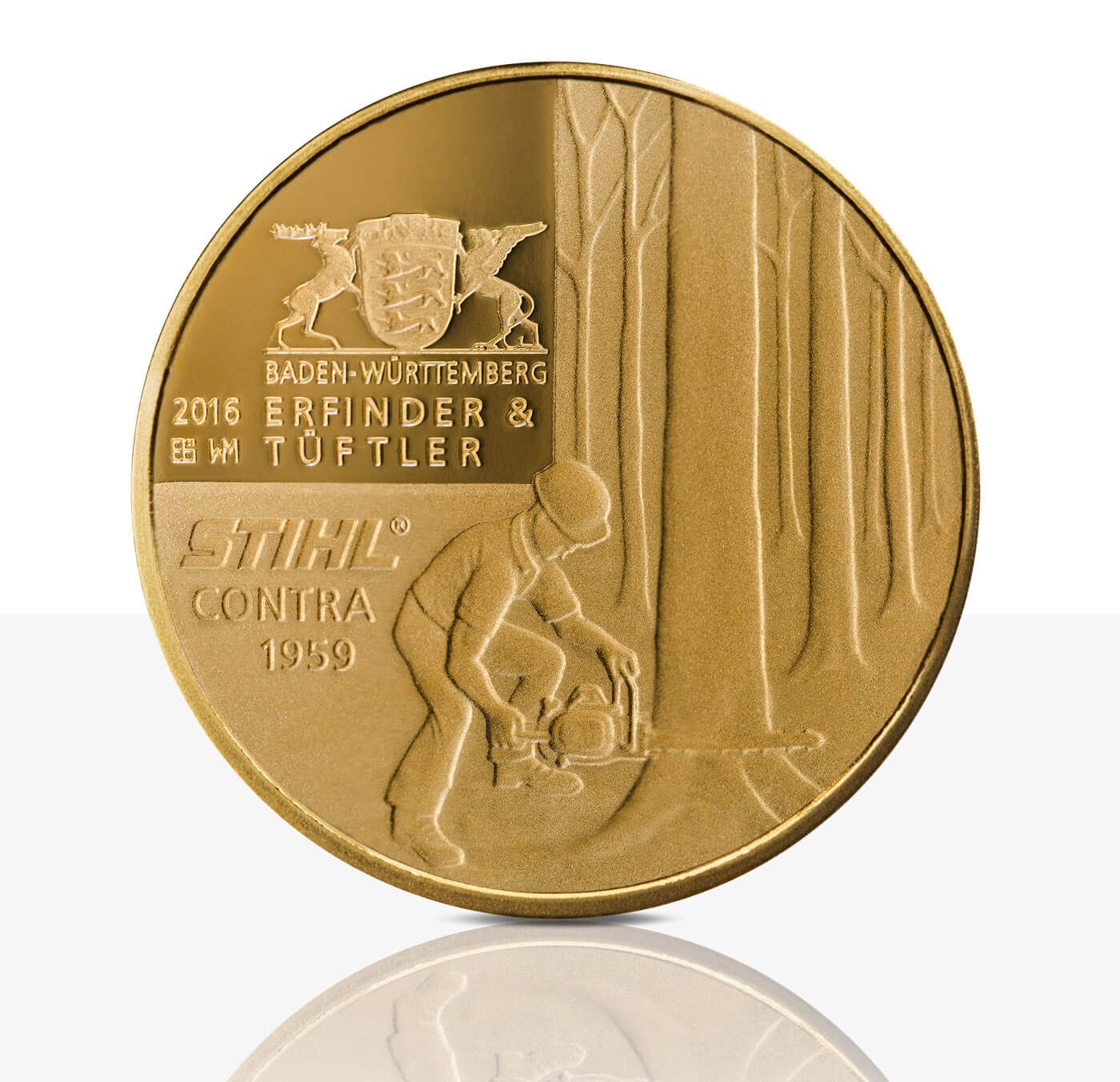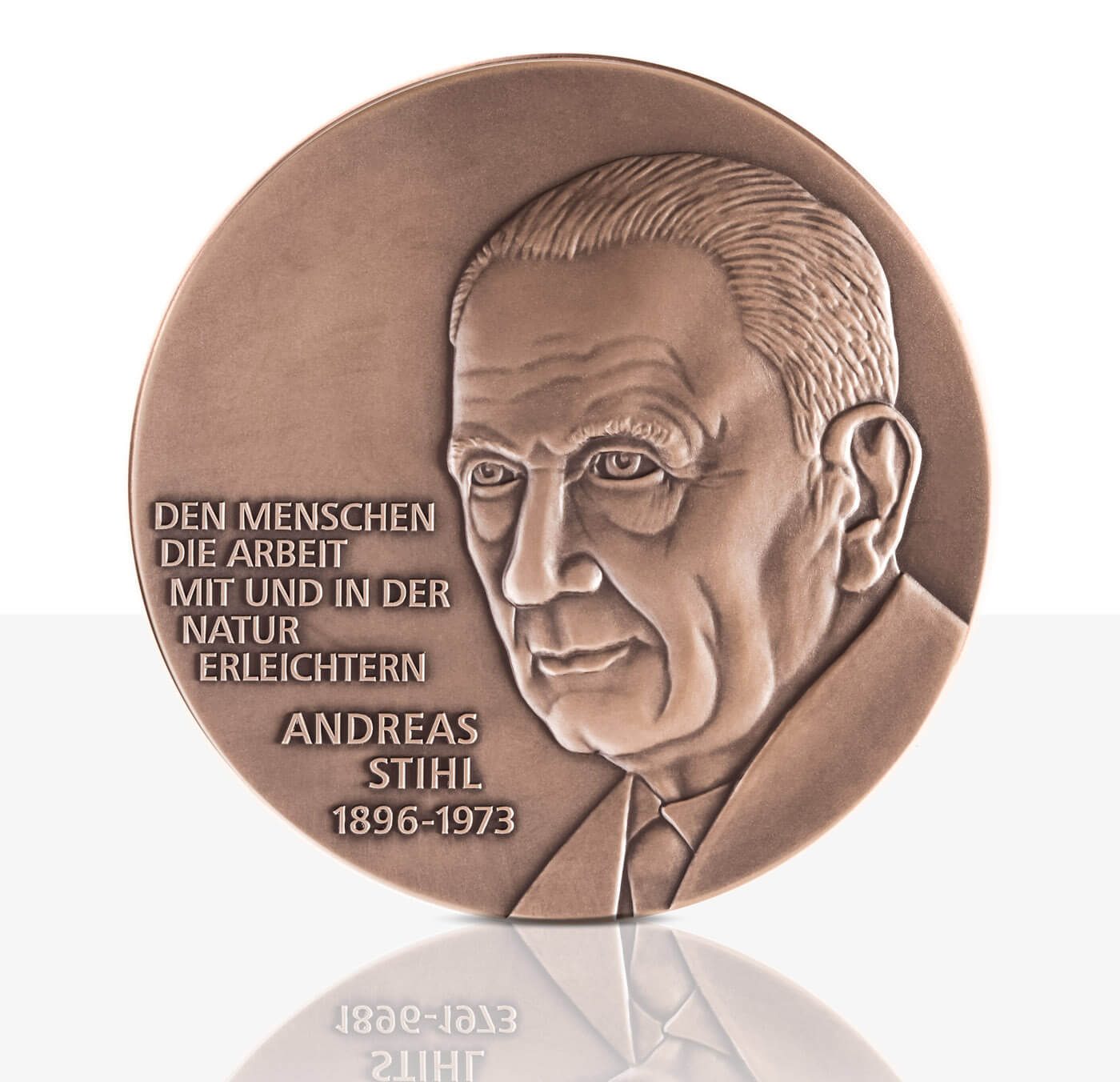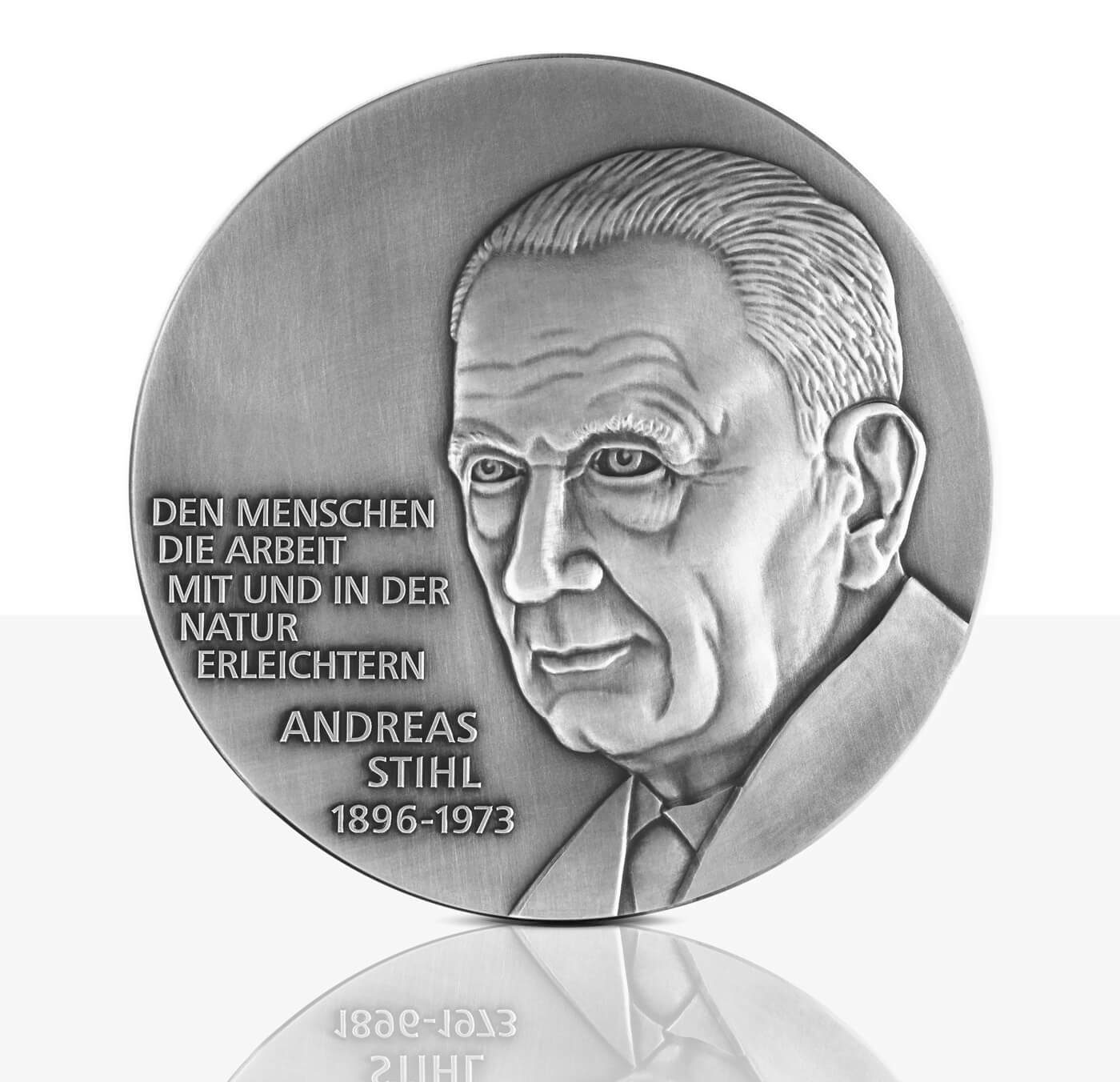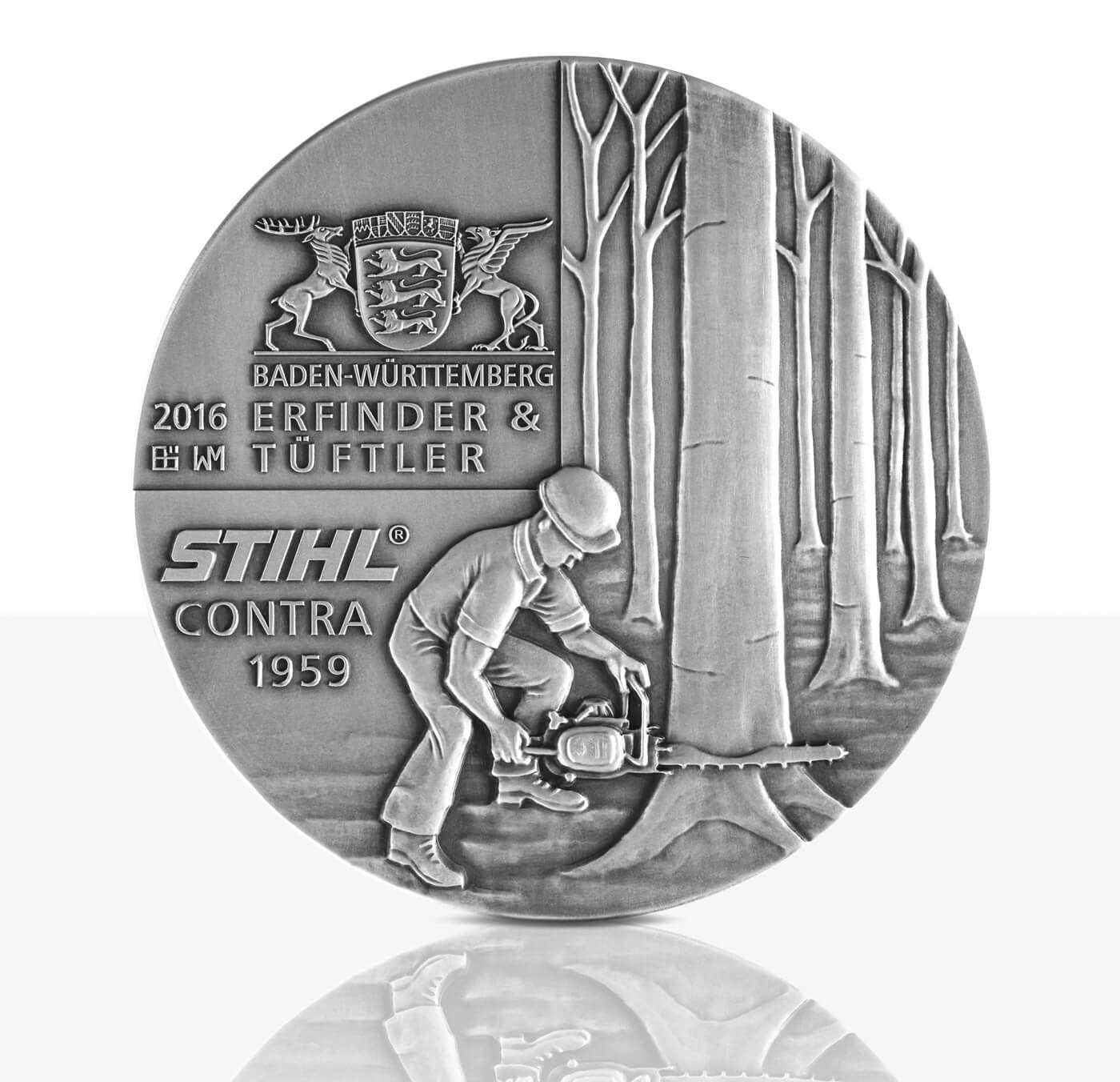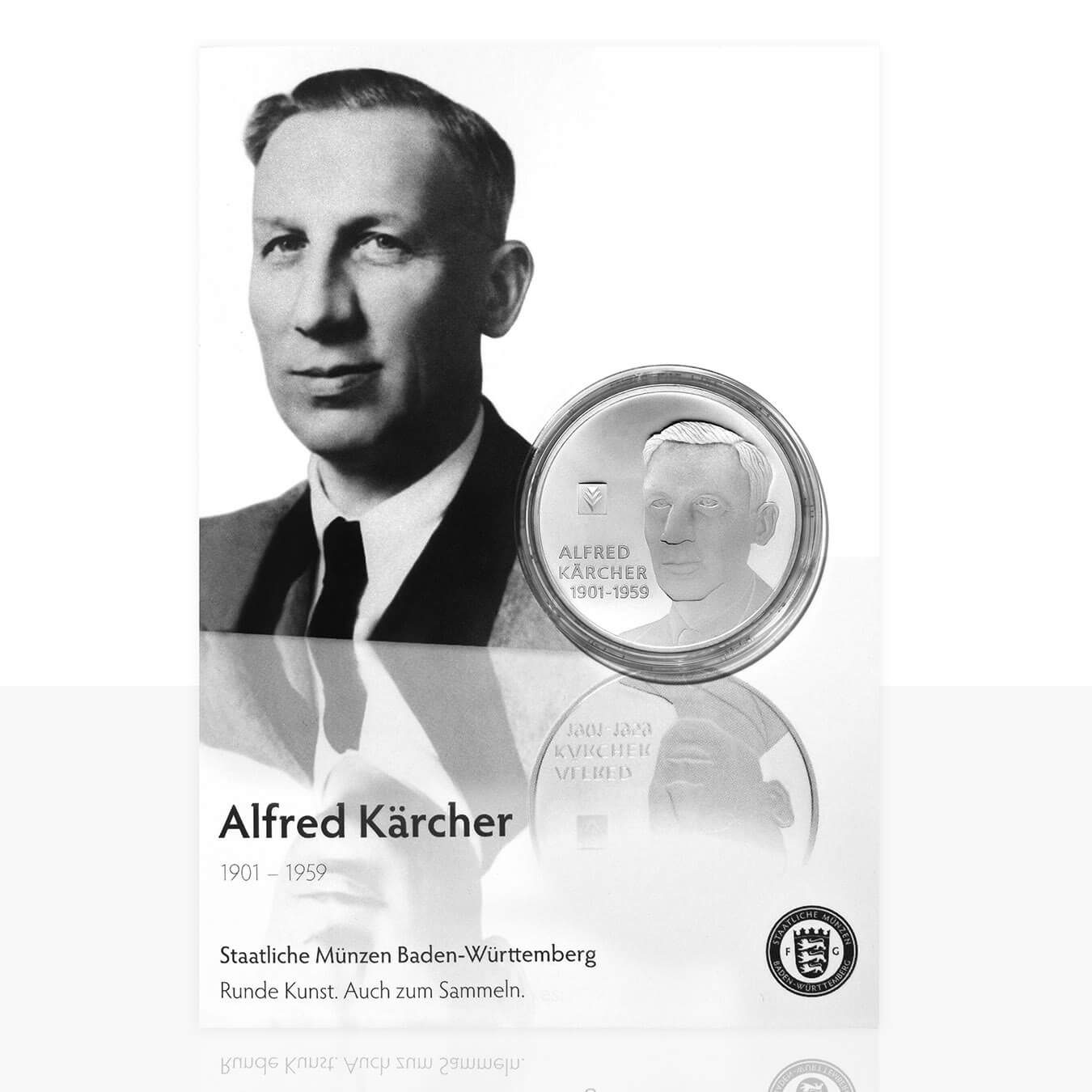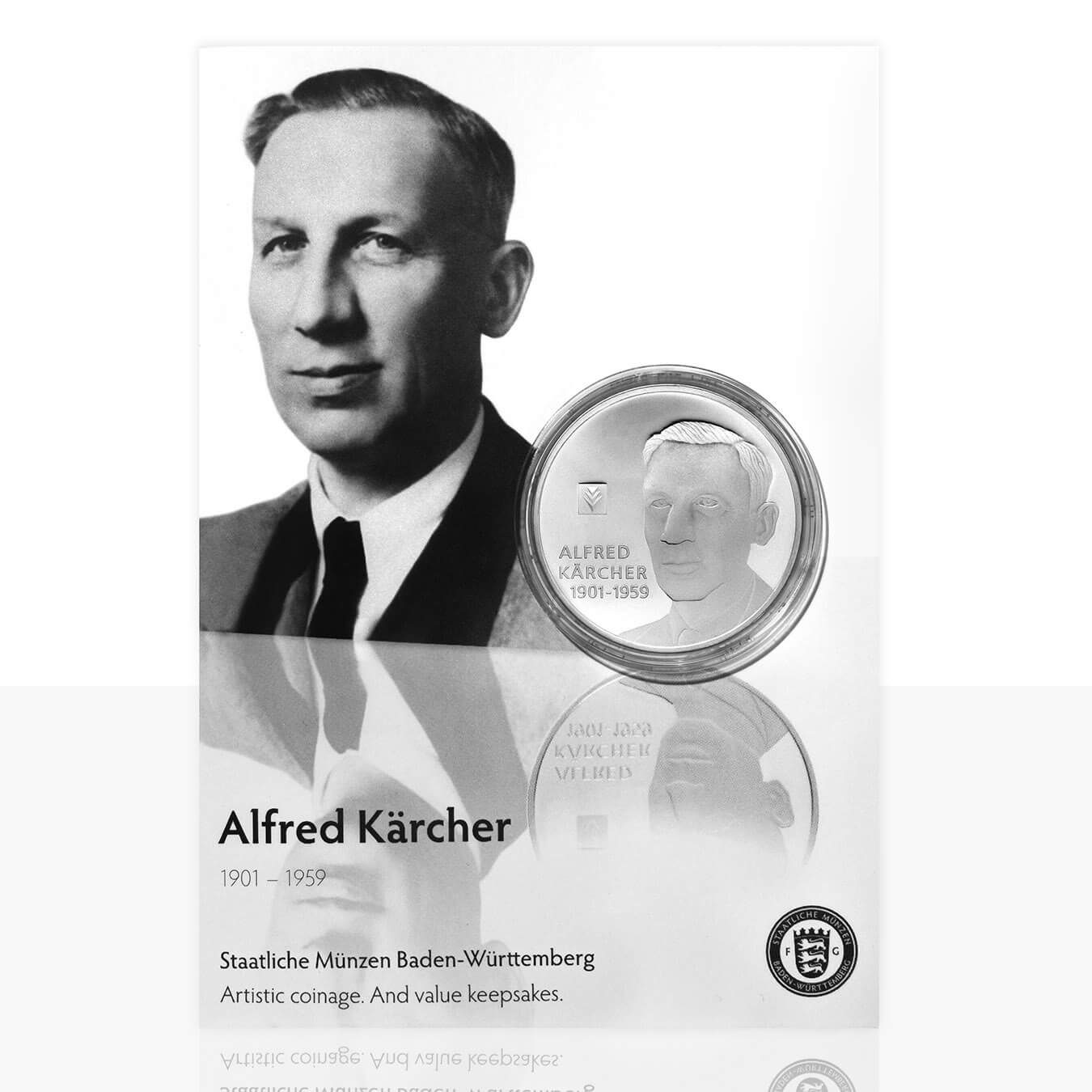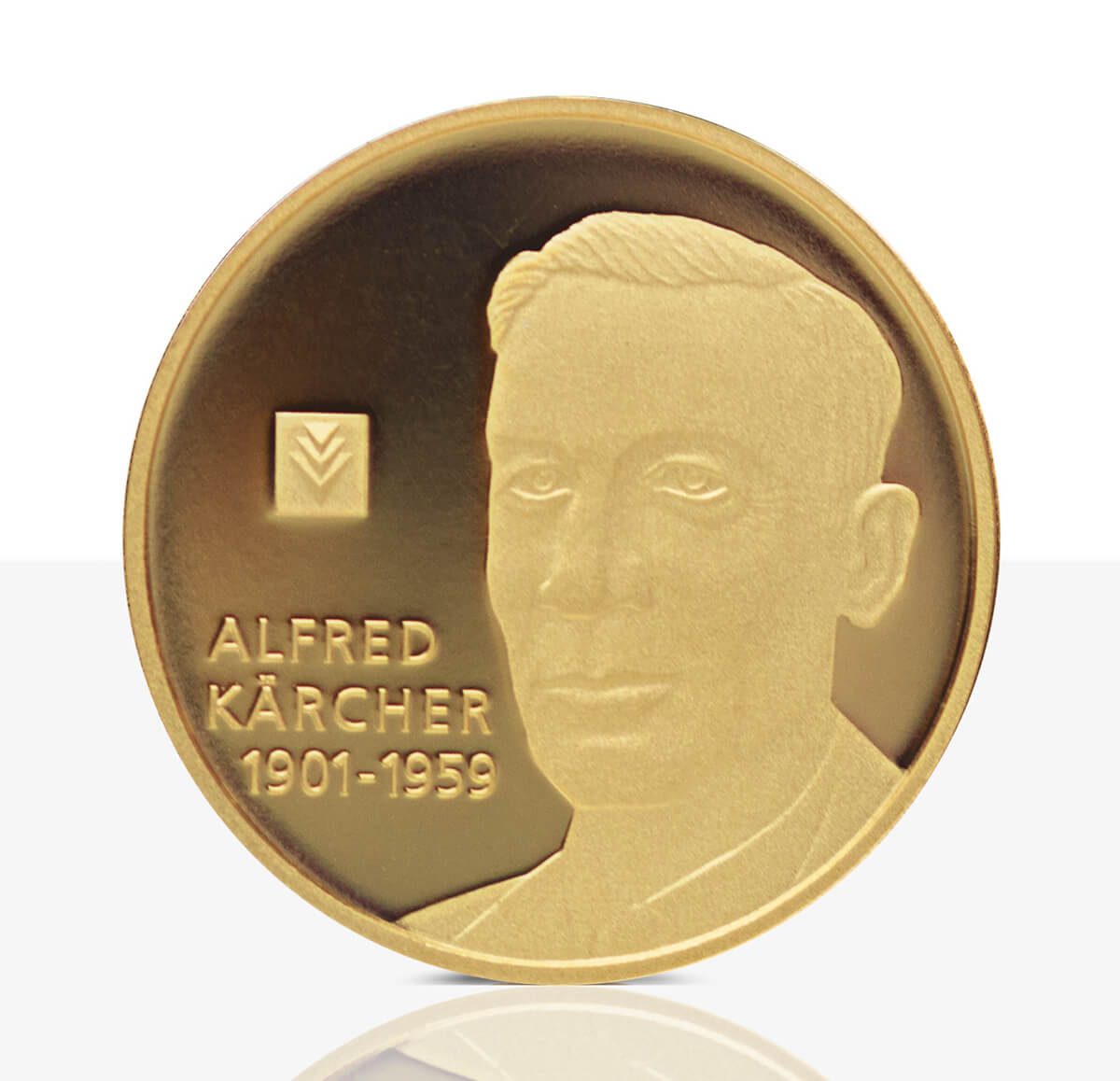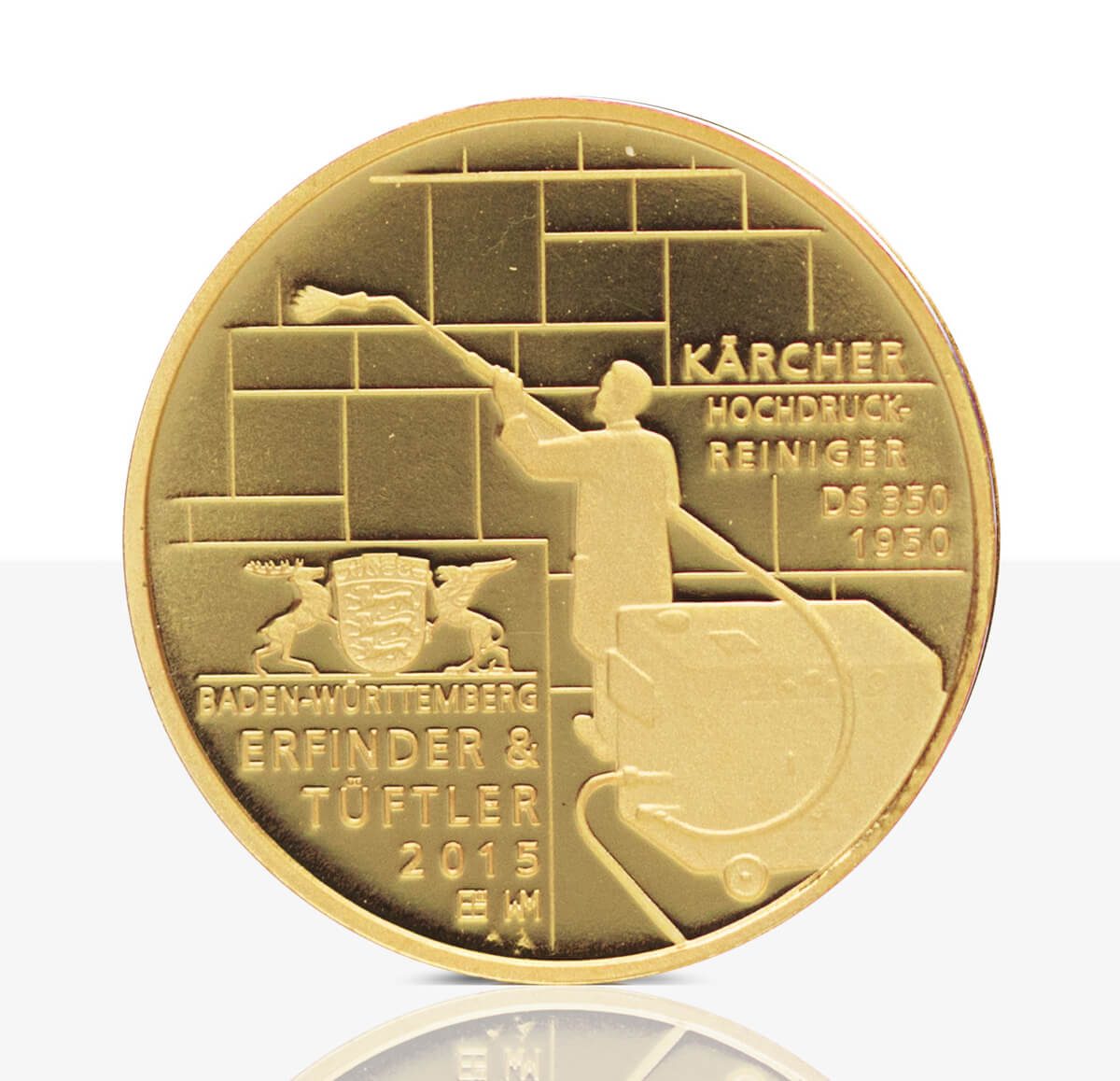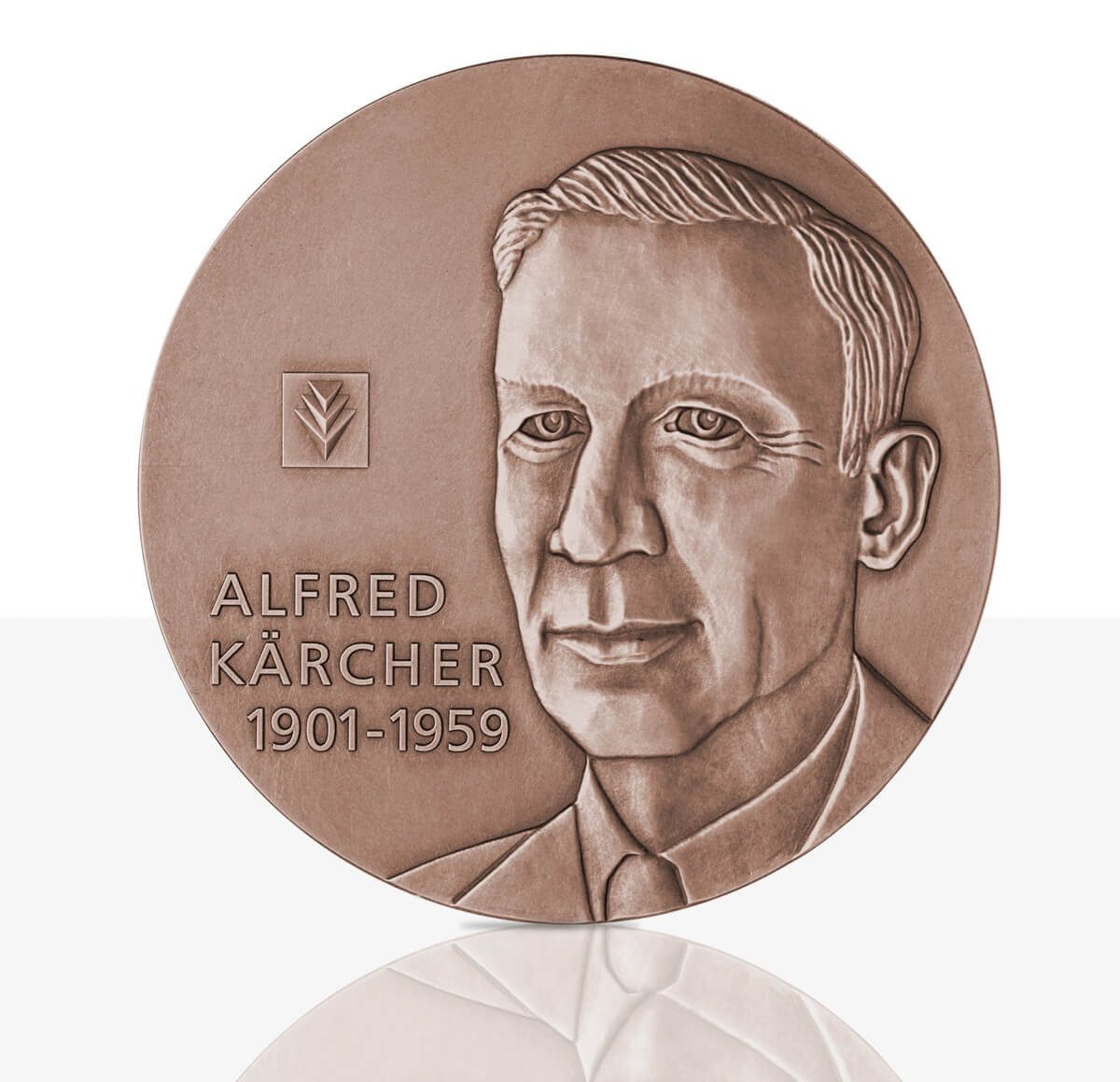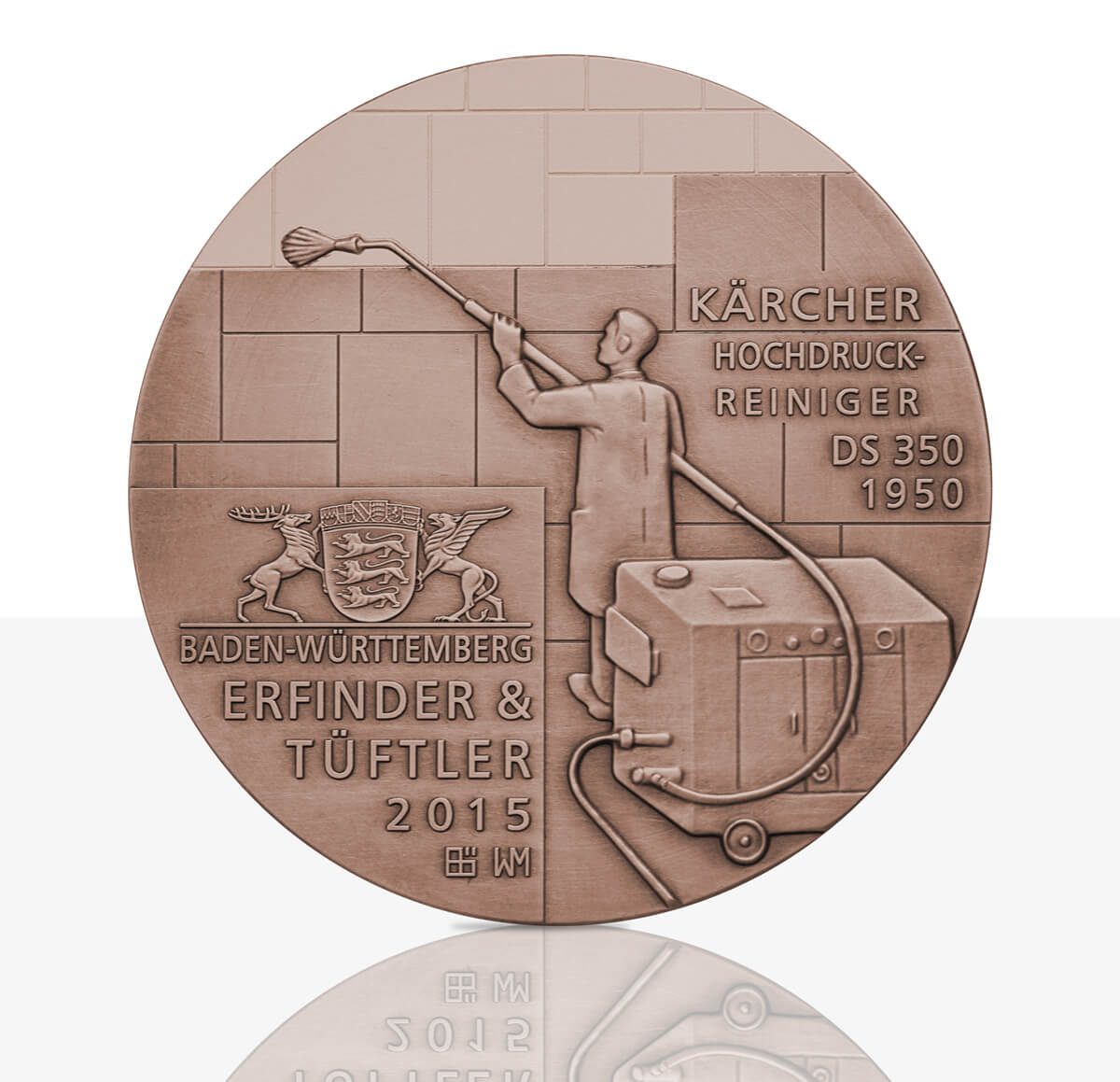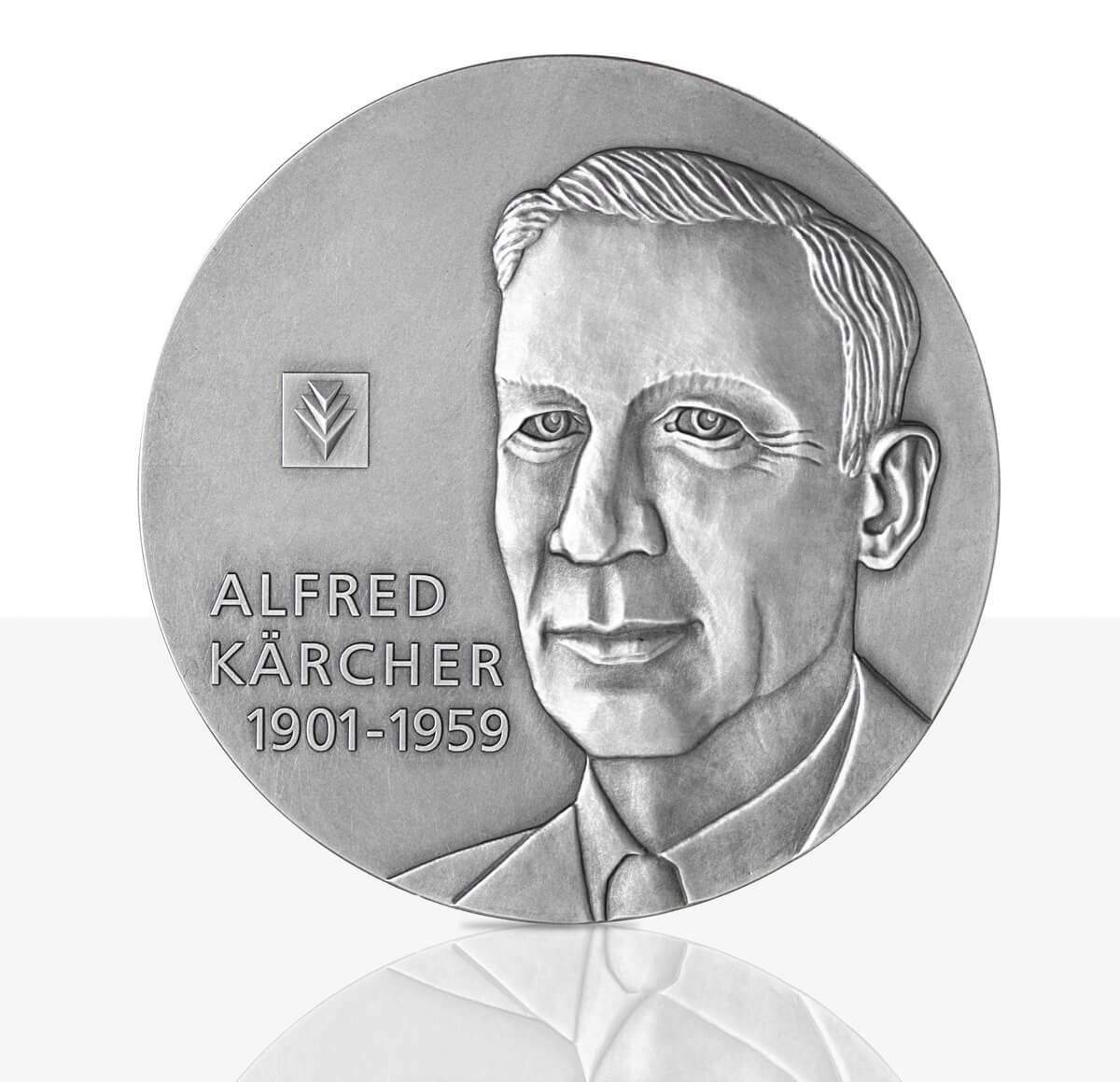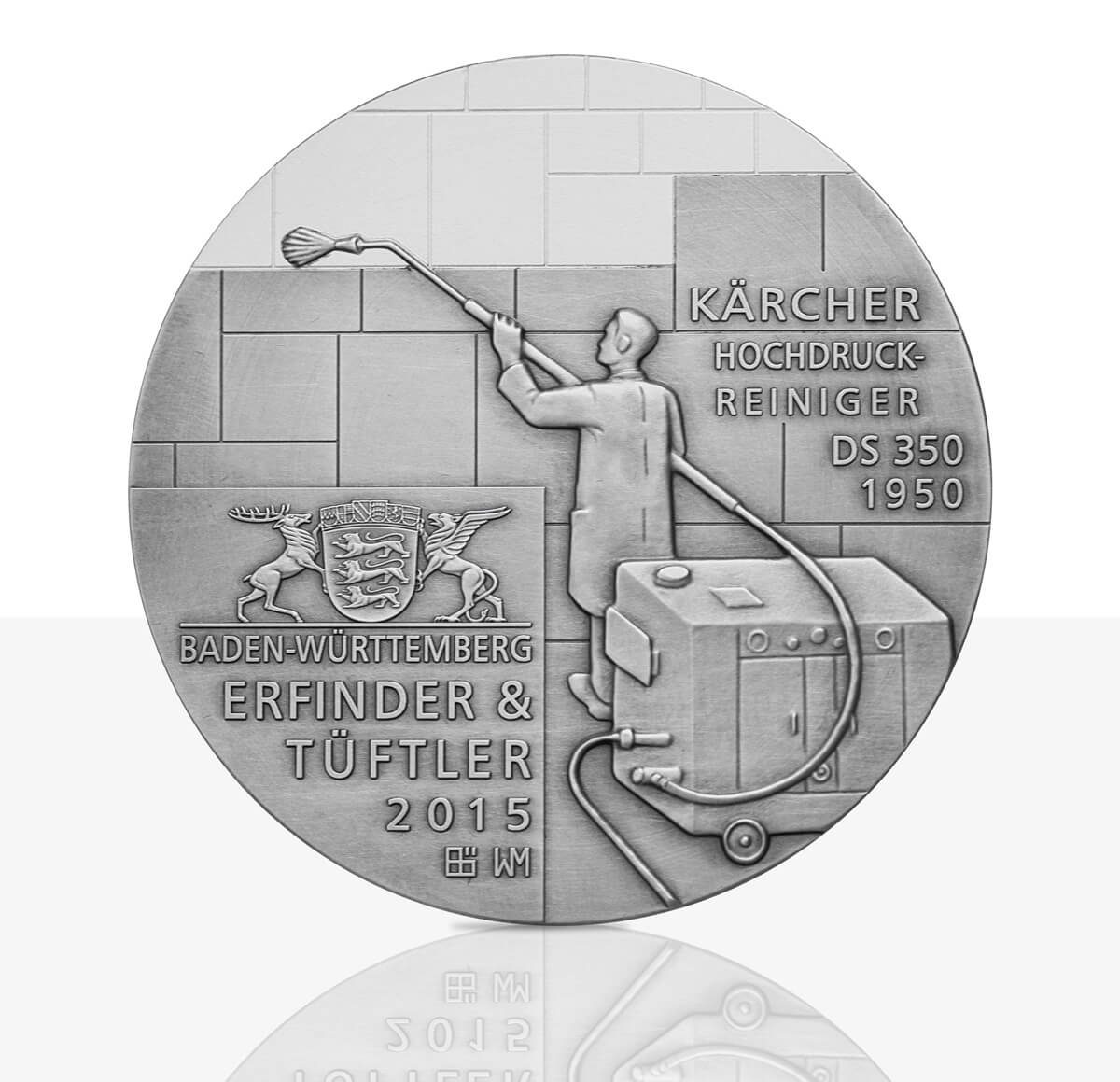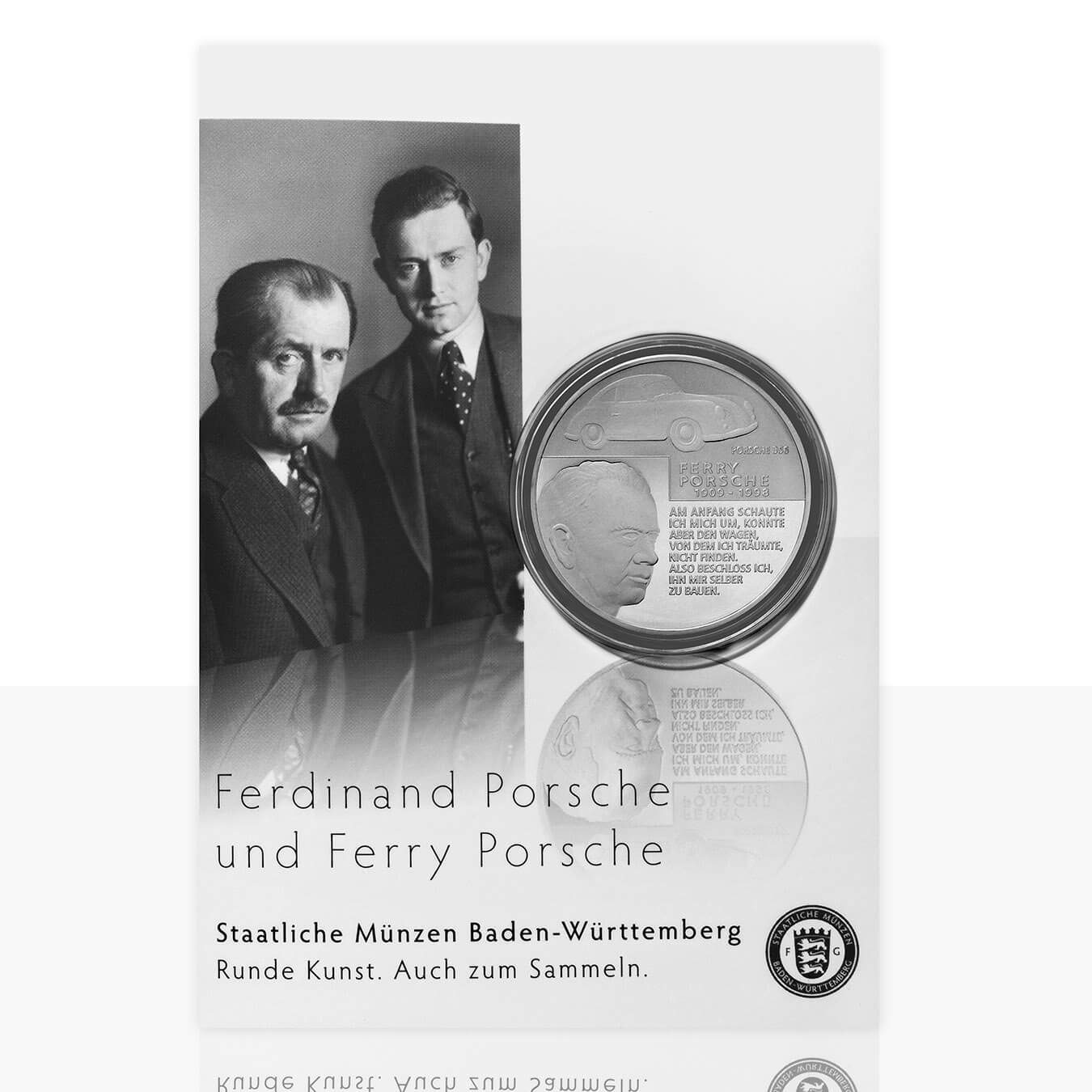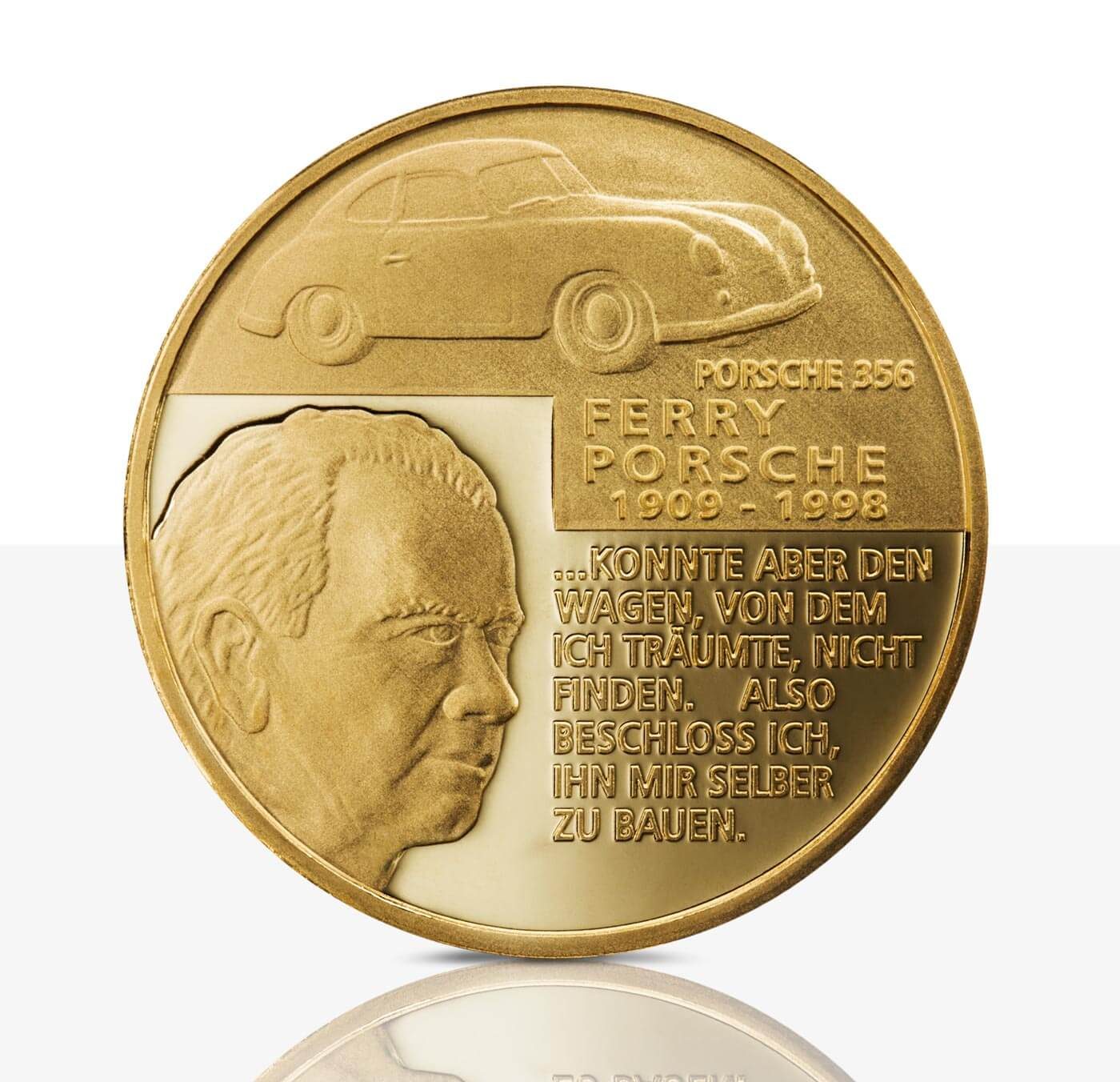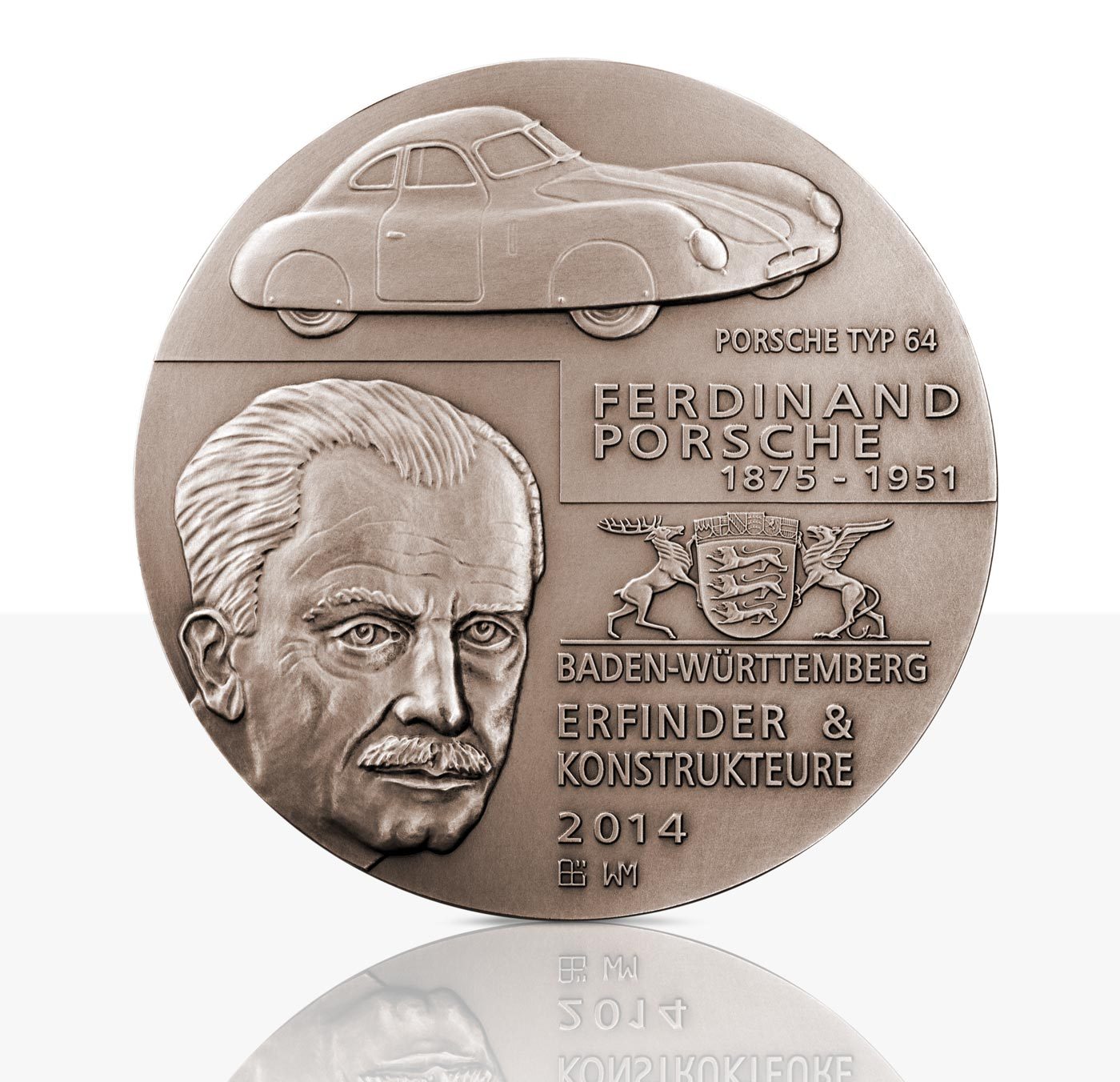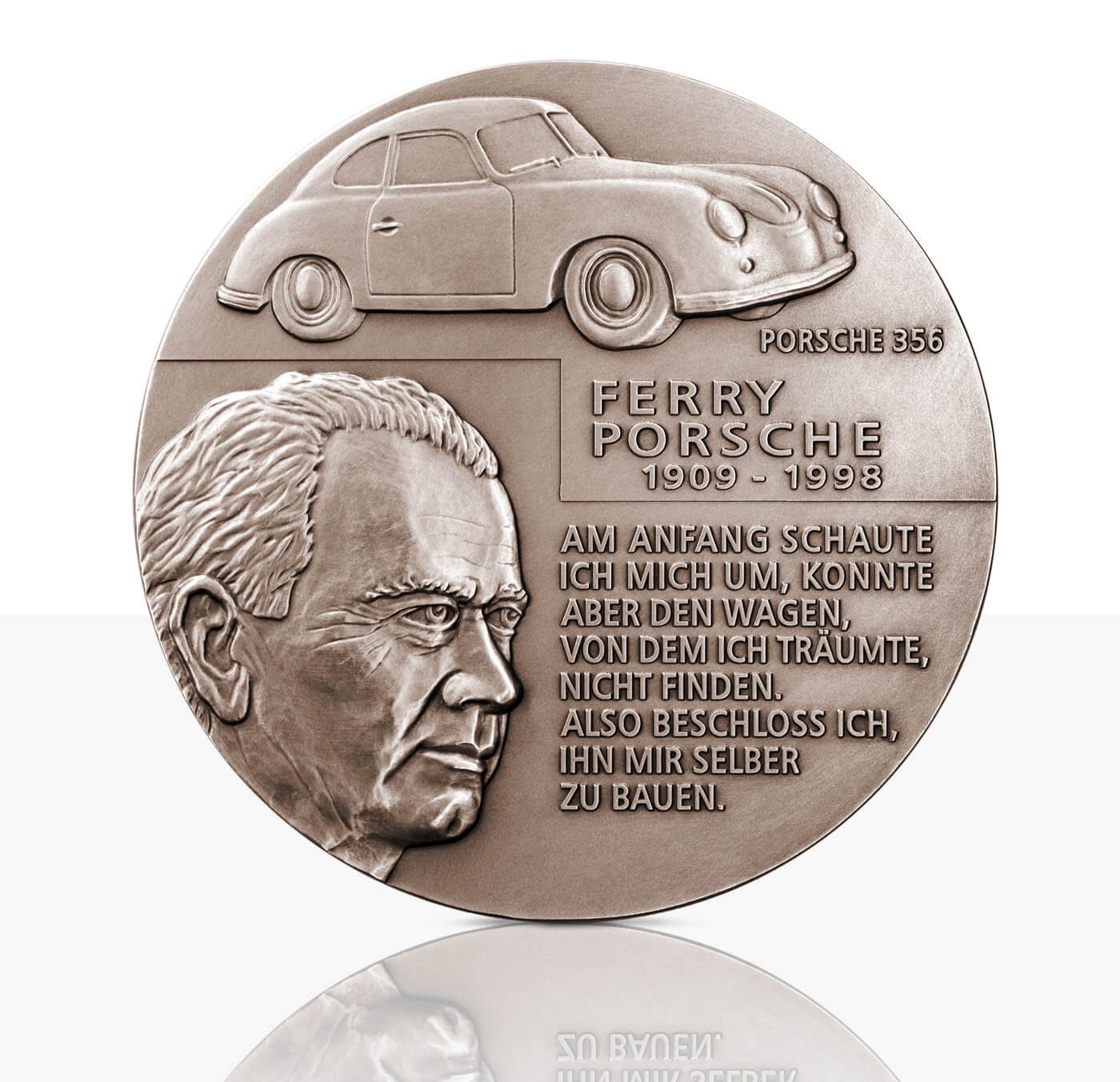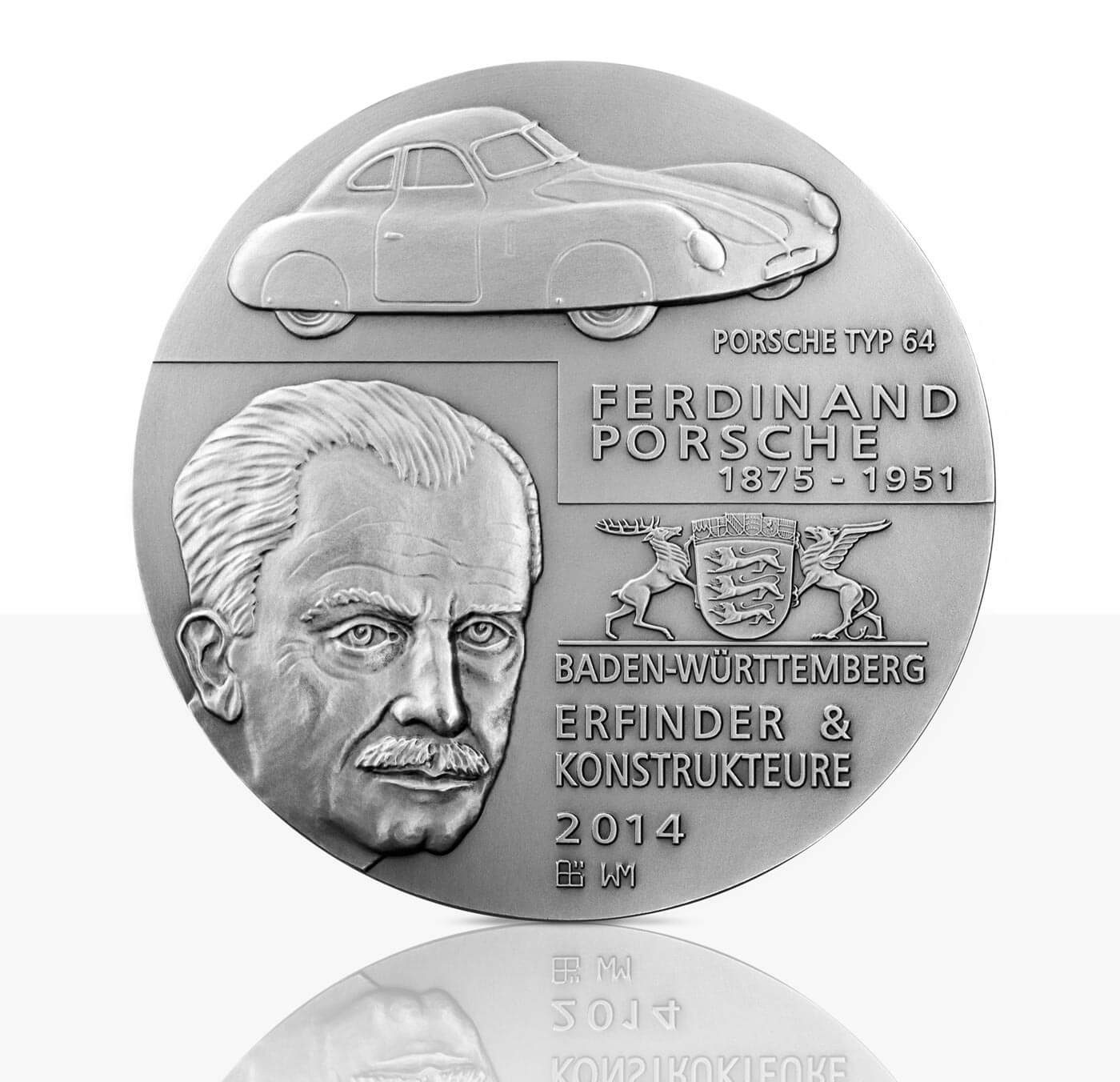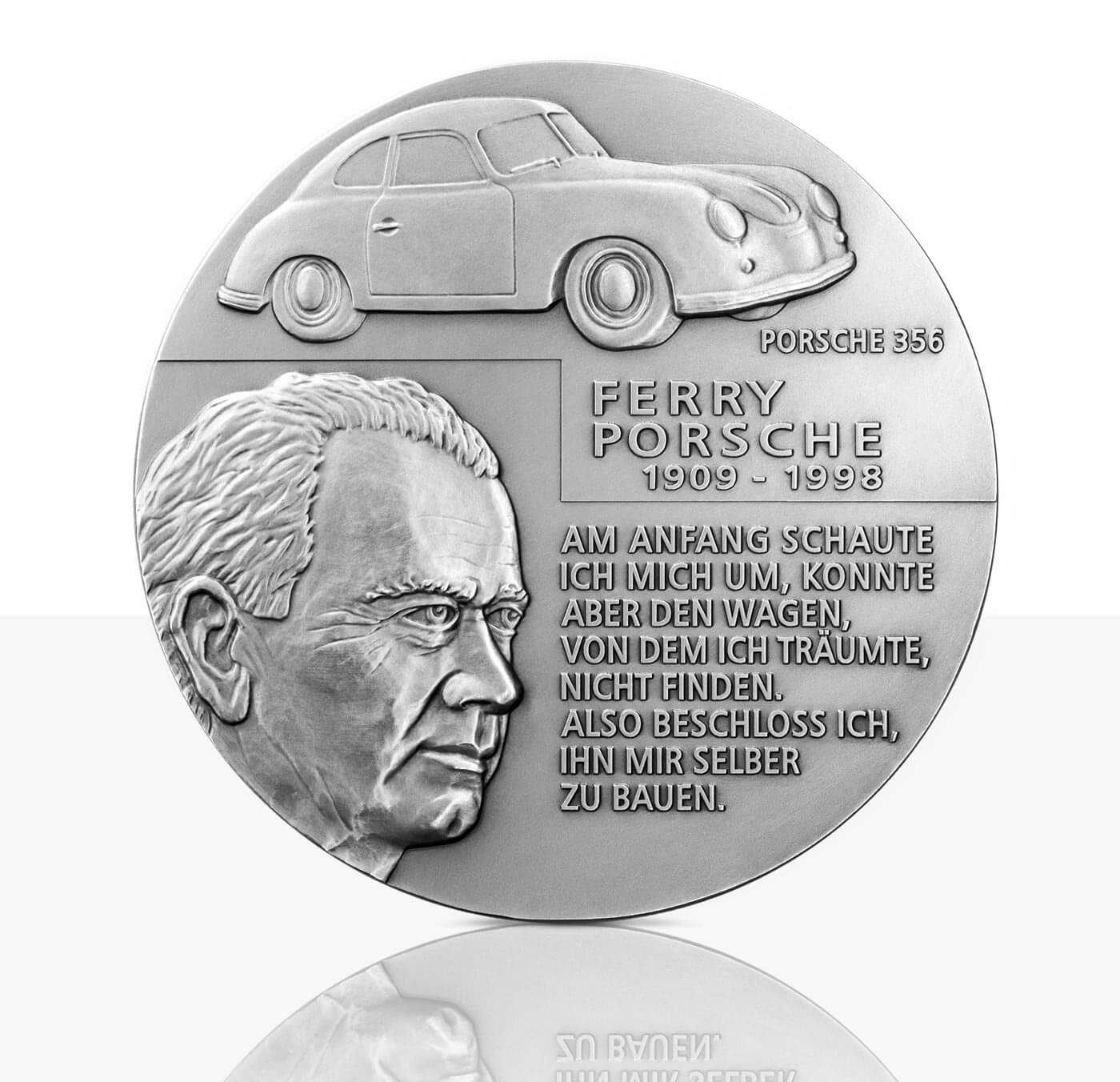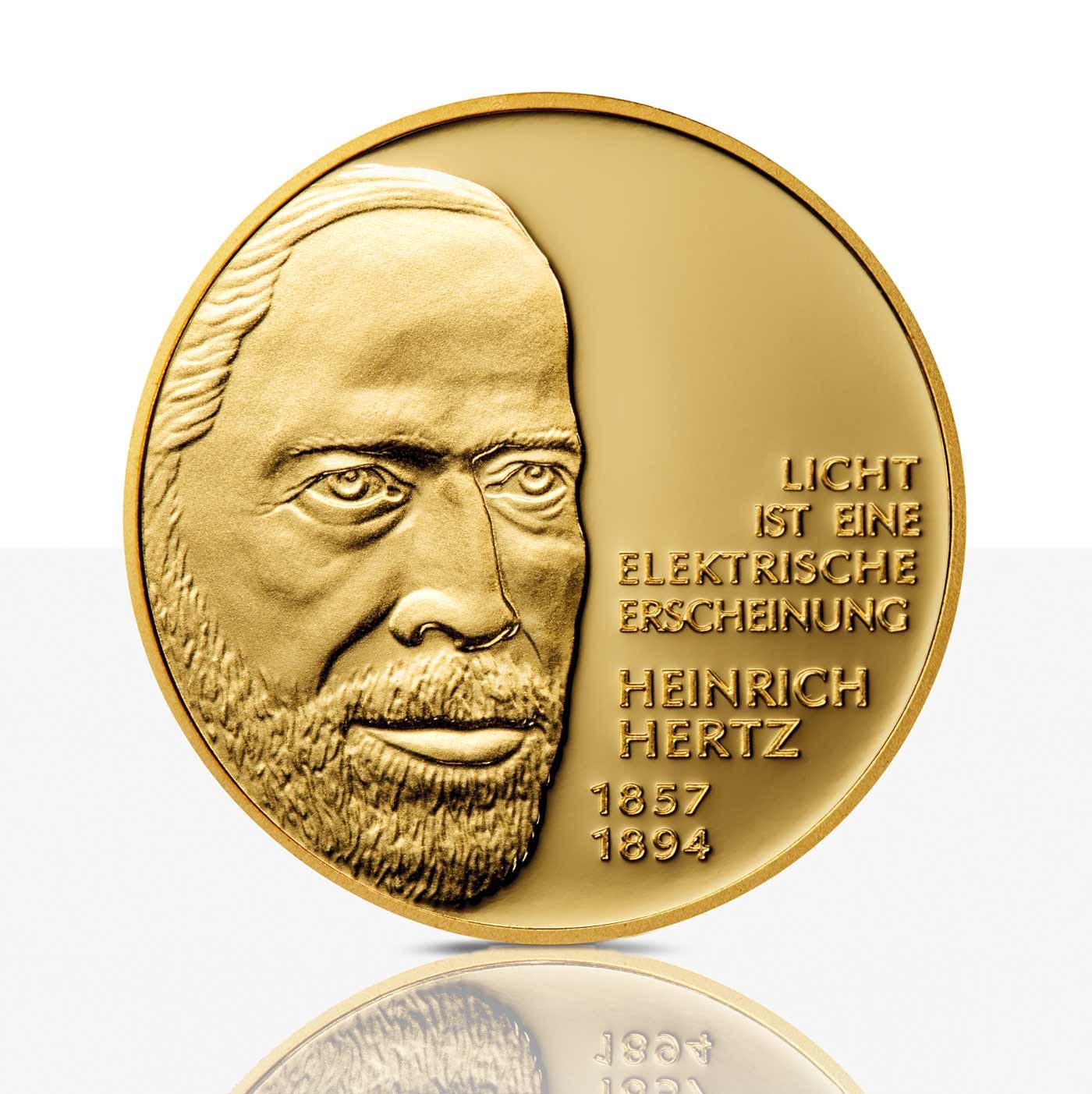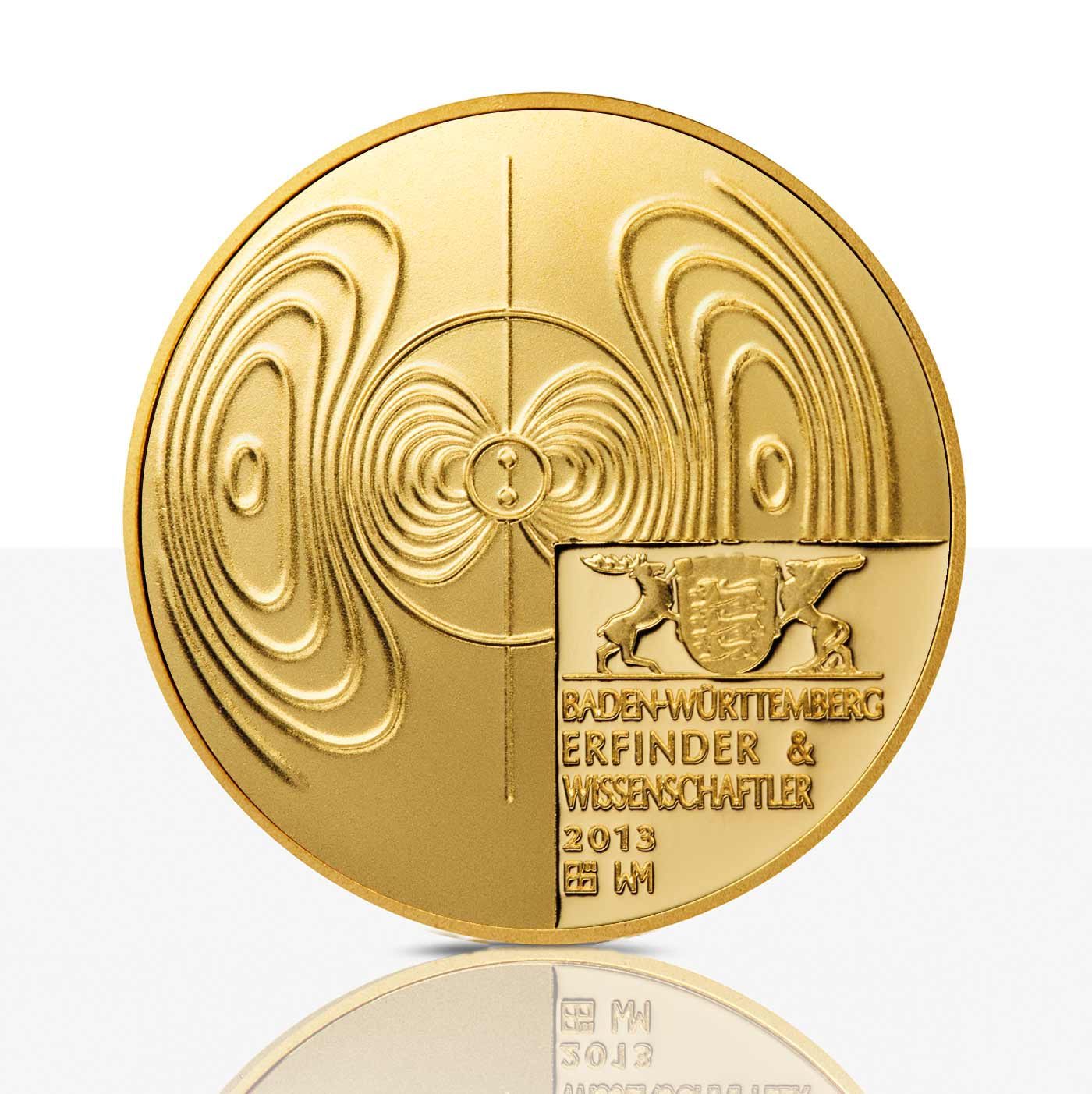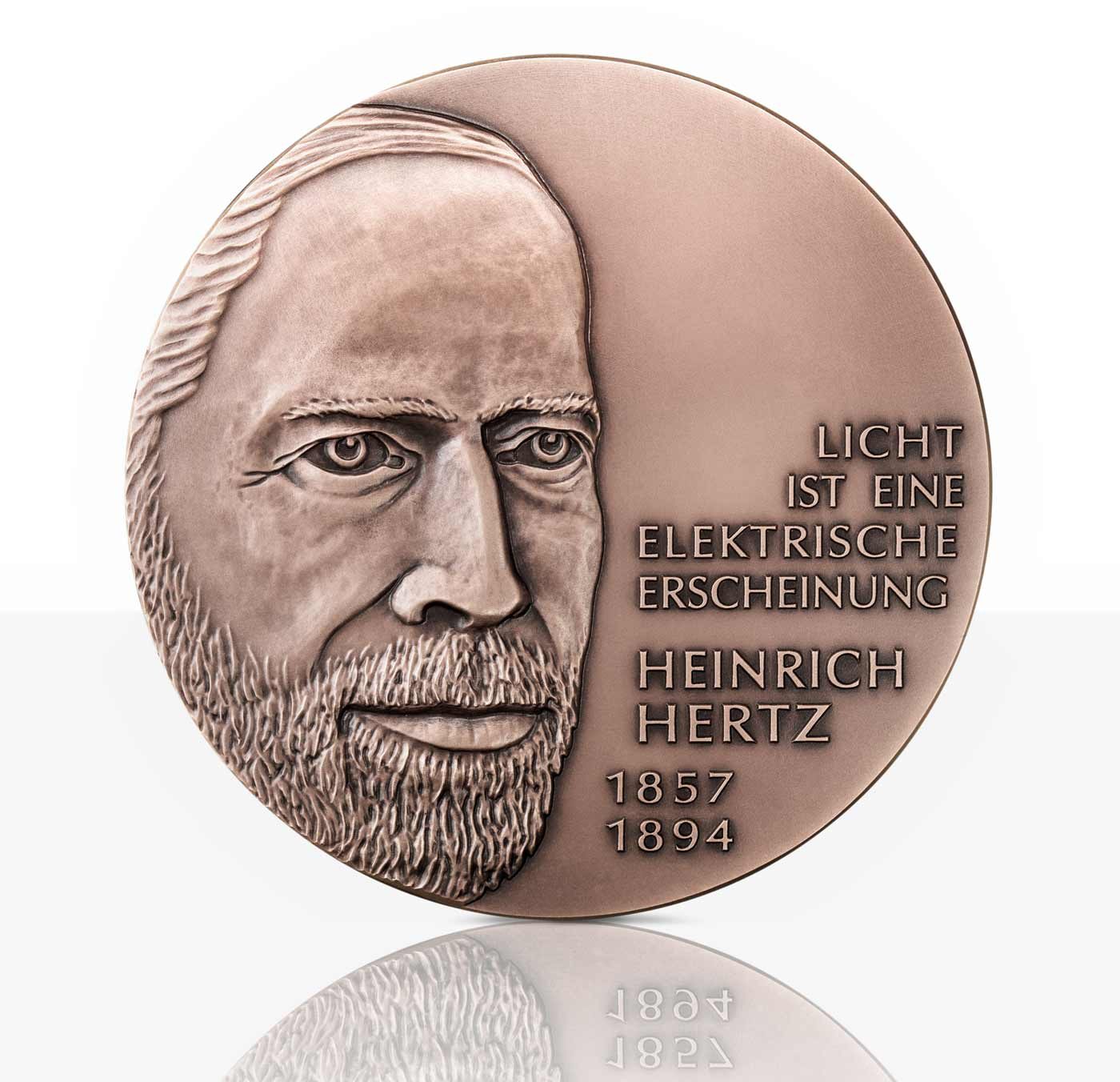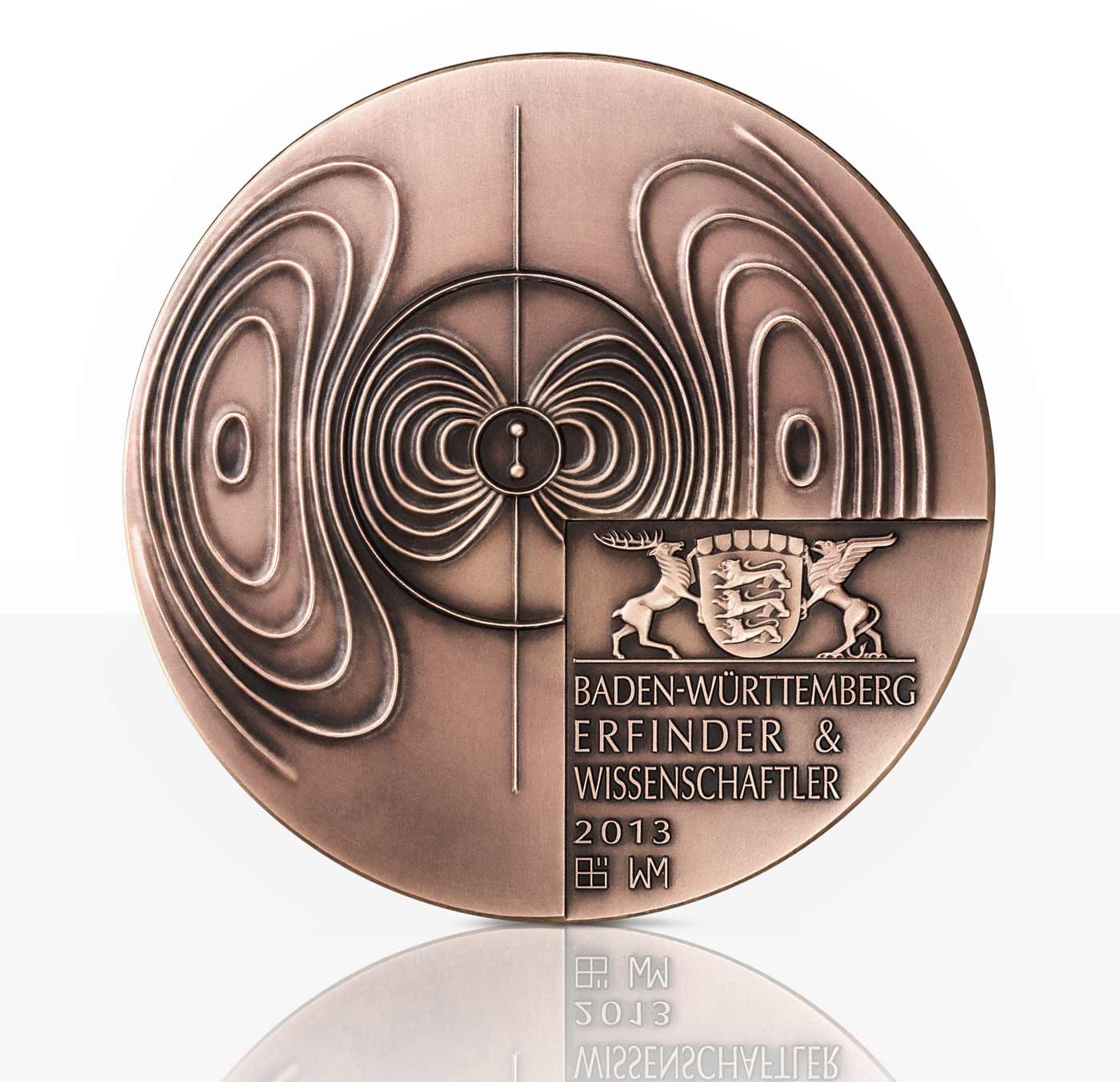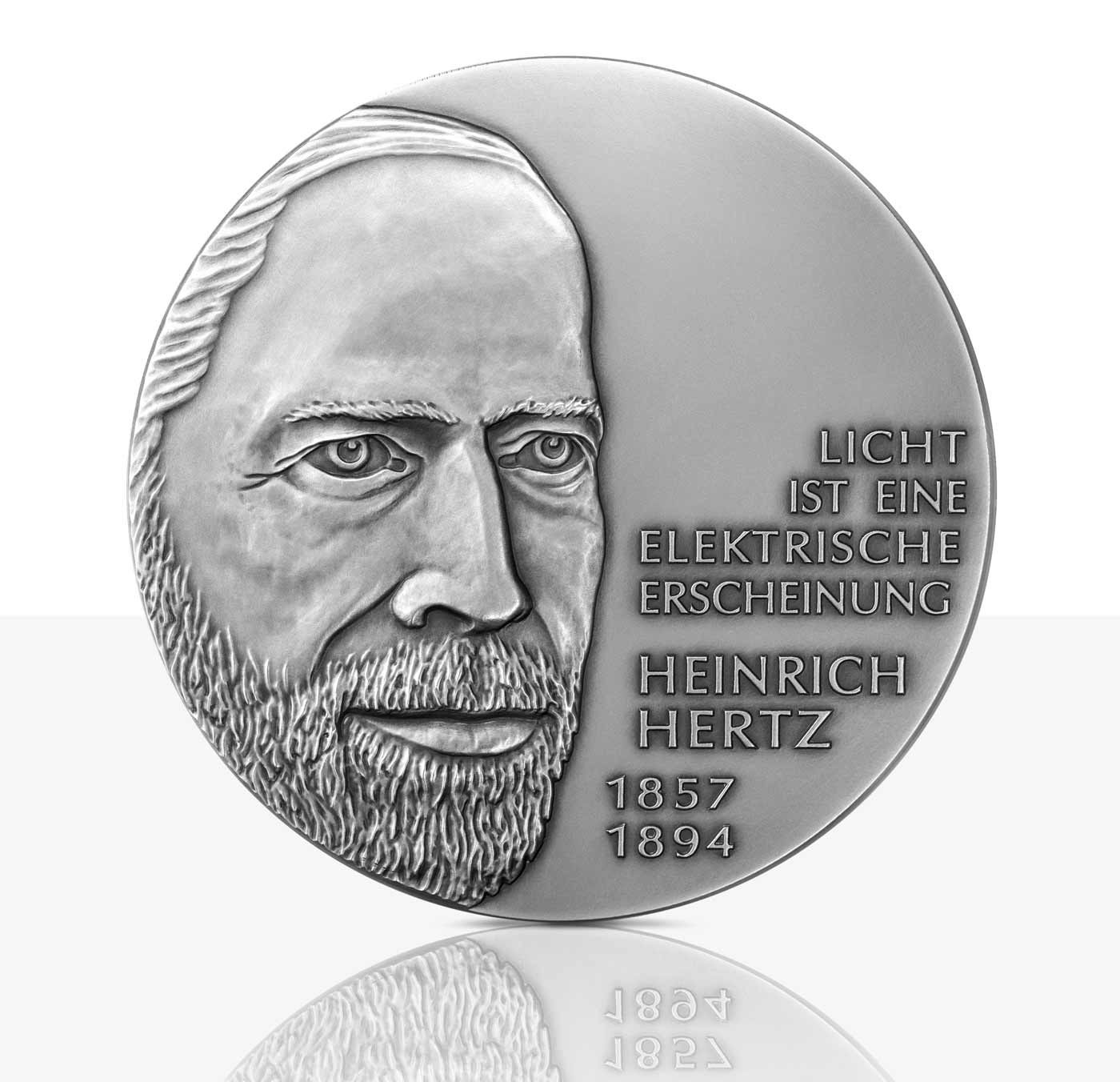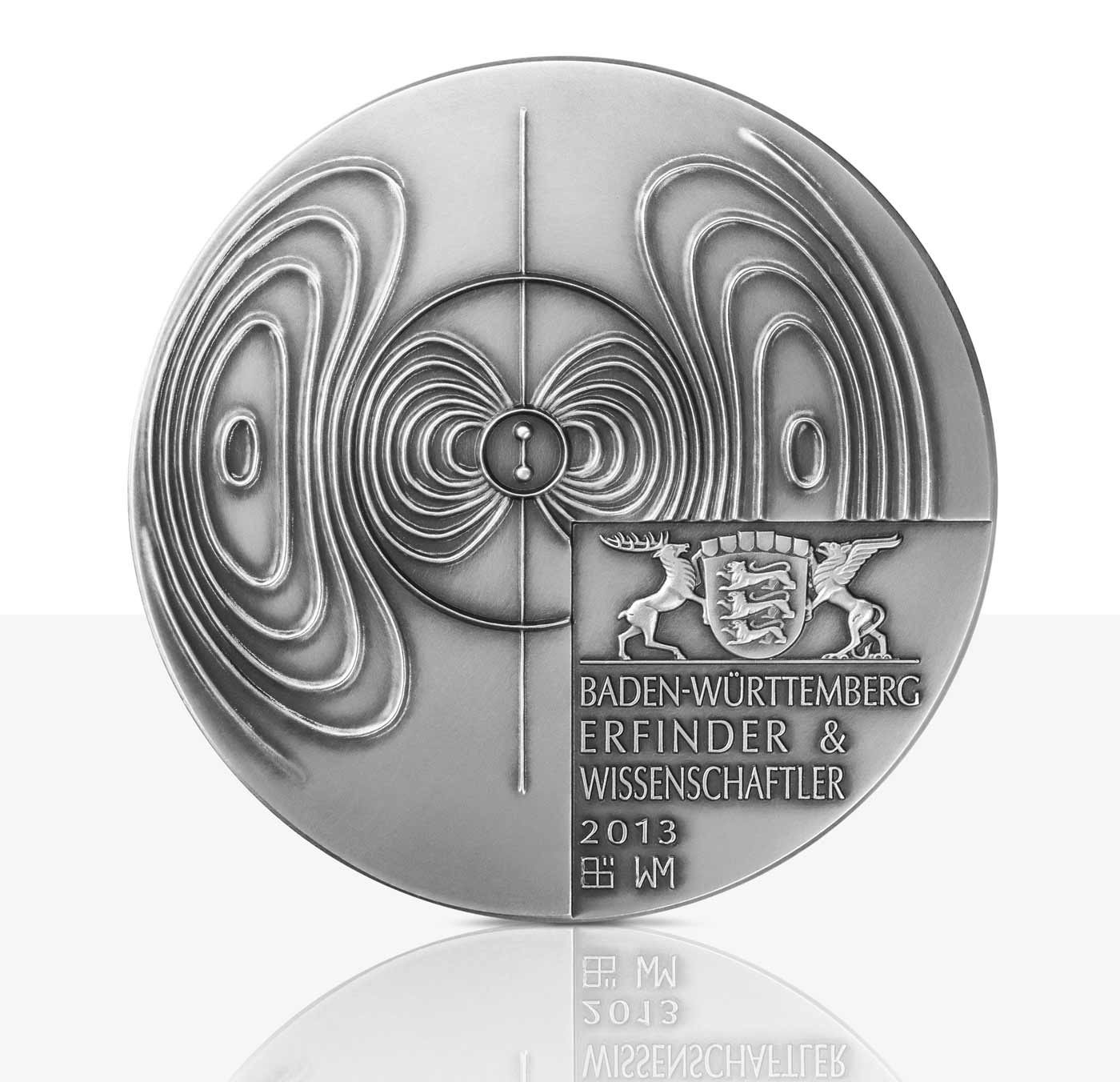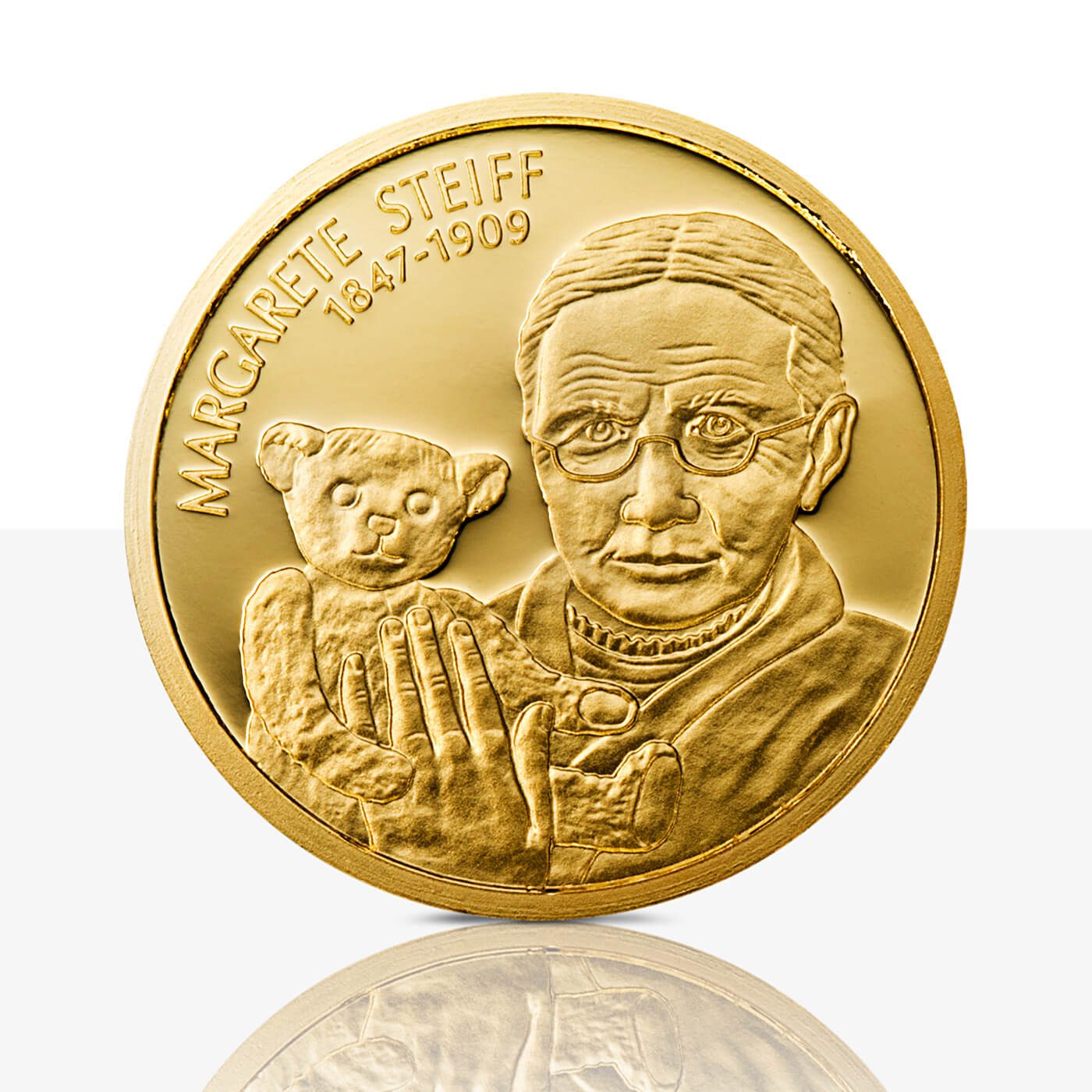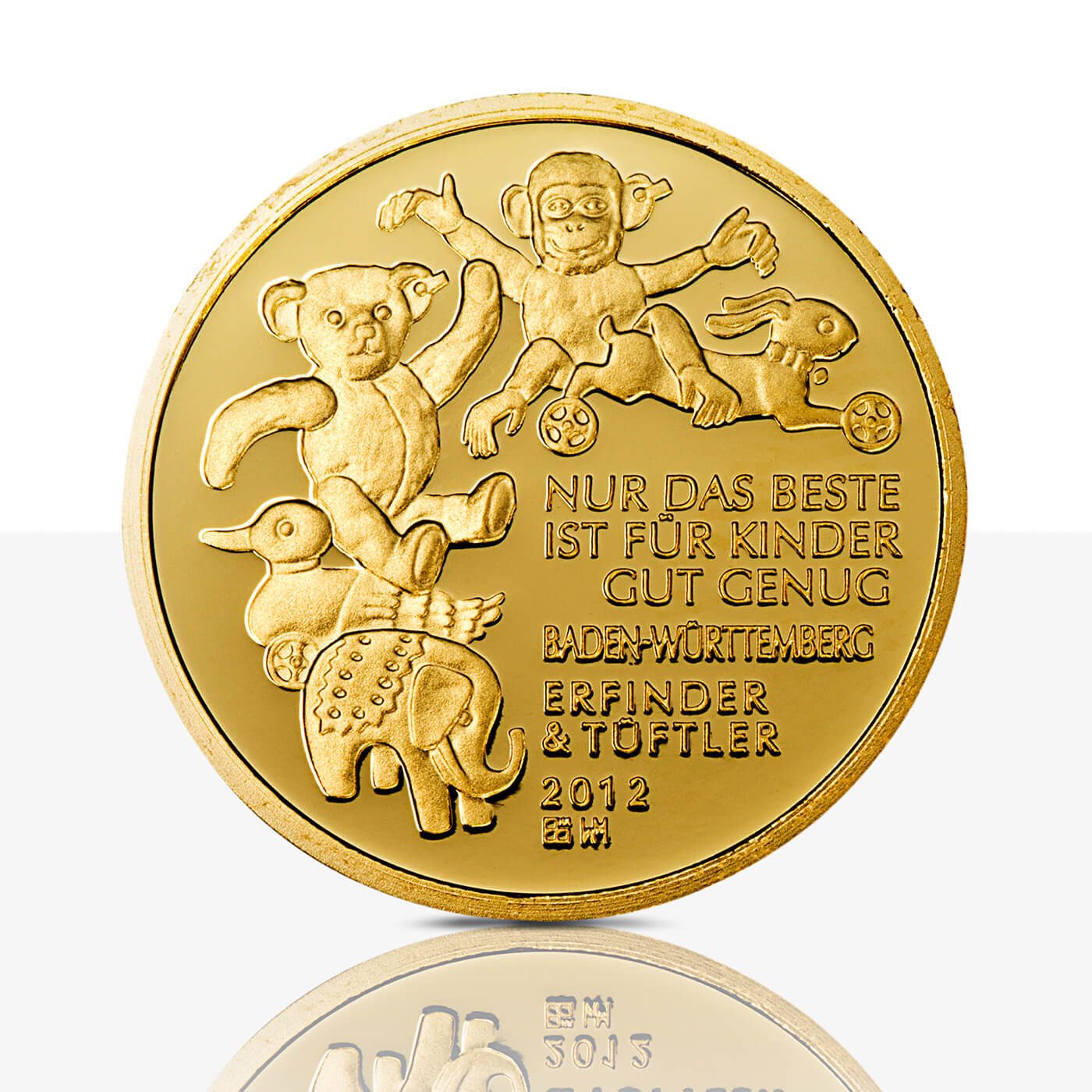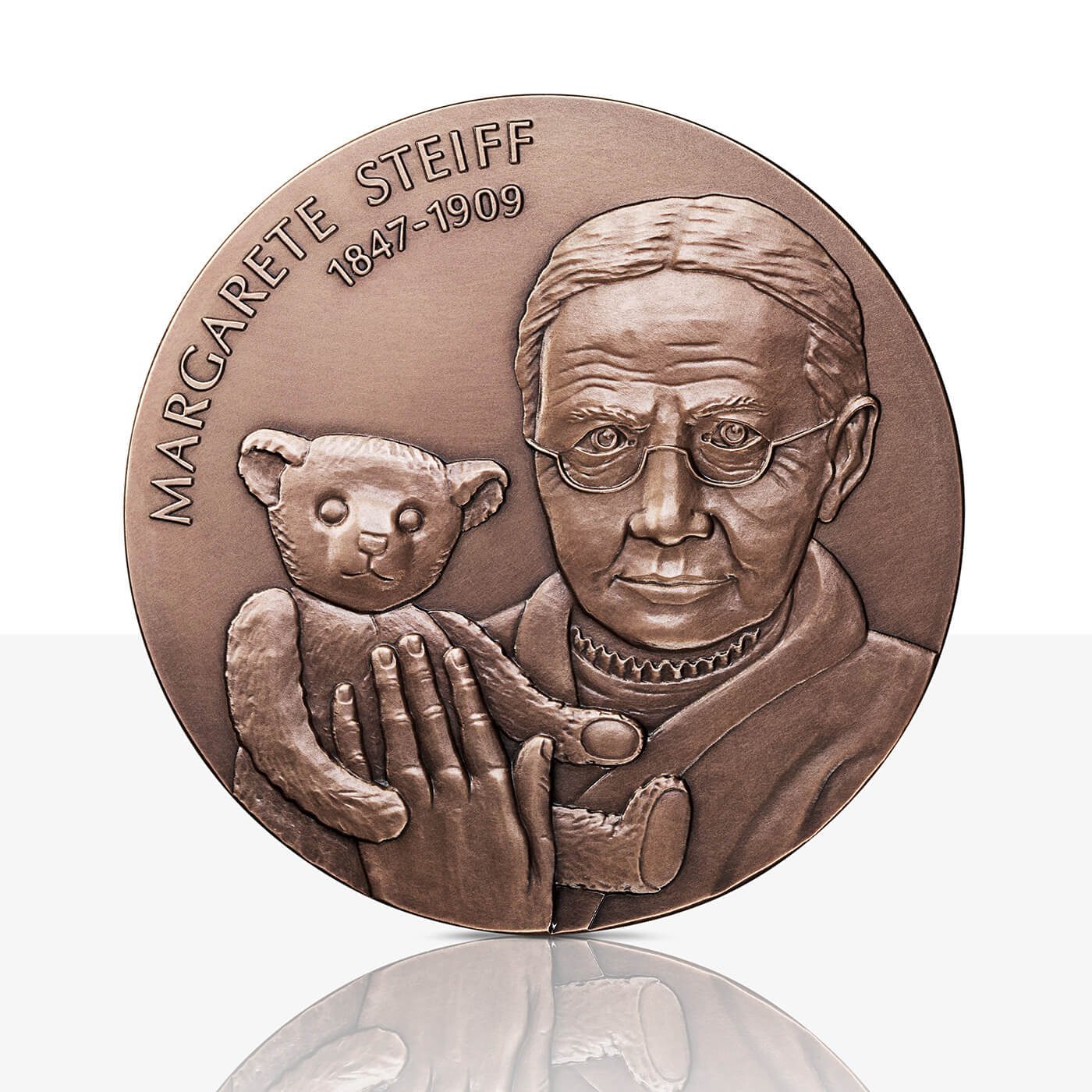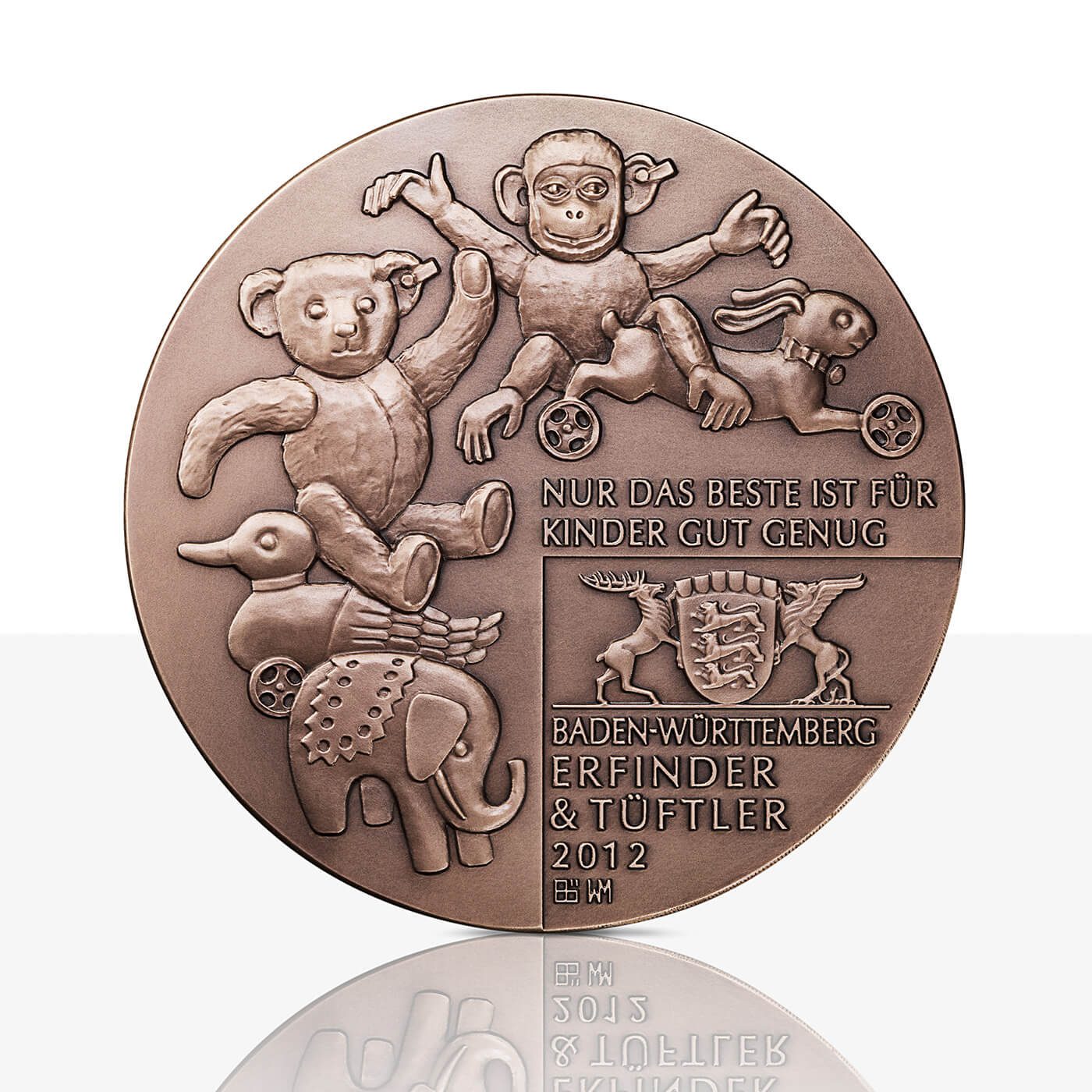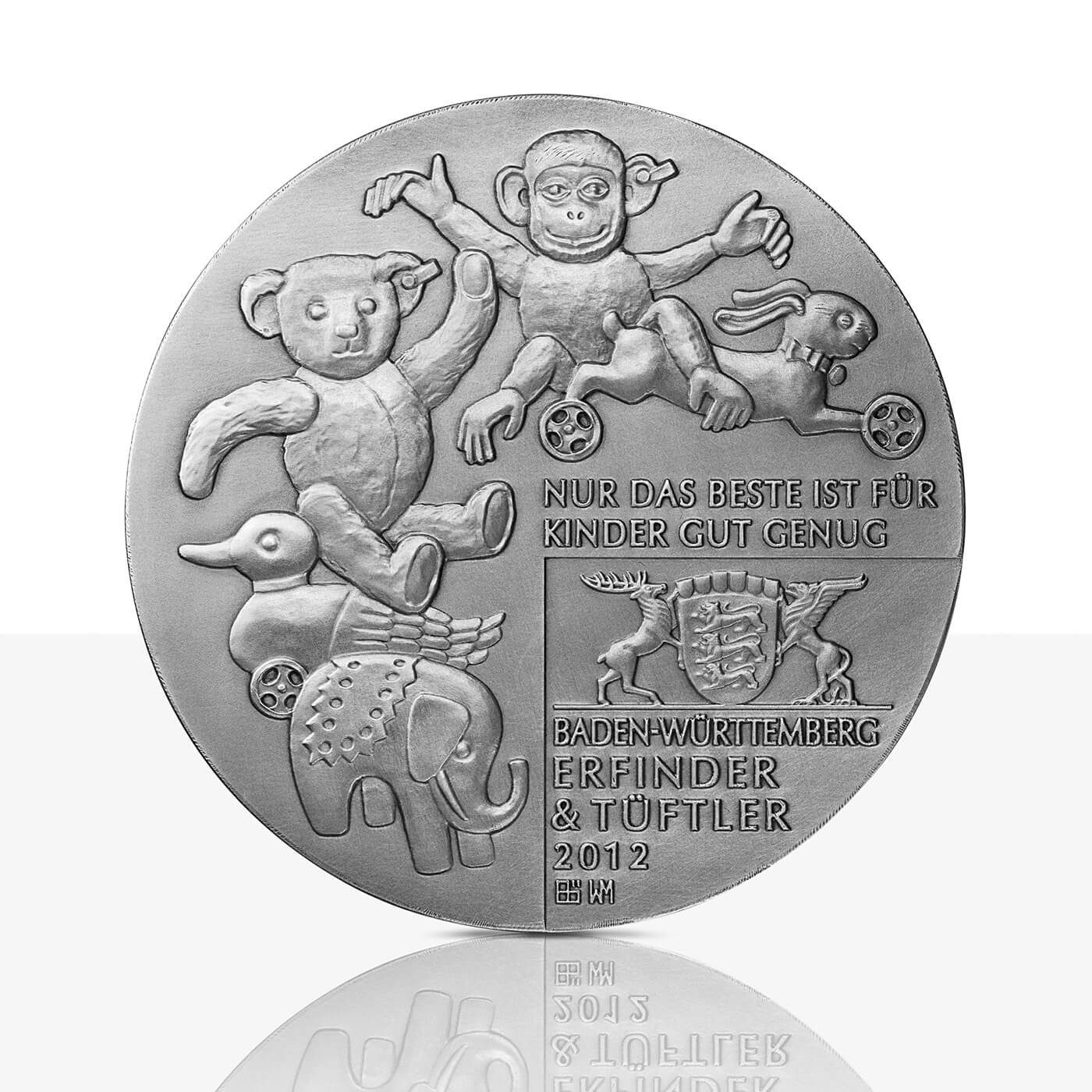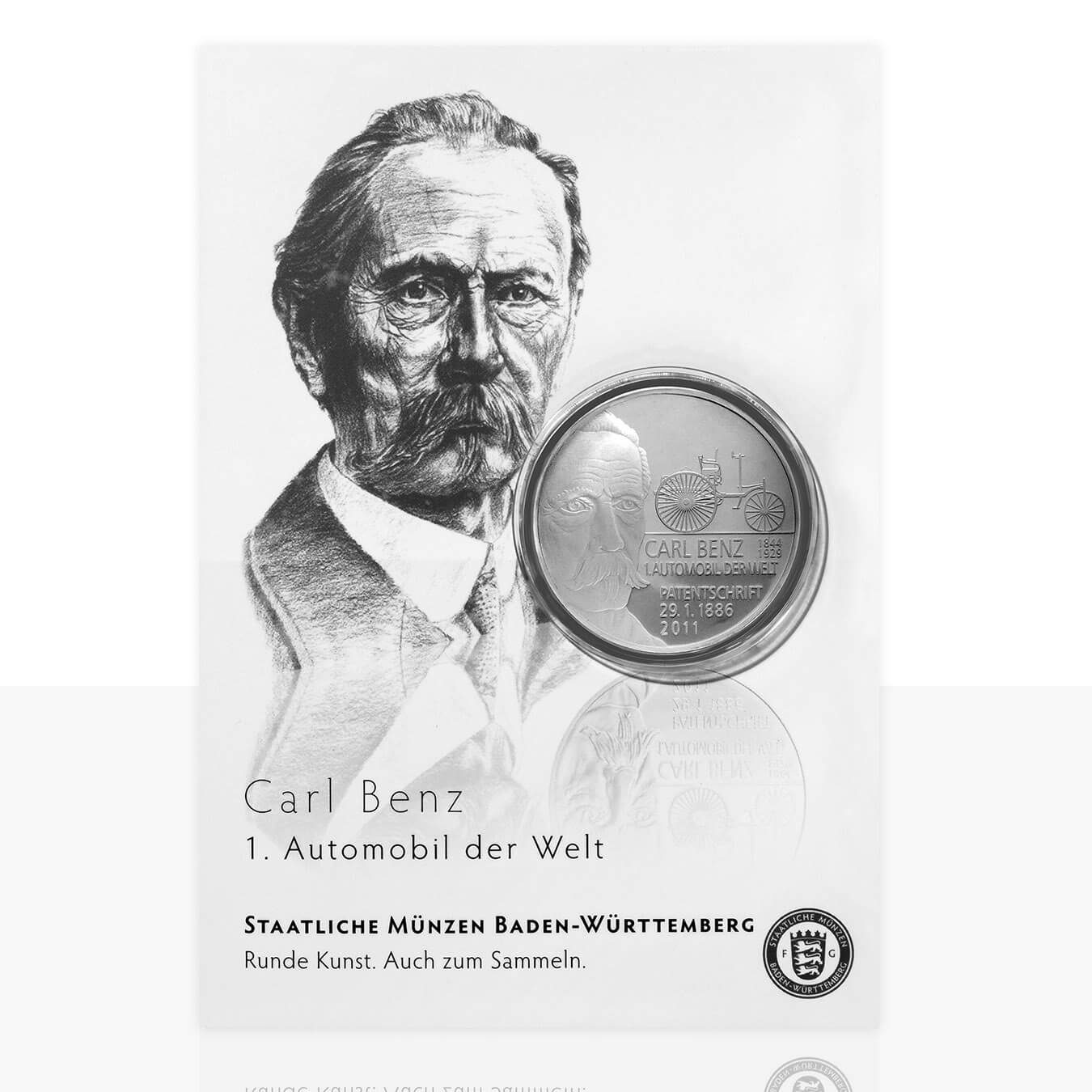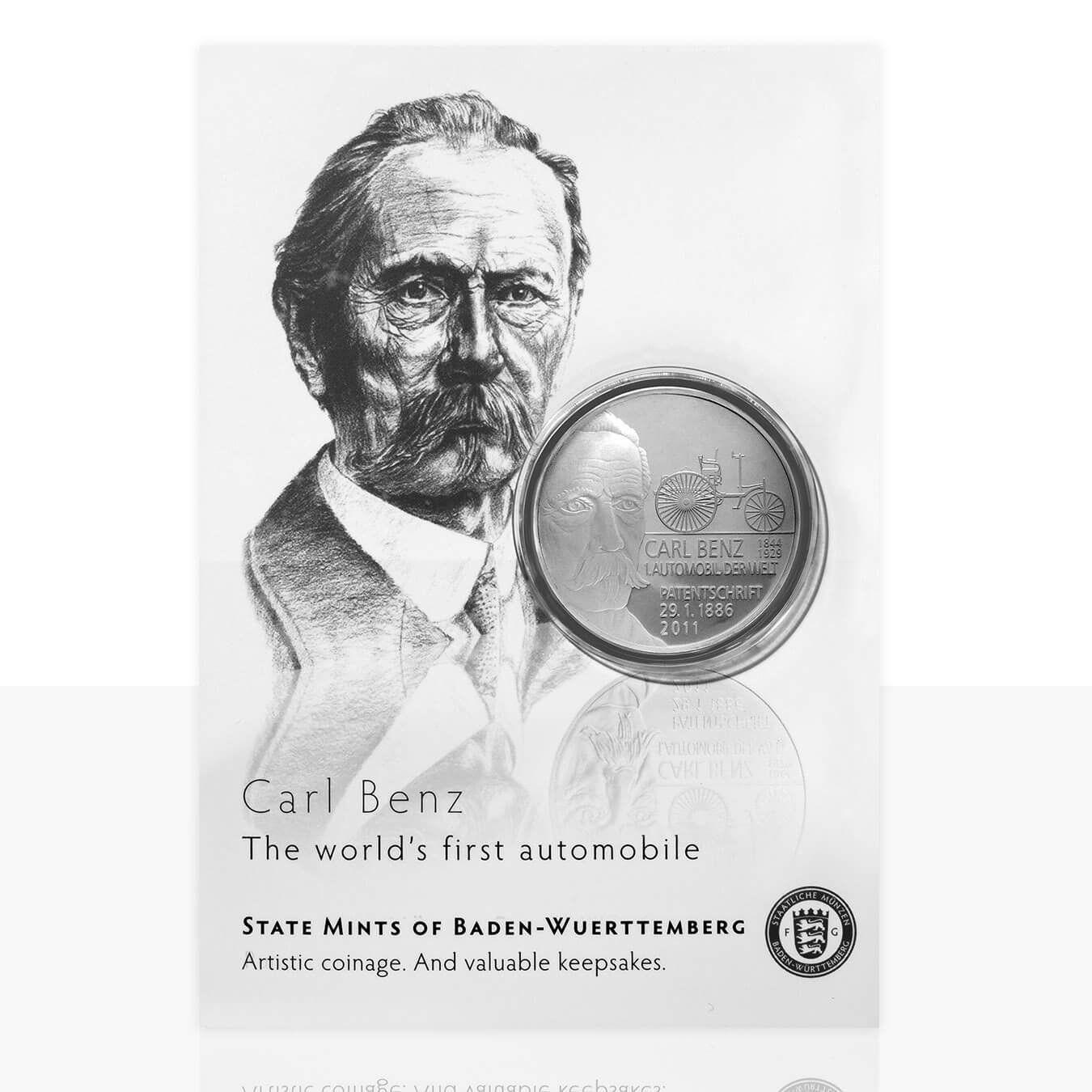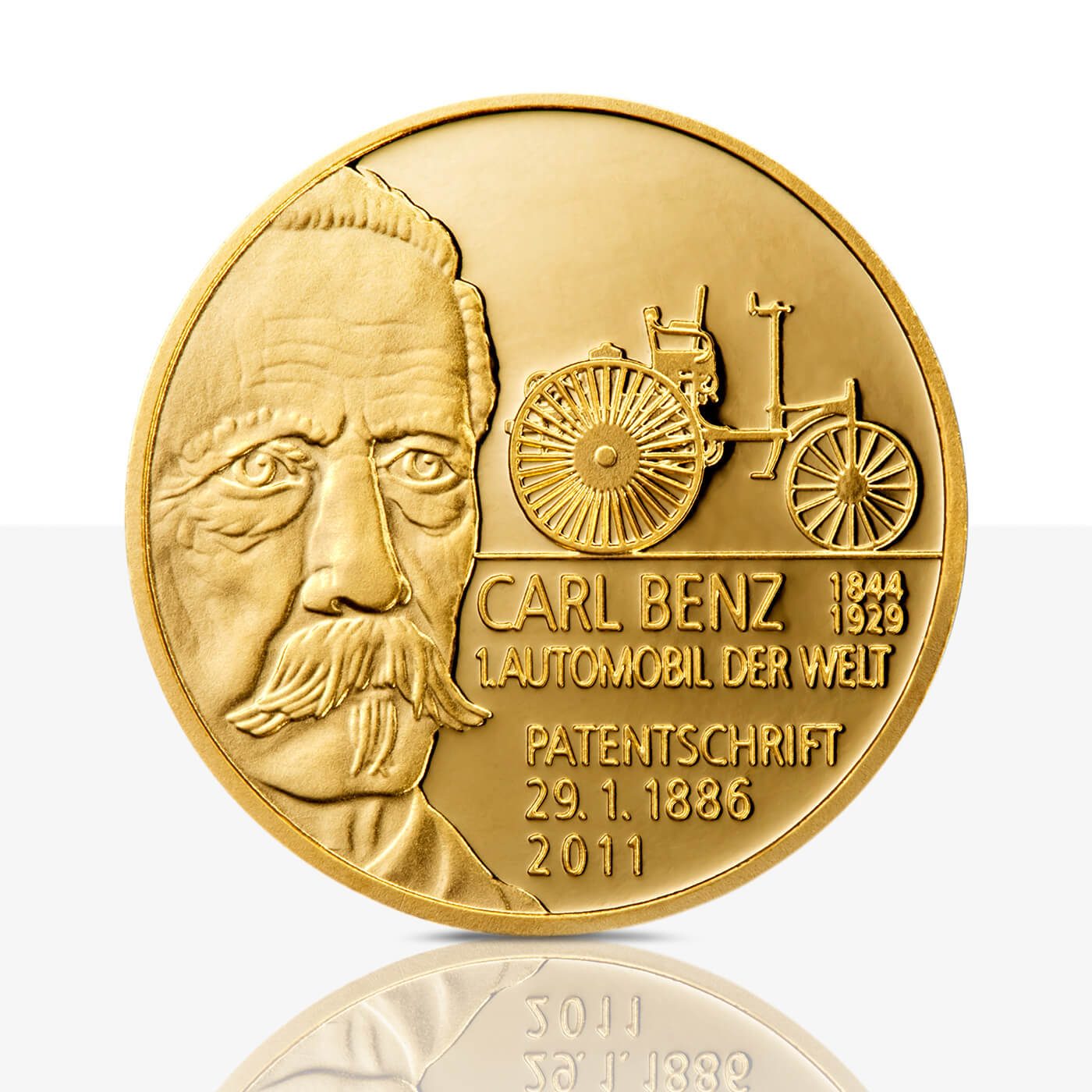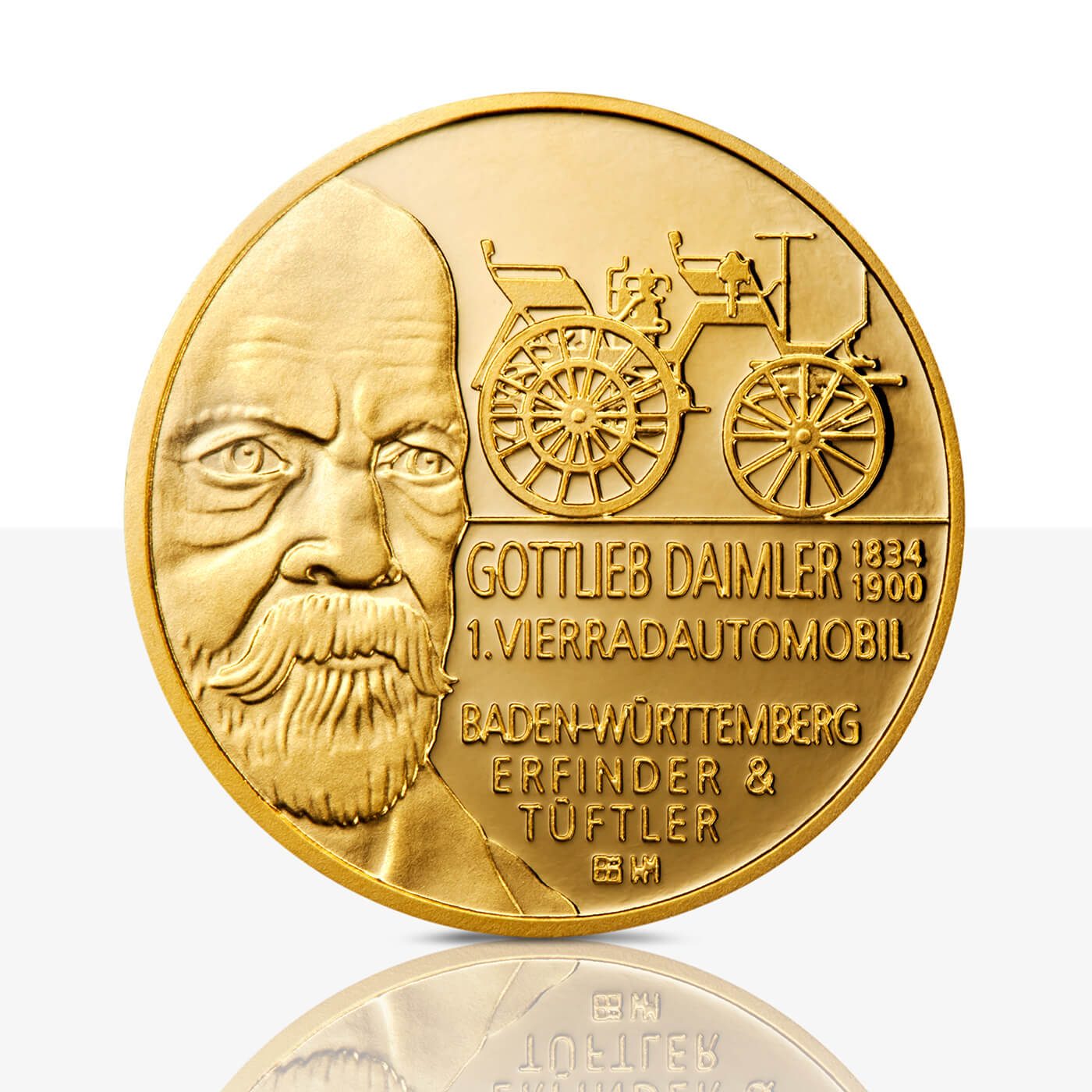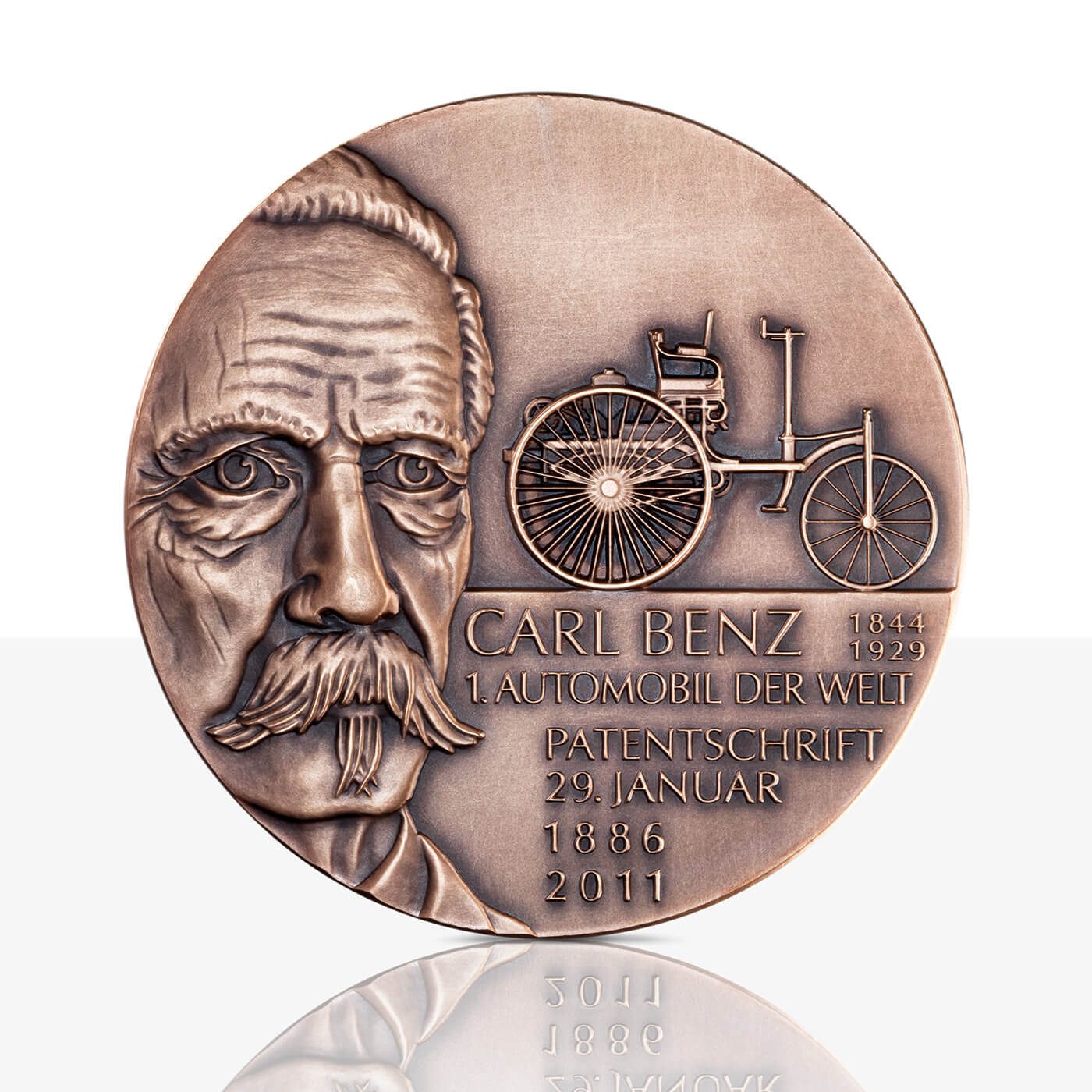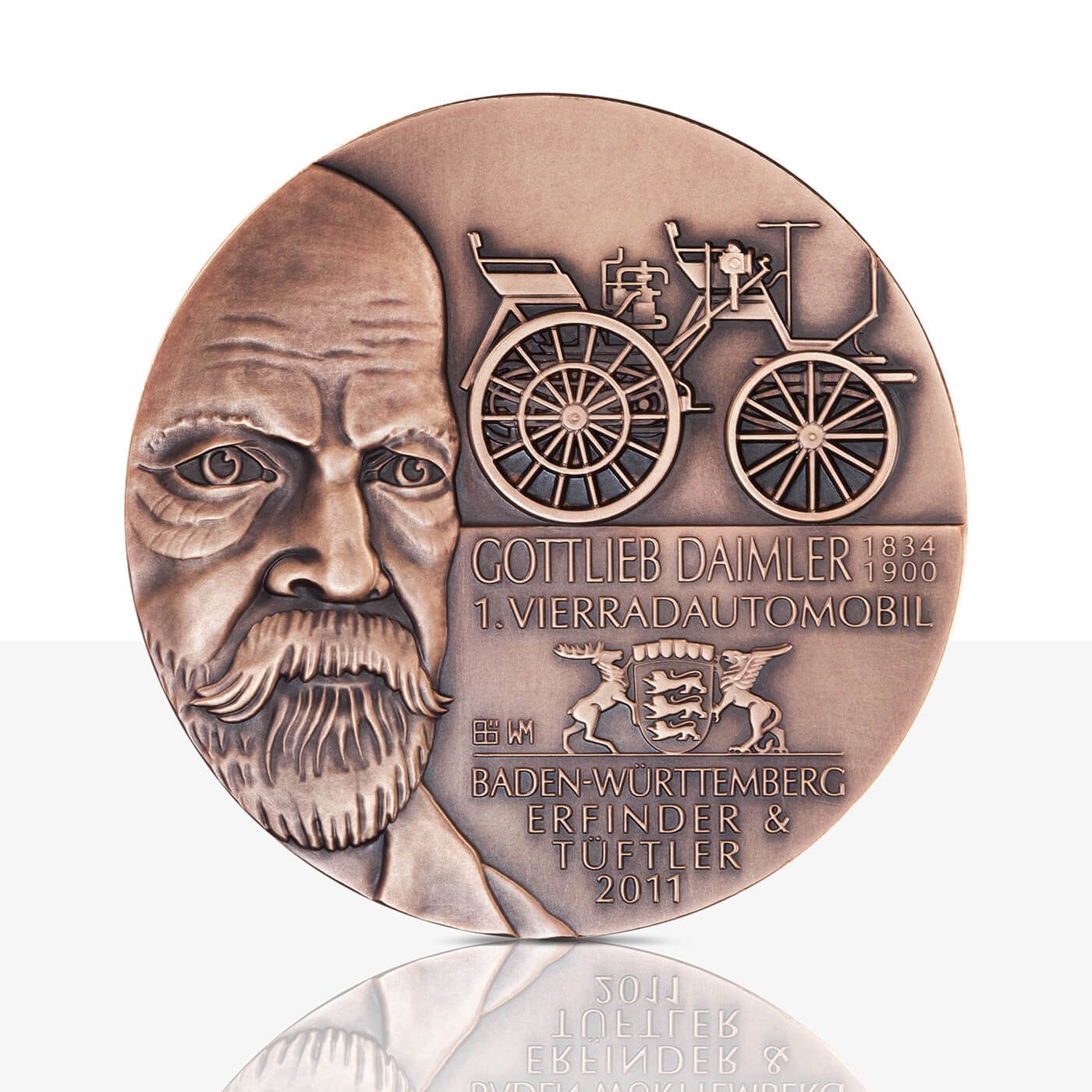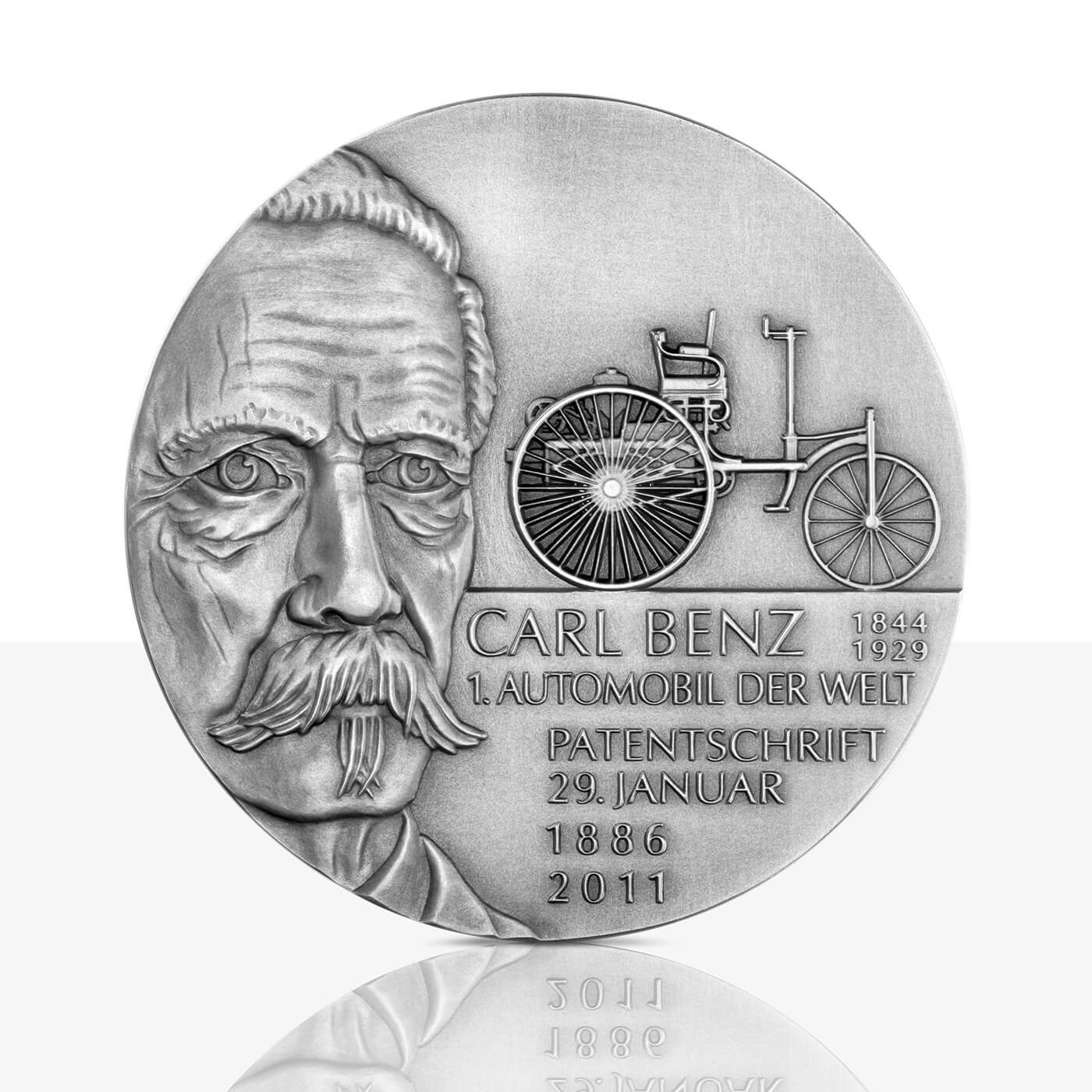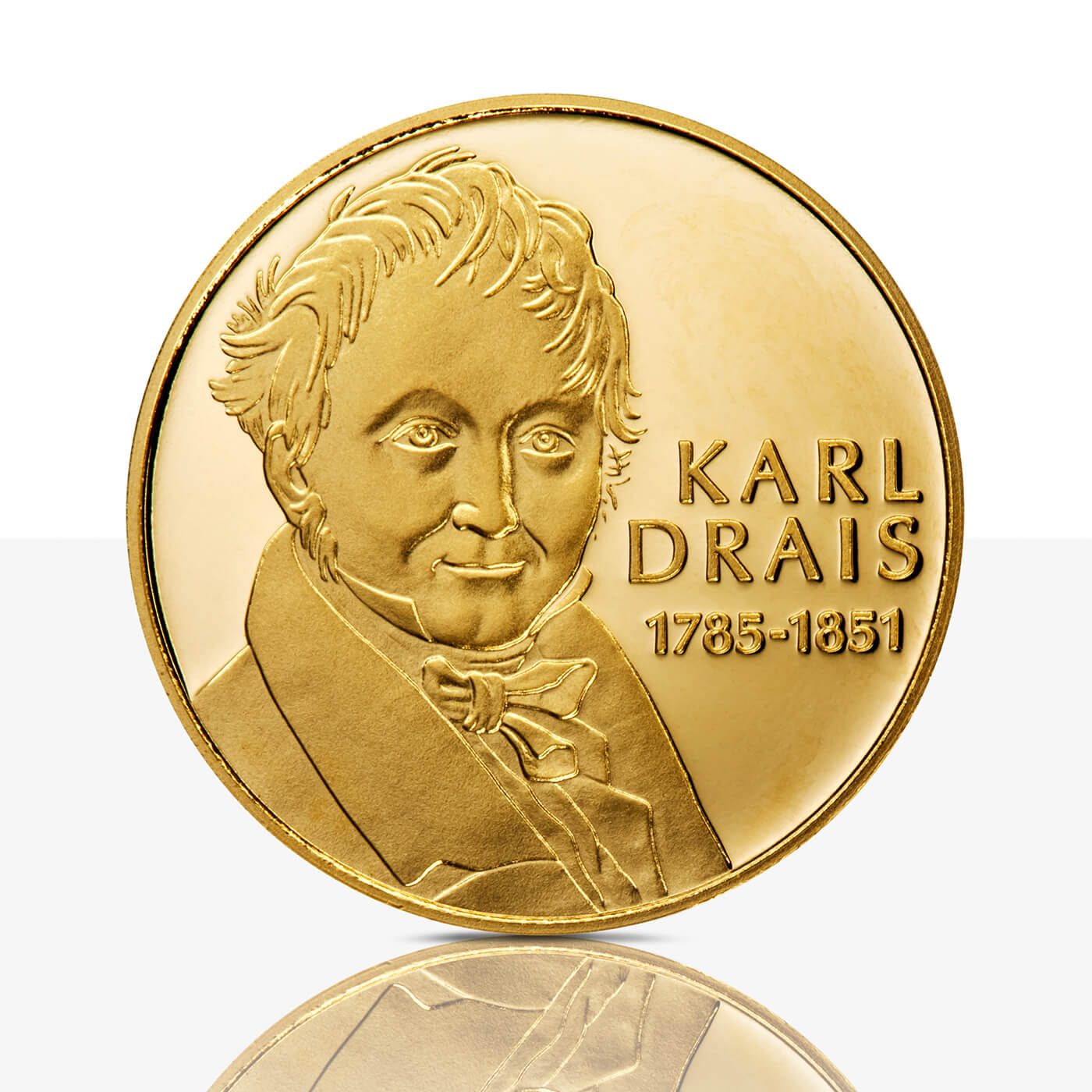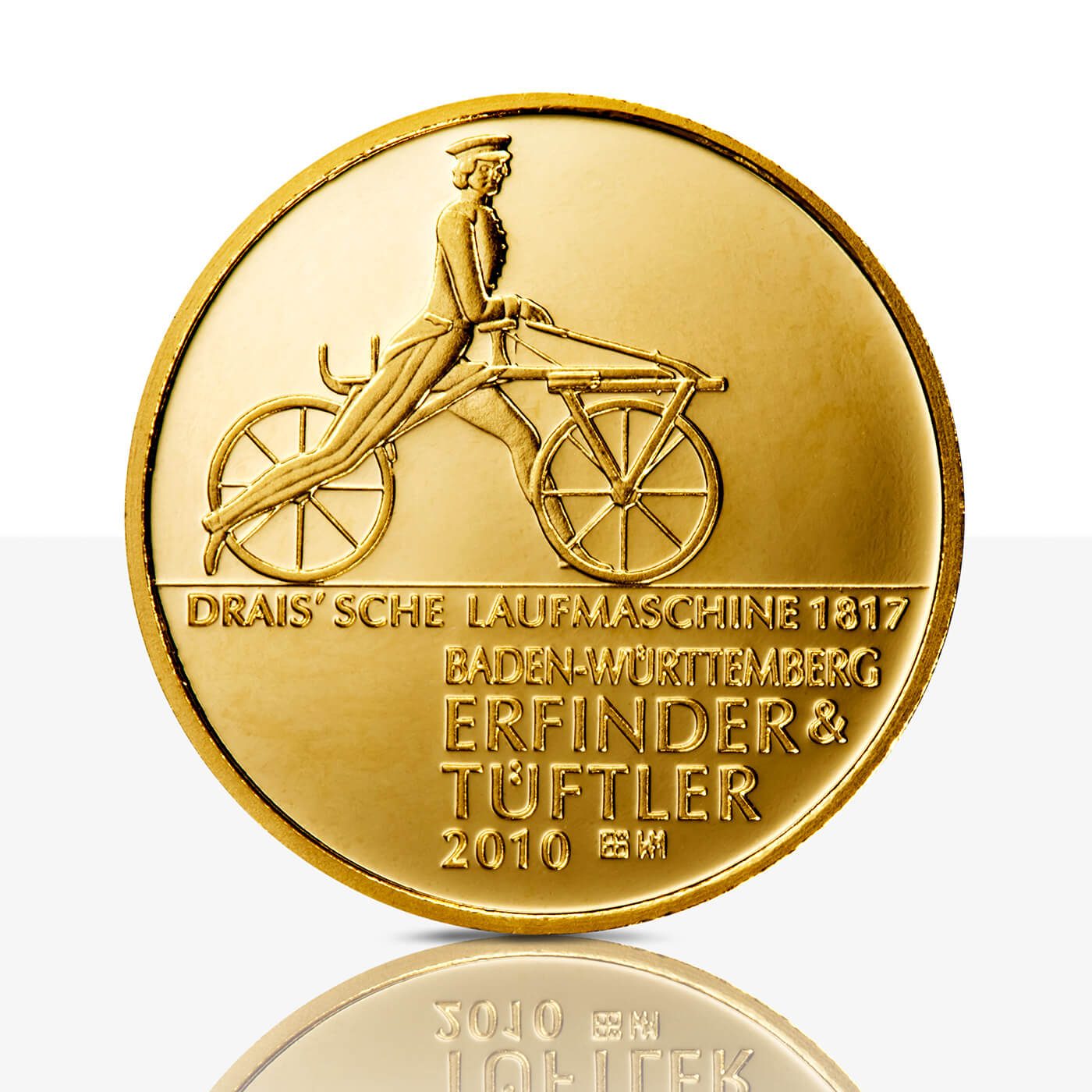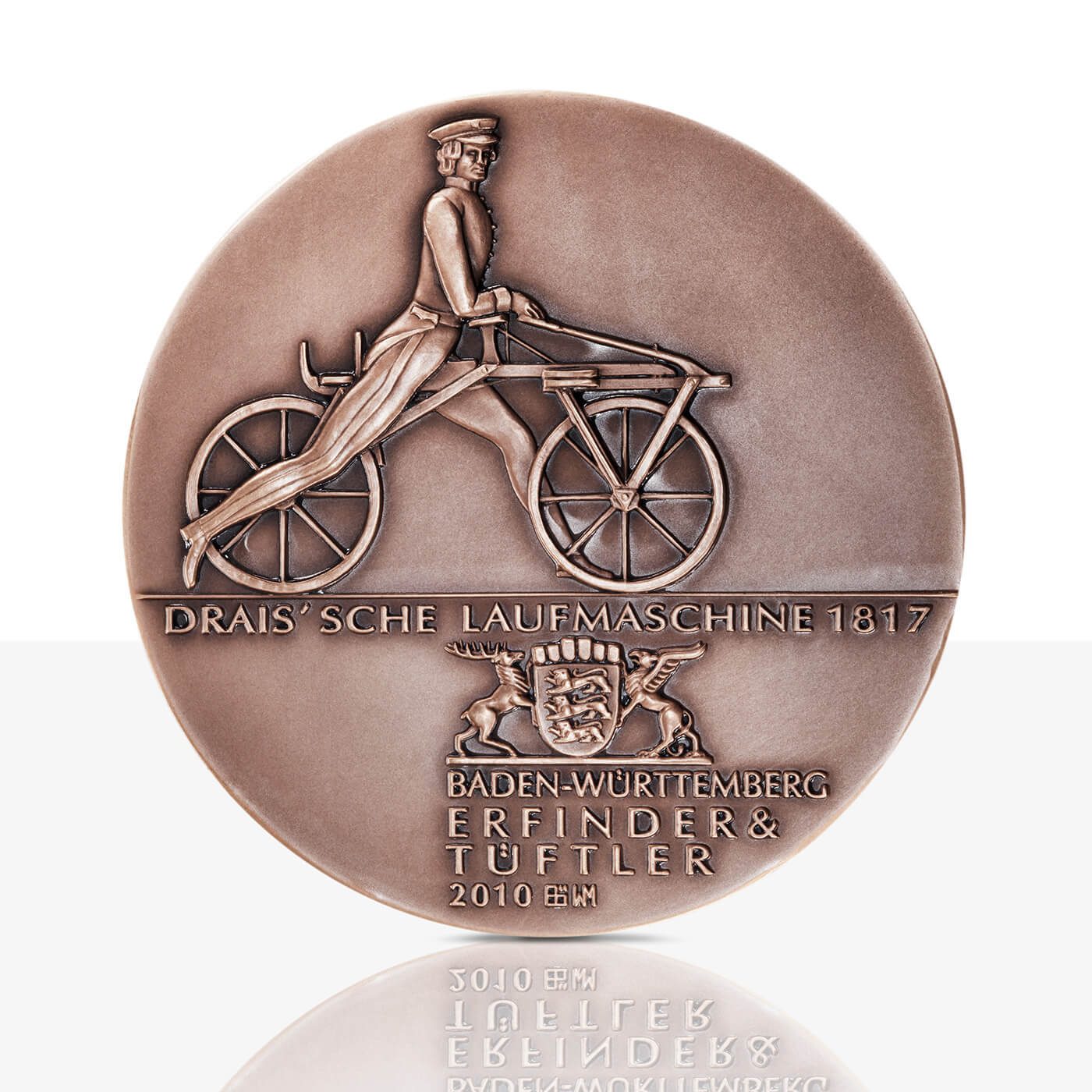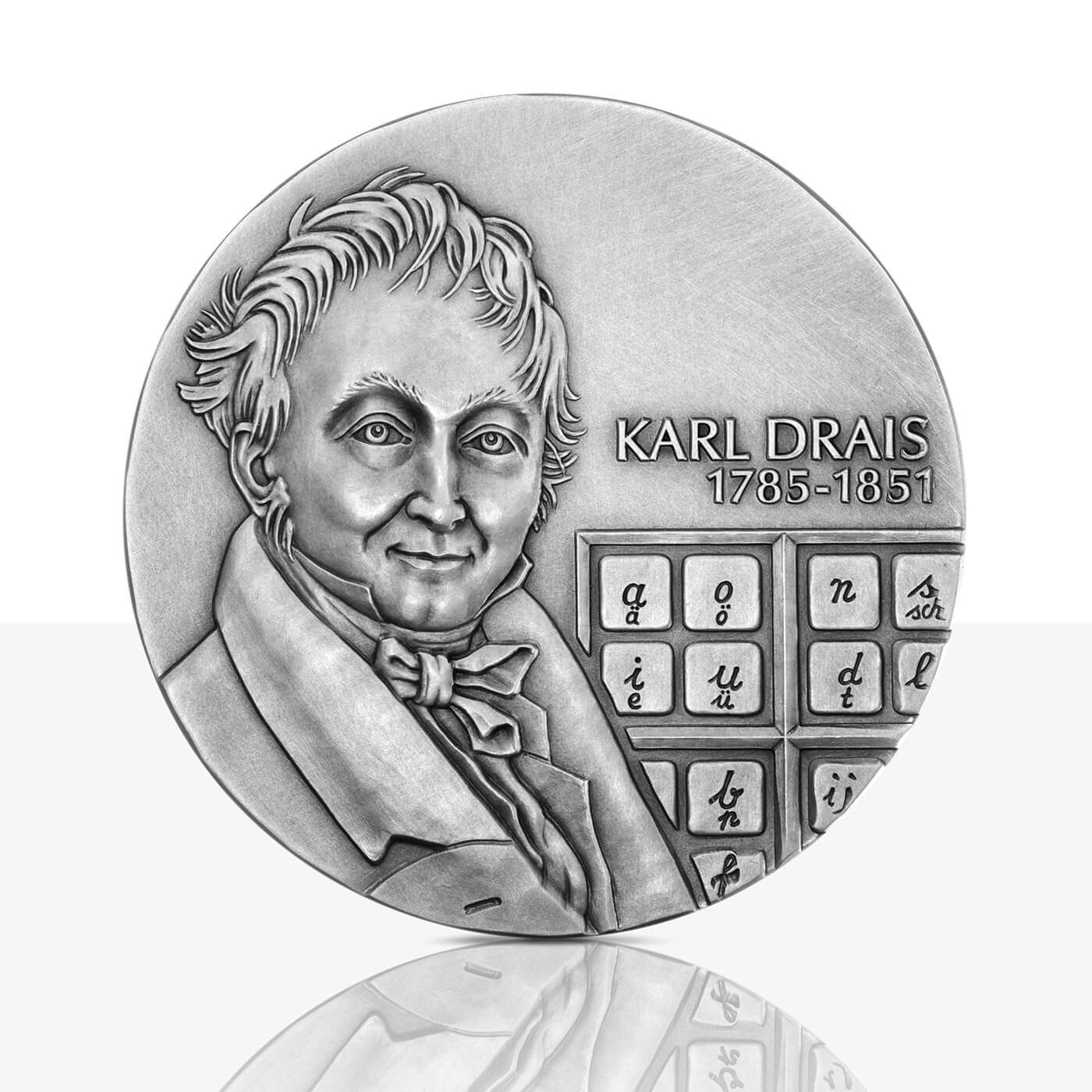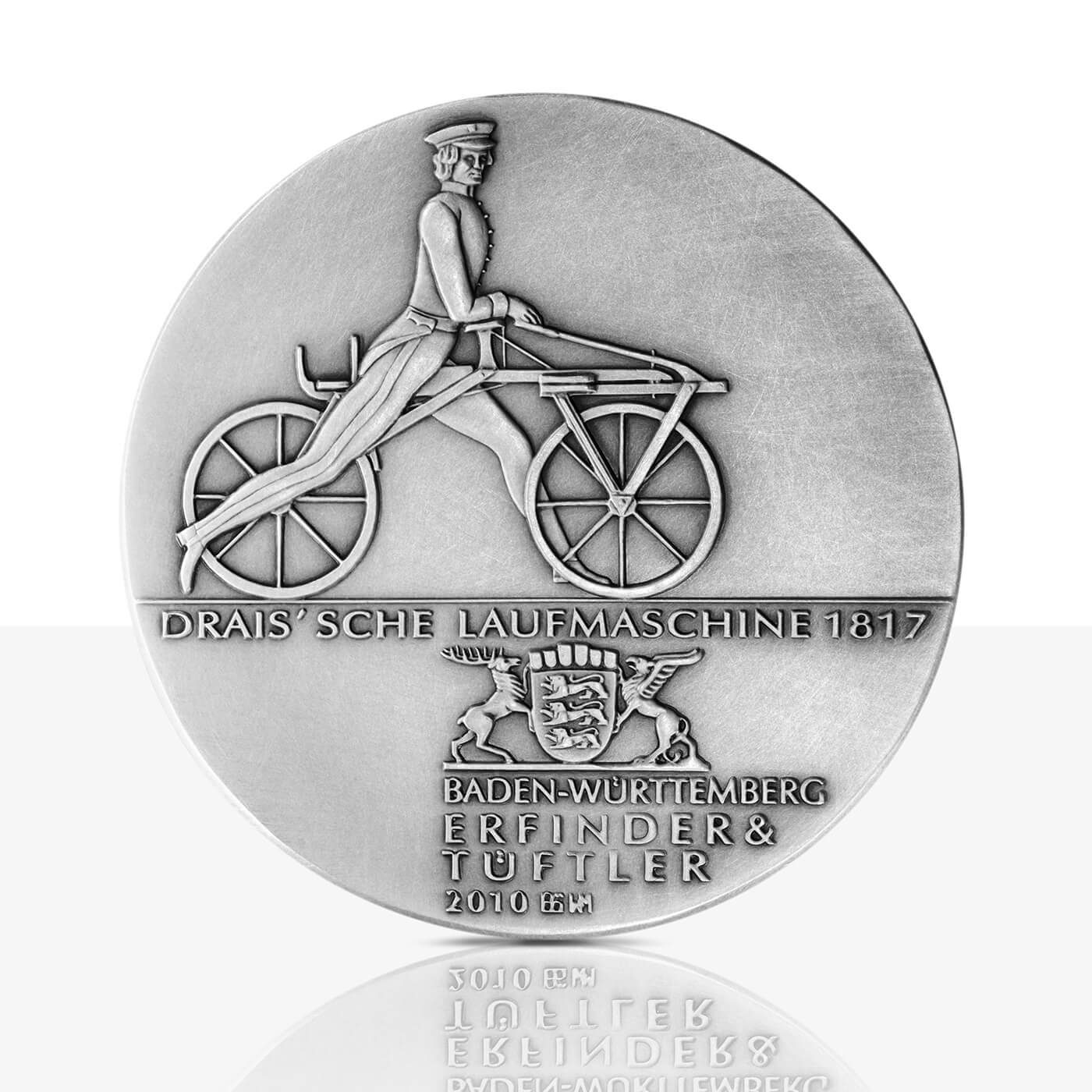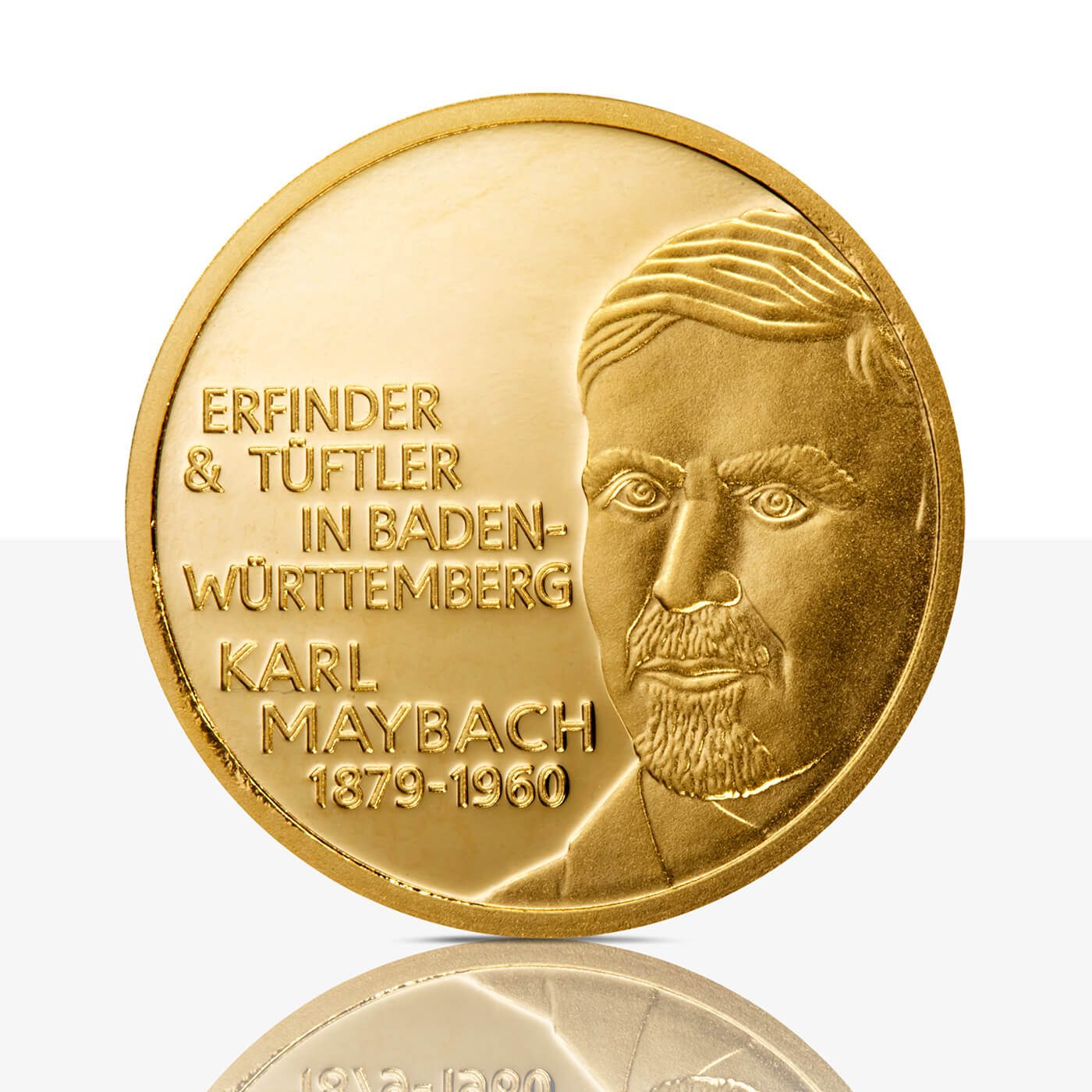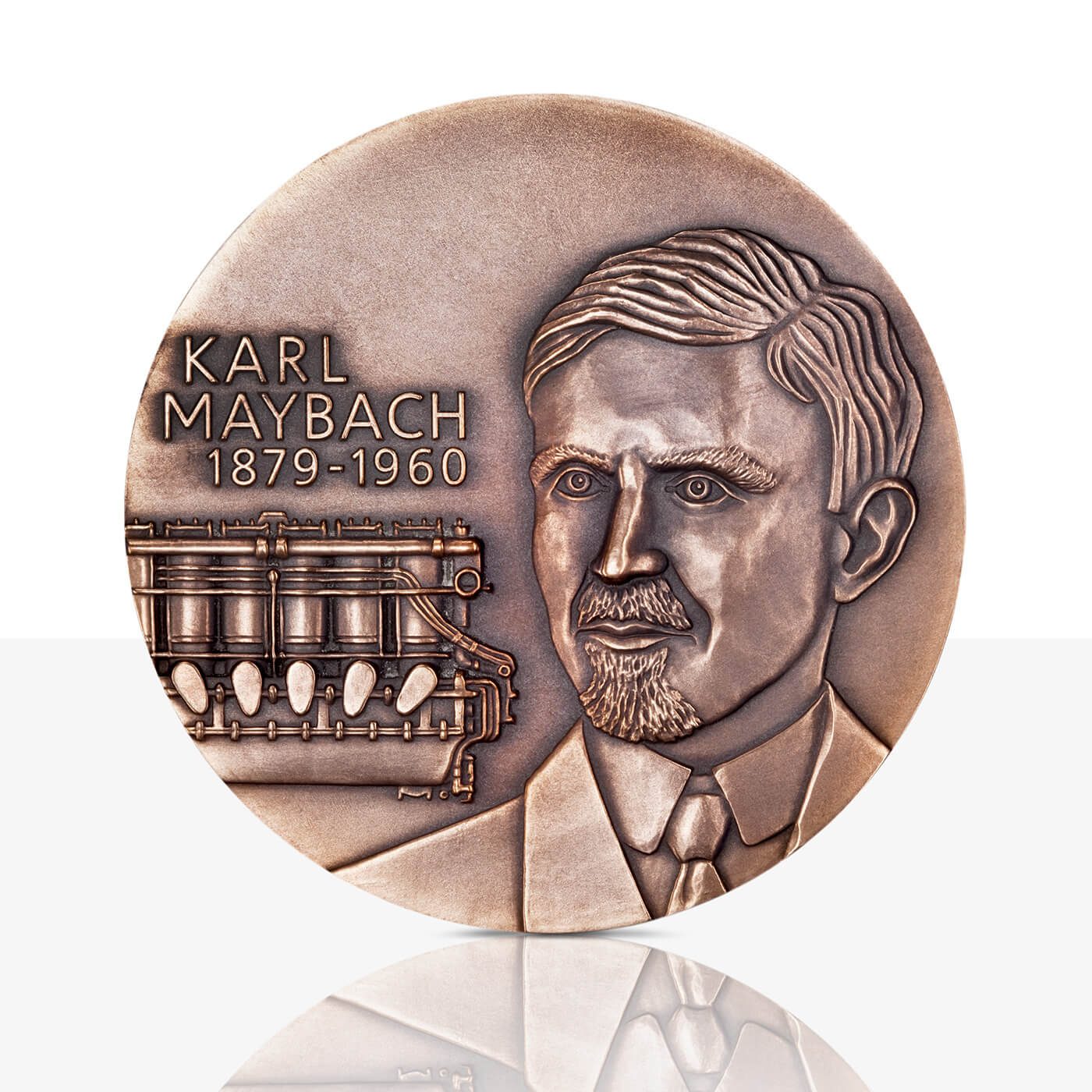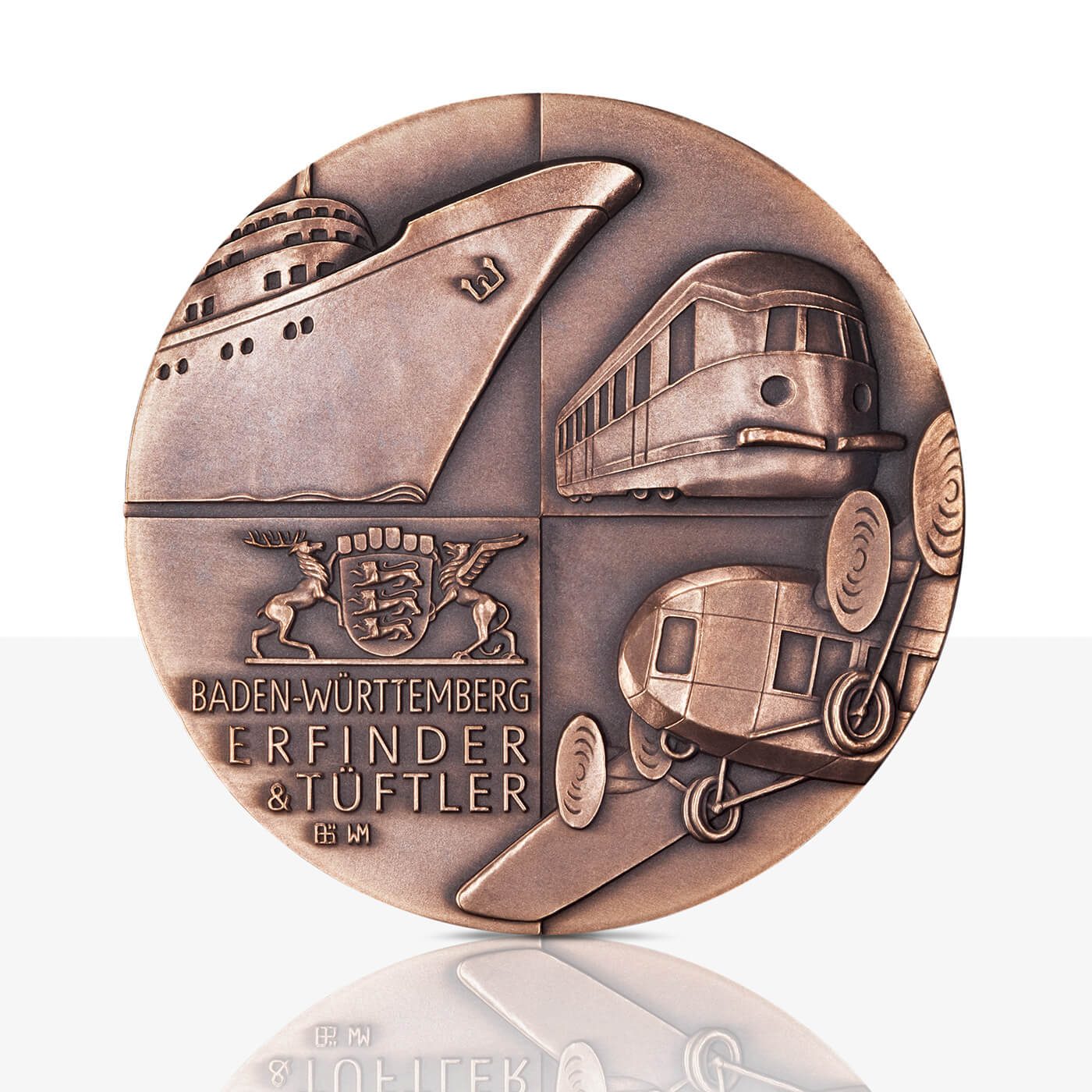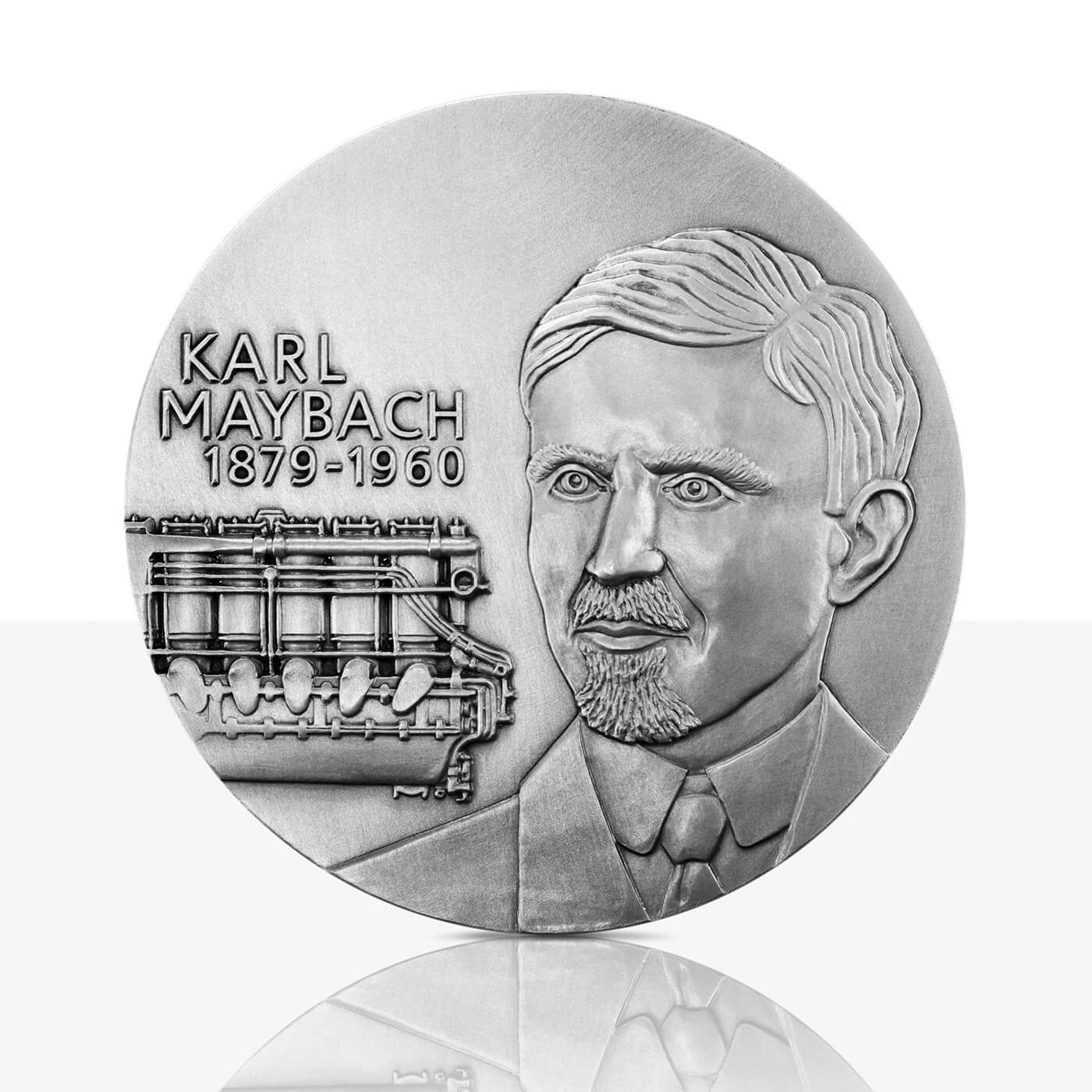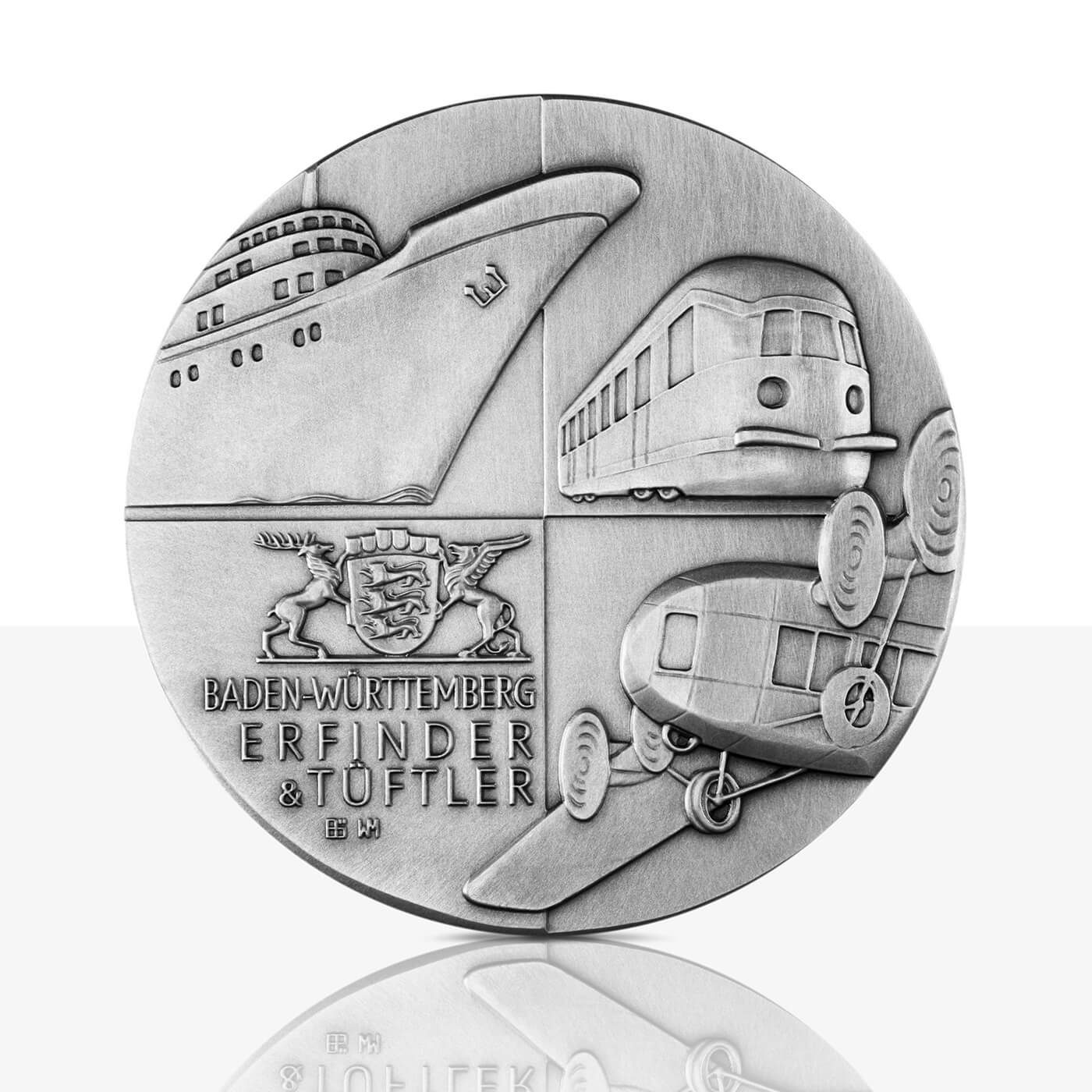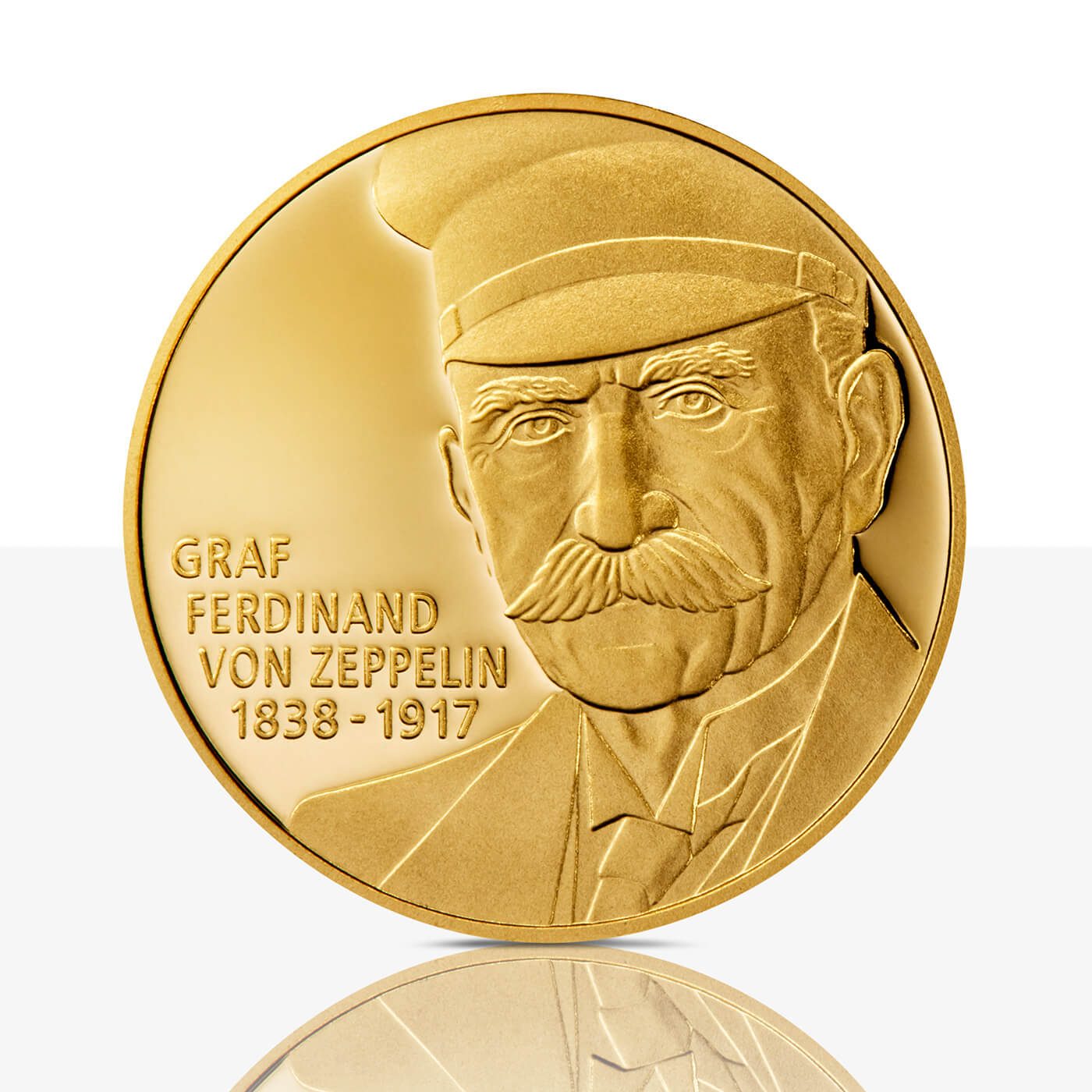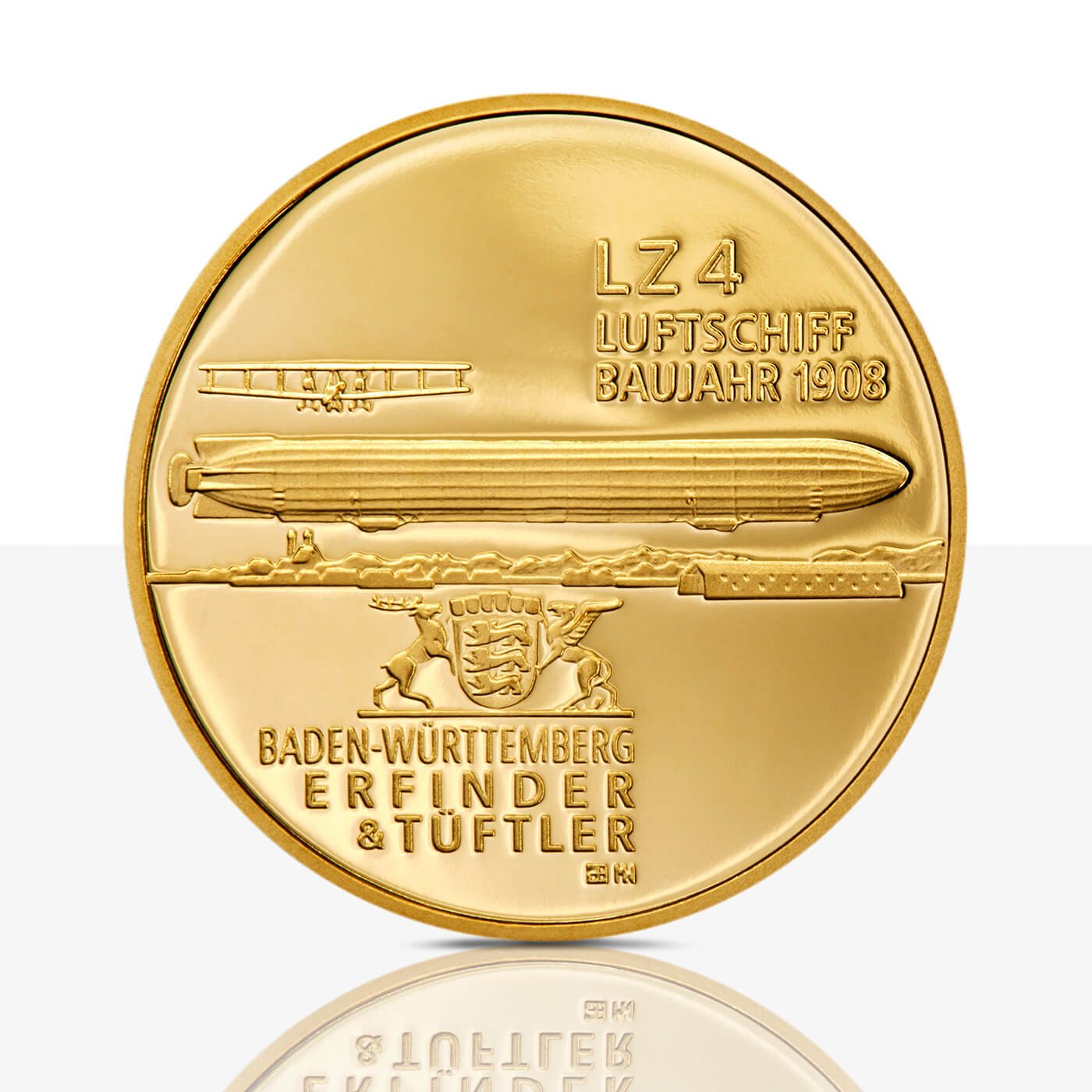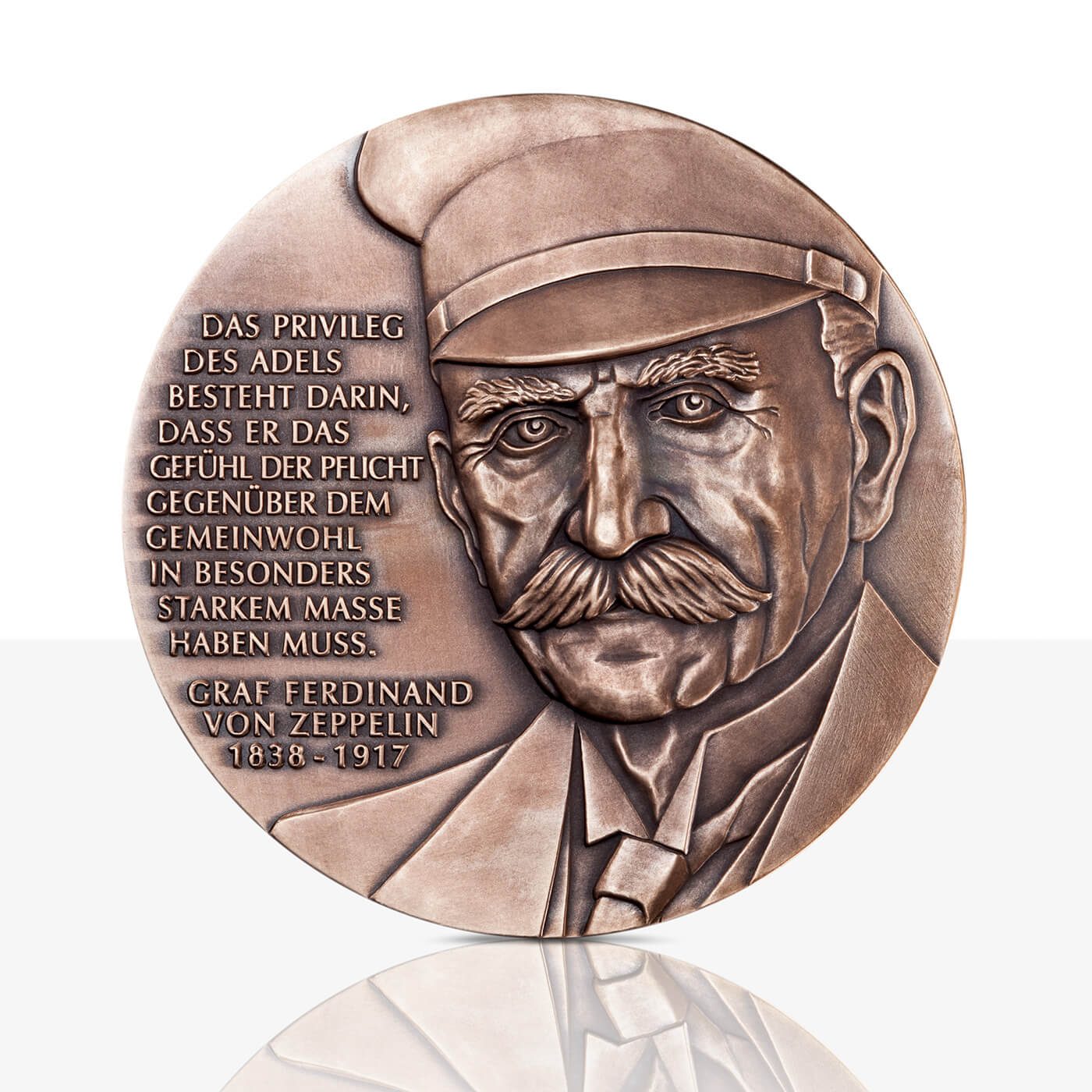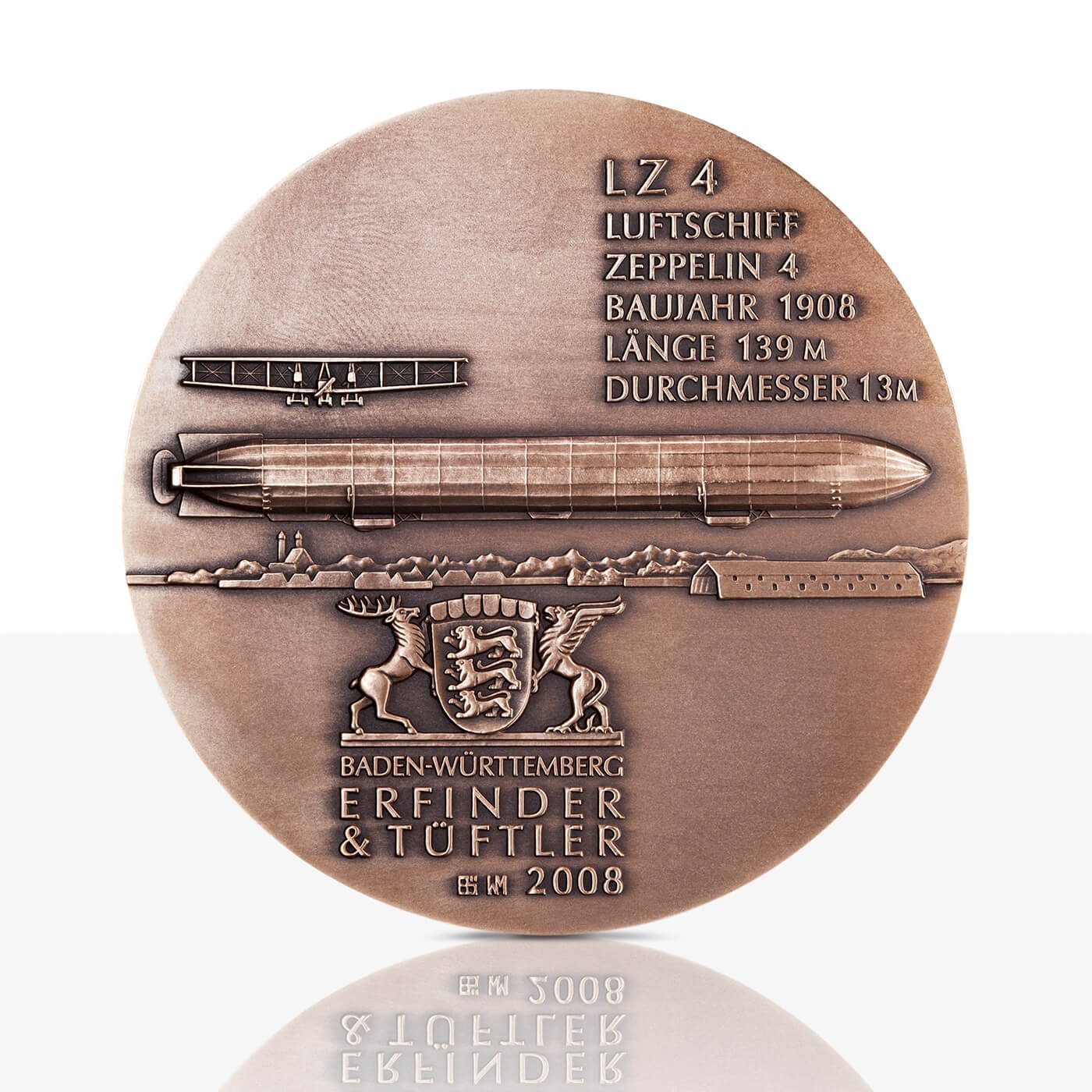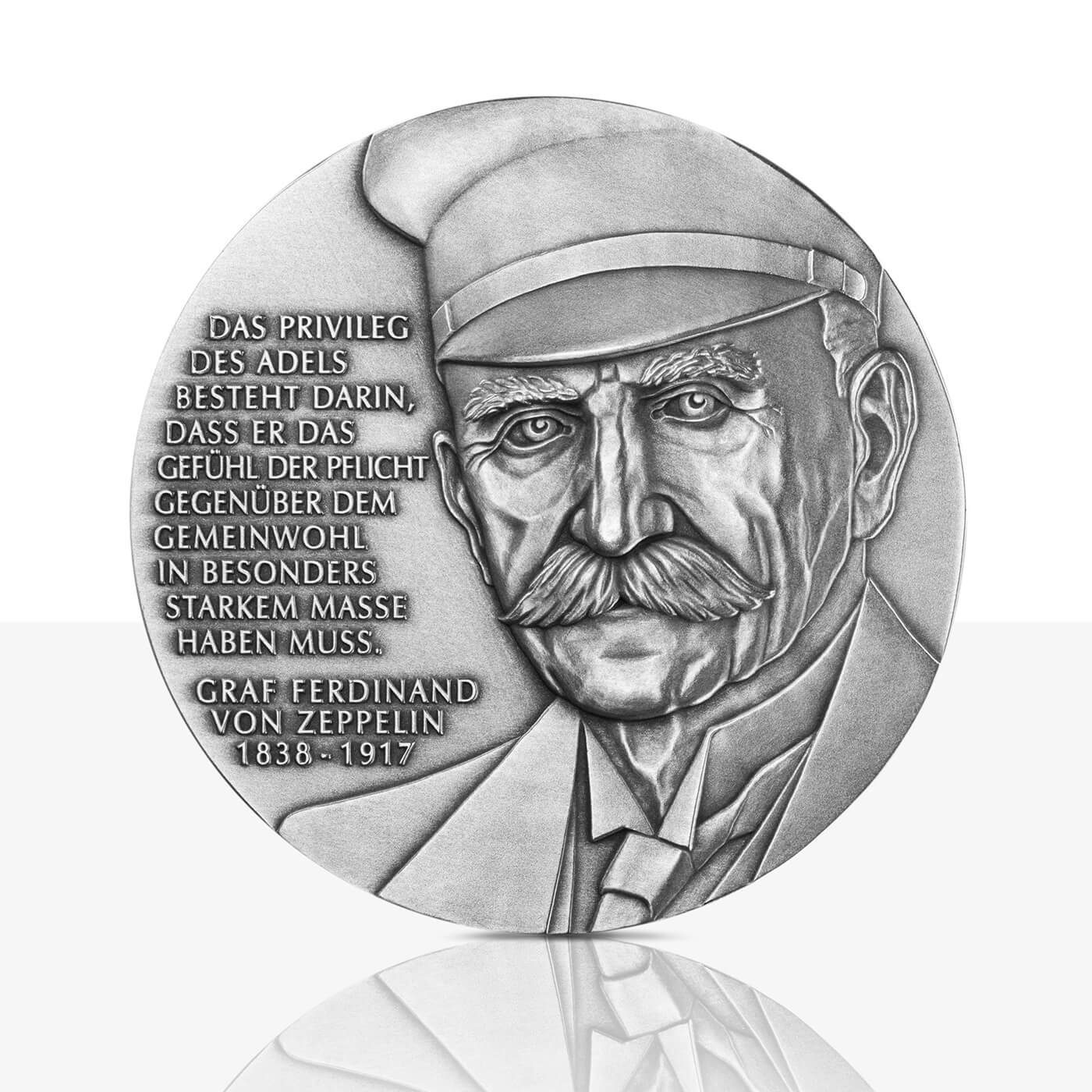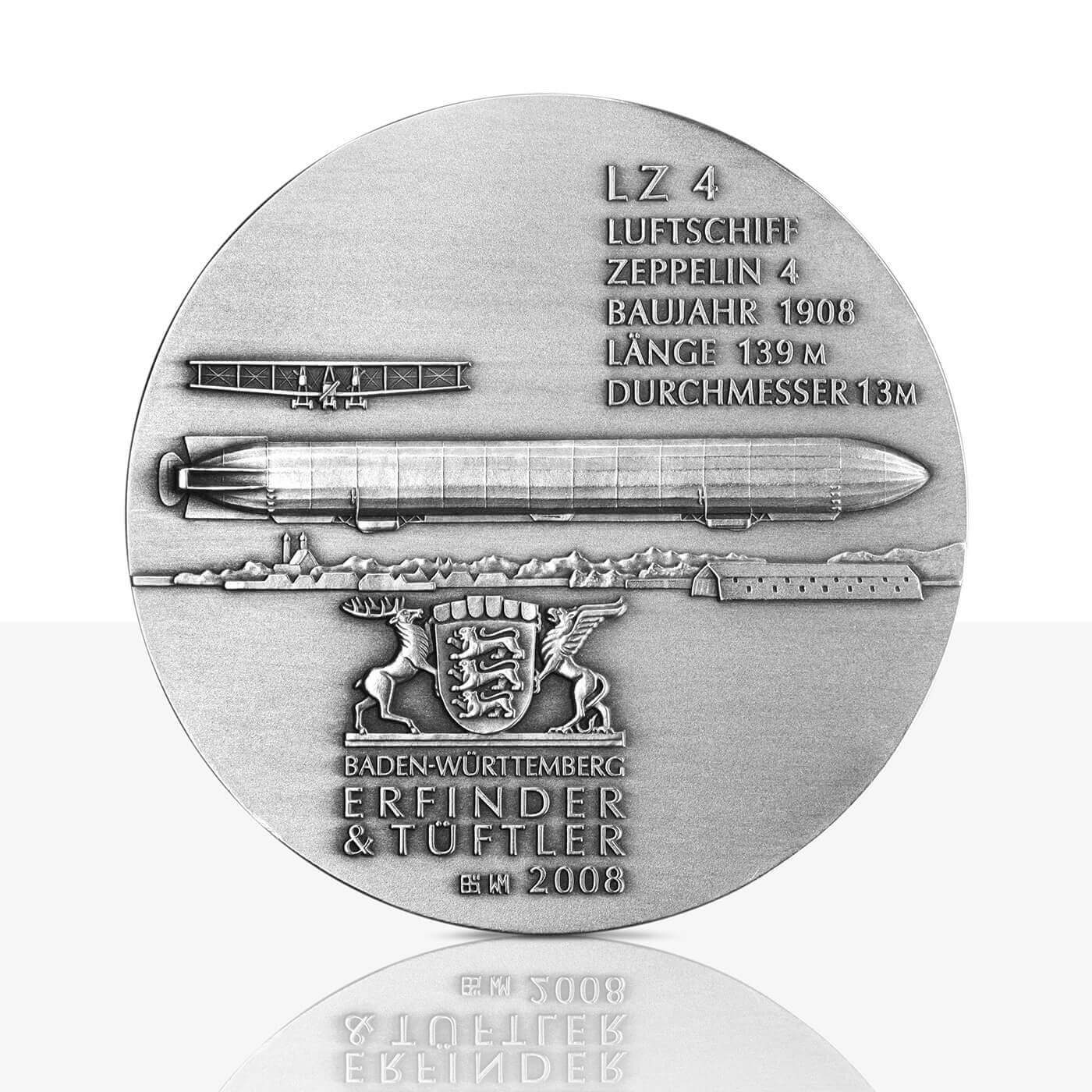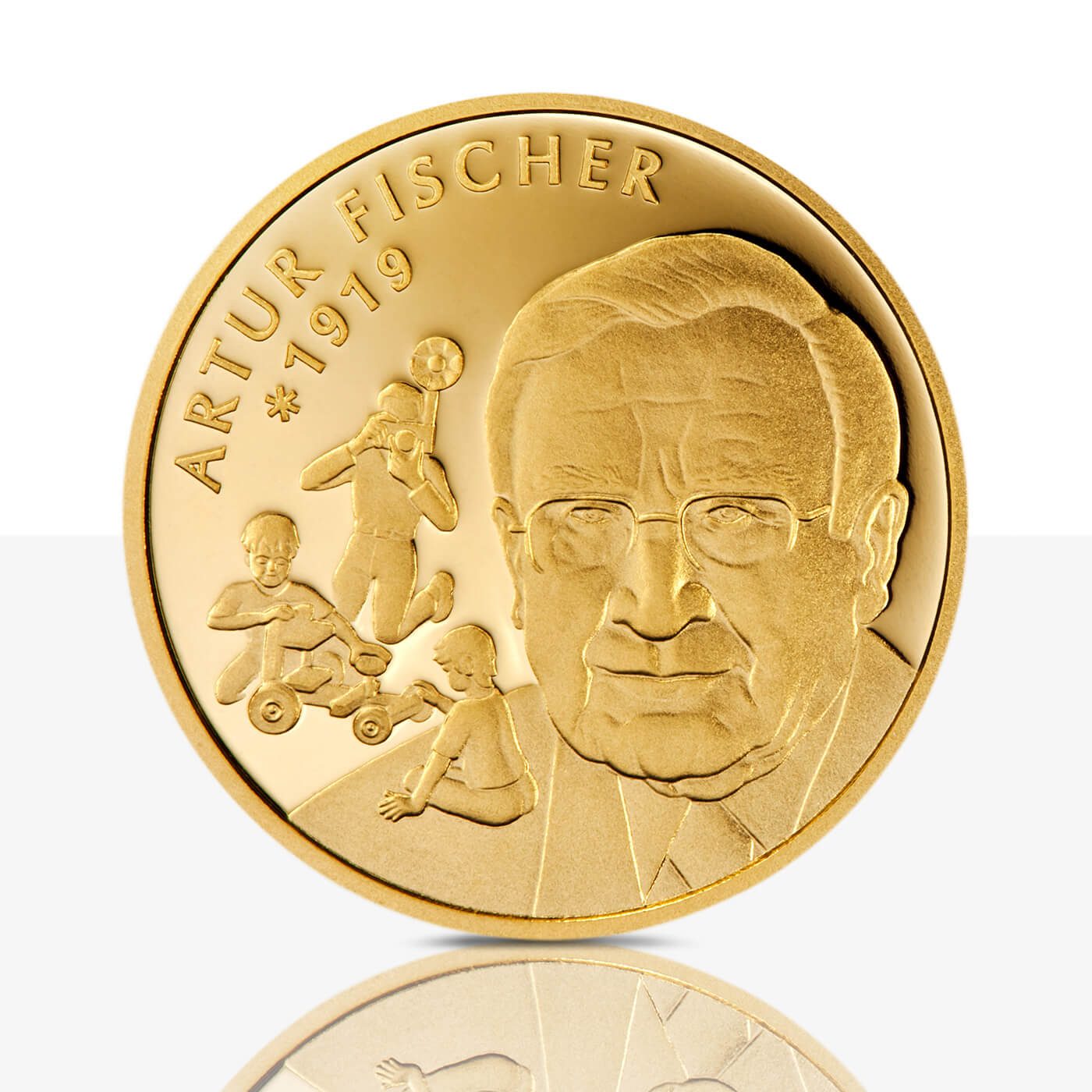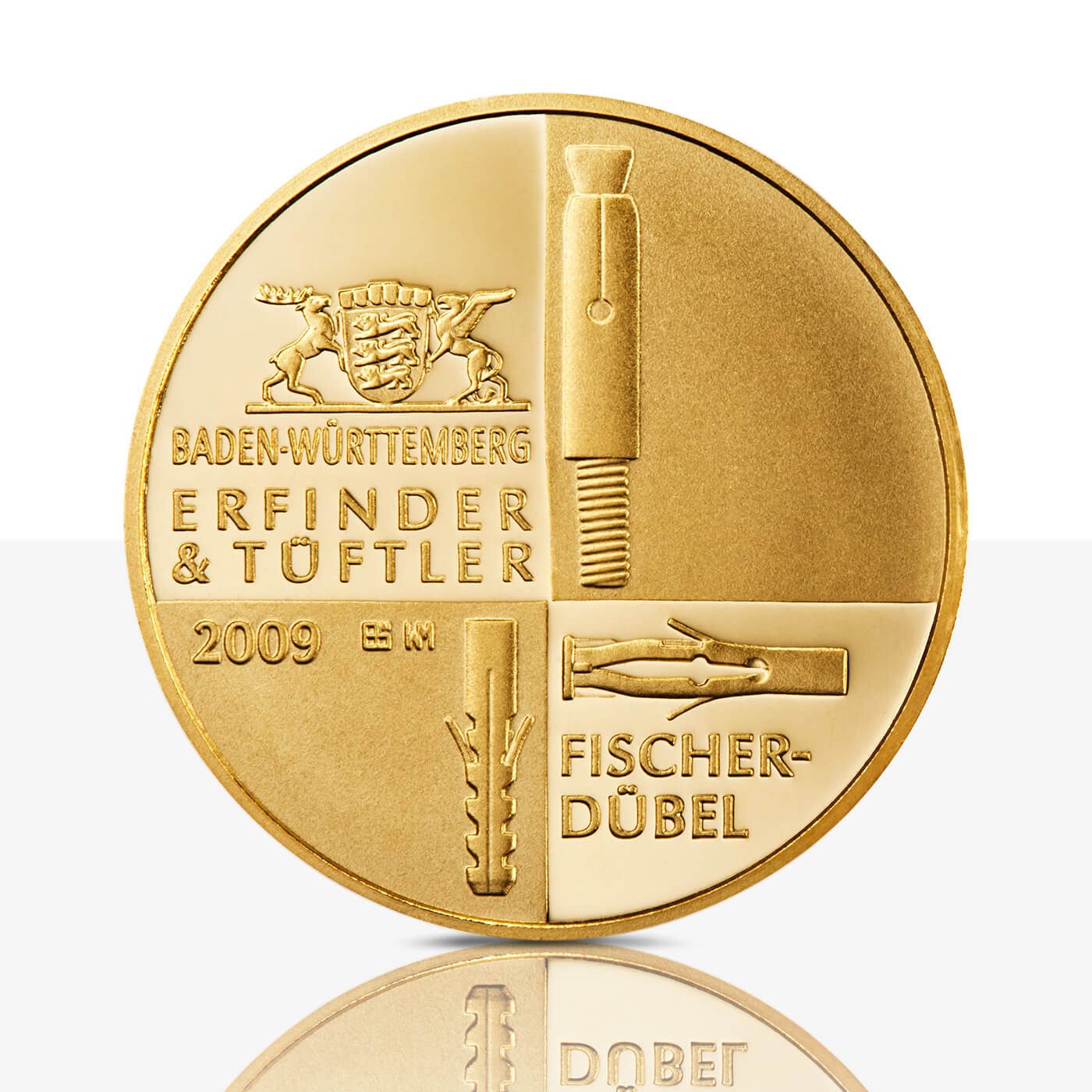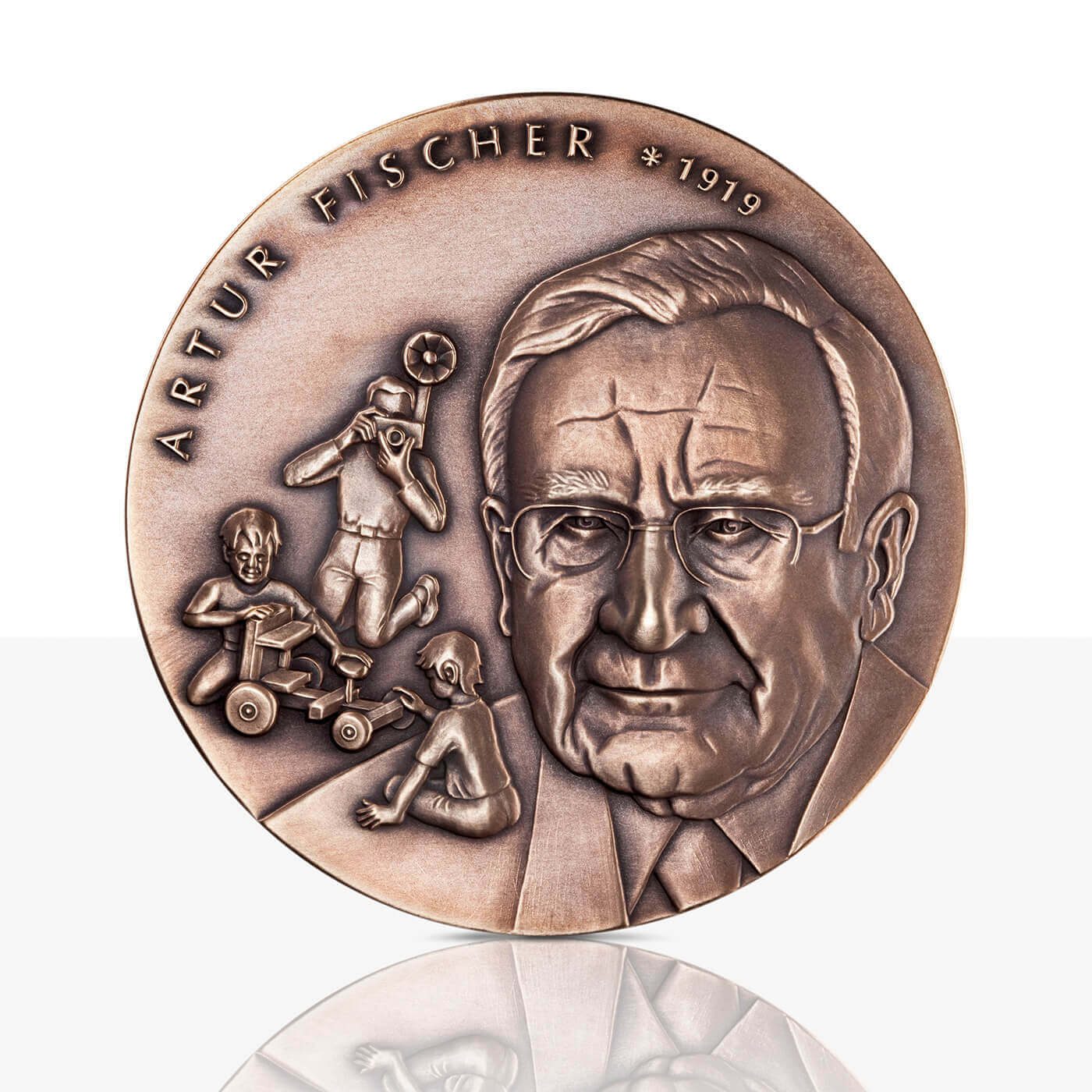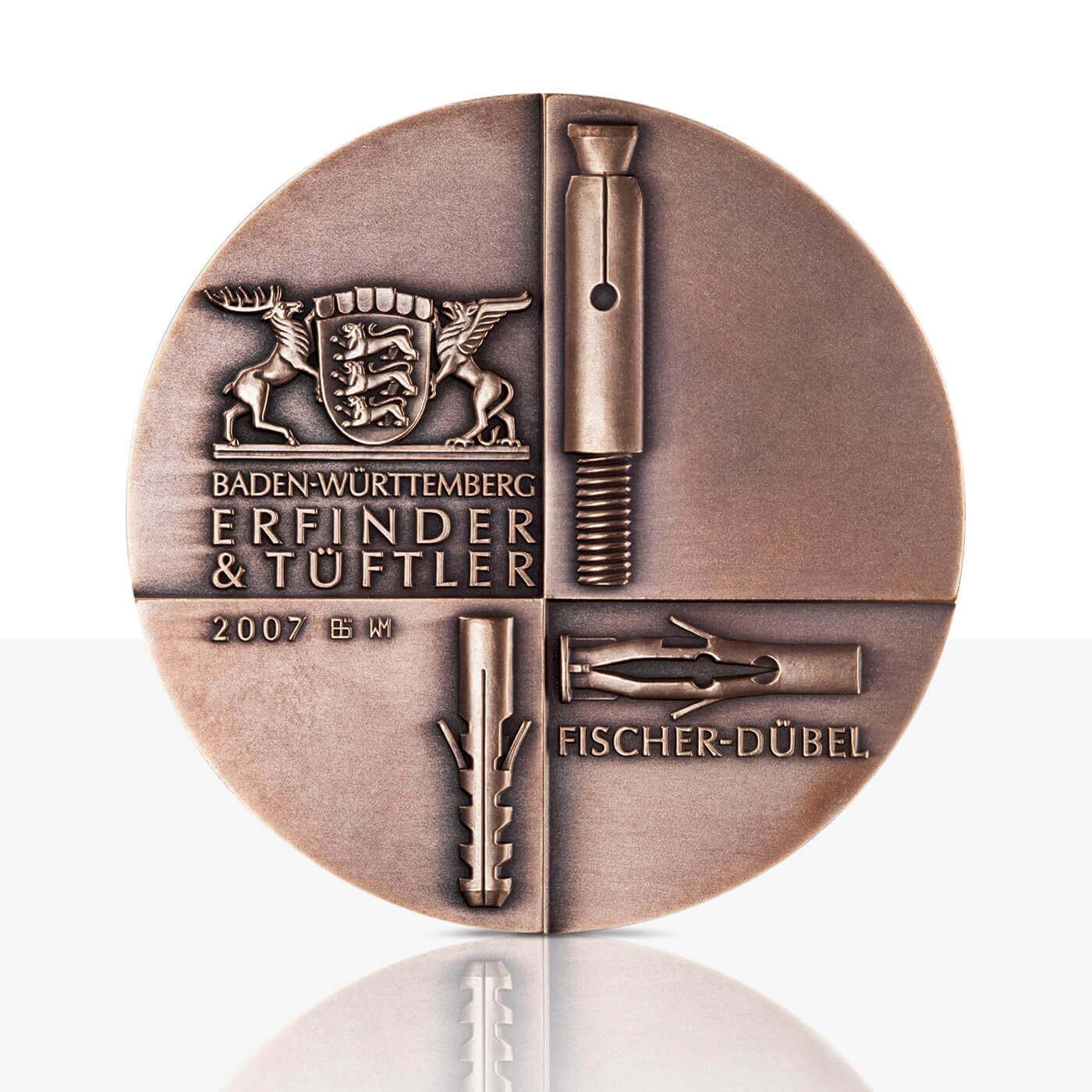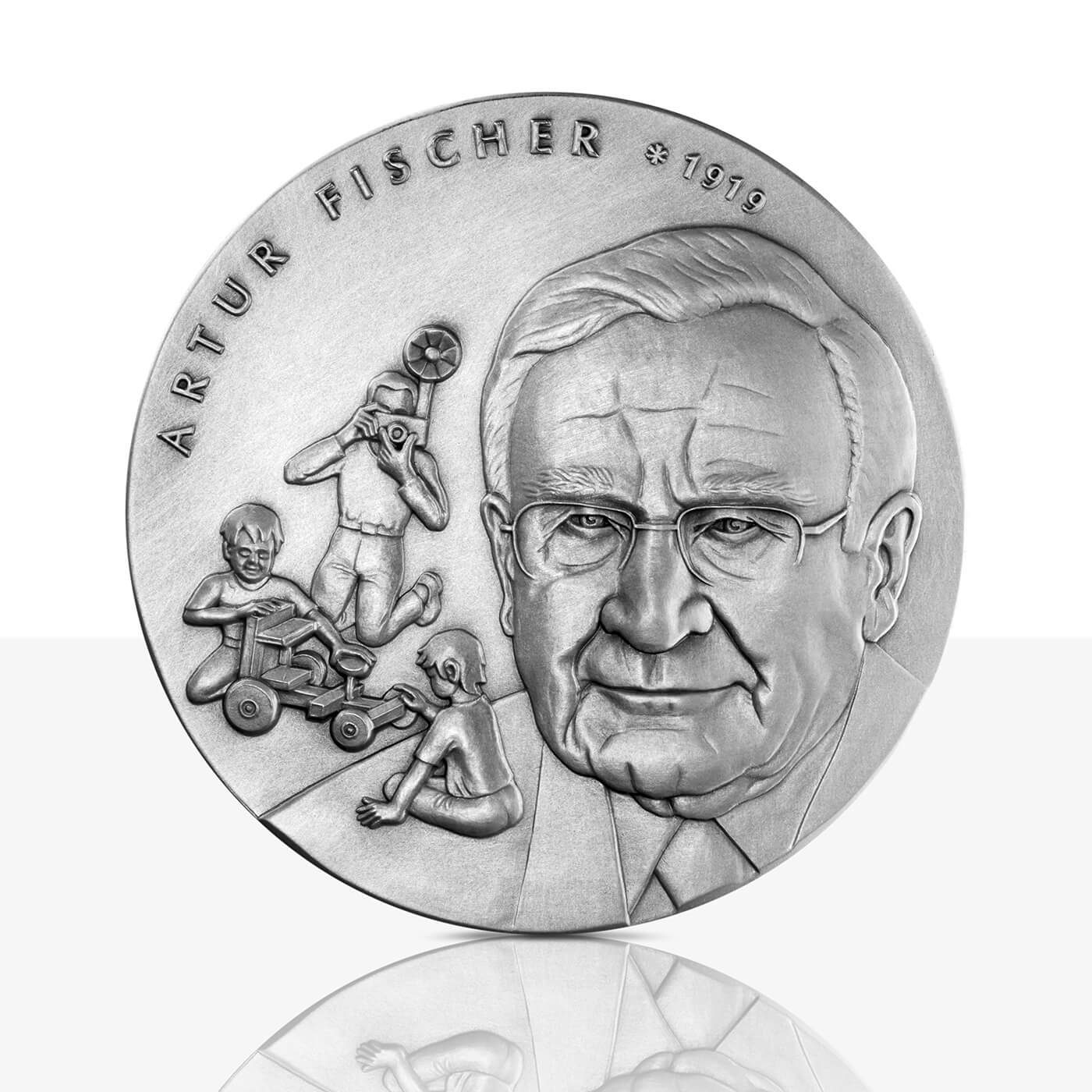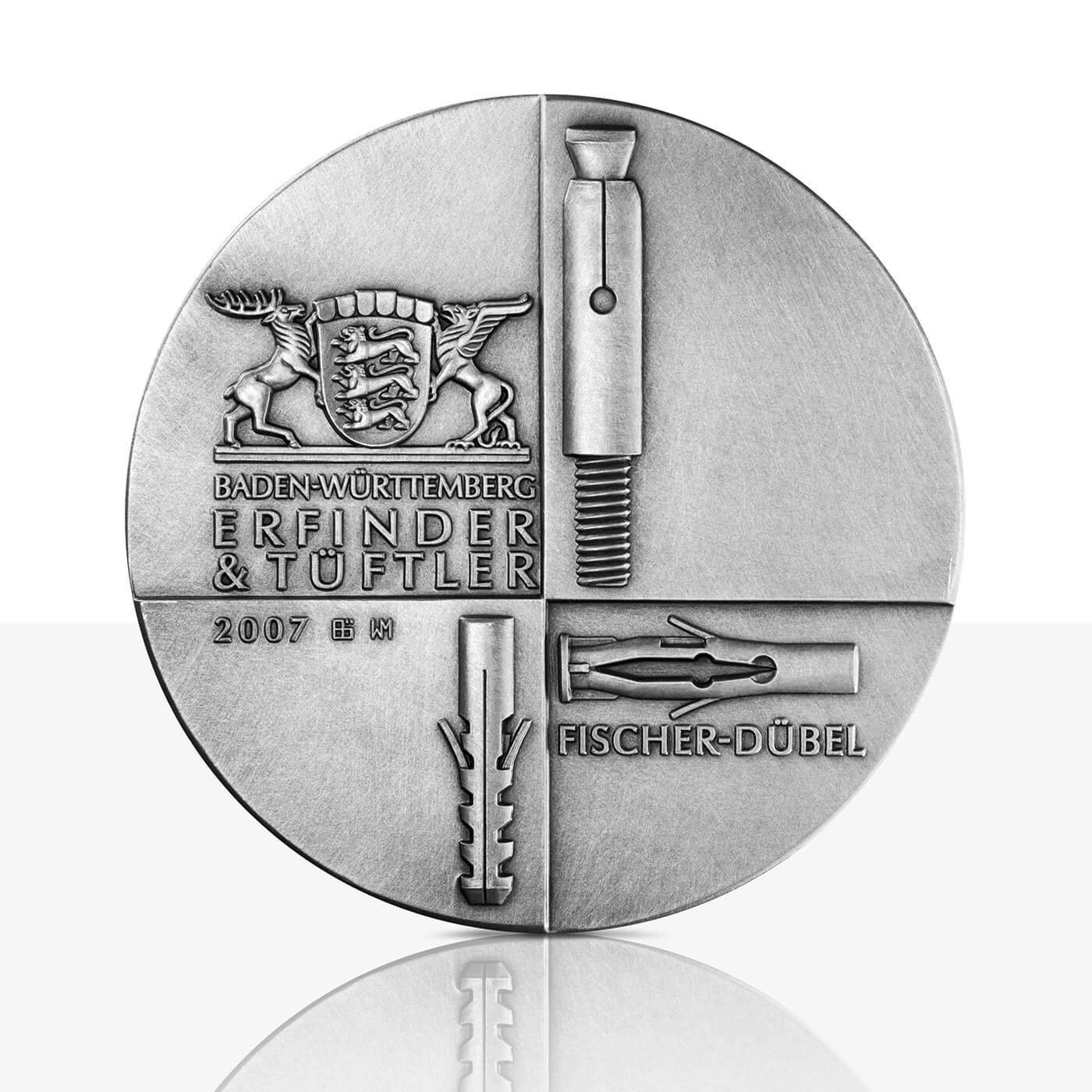Since 2008, the State Mints of Baden-Wuerttemberg have released an annual series of art medals dedicated to people who transformed our world with their creativity and left their mark on our federal state.
The medals are manufactured using the latest technology applied to a centuries-old handicraft tradition. They bear witness to the pre-eminence of the State Mints of Baden-Wuerttemberg as an innovative minting facility.
The series has been designed by the German architect and designer Prof. Ulrich Böhme. Werner Mebert masterfully translated his designs into dies.
Inventors from Baden-Wuerttemberg
Our art medal series
All Issues
Issue 2007: Artur Fischer
Issue 2008: Ferdinand Count of Zeppelin
Issue 2009: Karl Maybach
Issue 2010: Karl Drais
Issue 2011: Carl Benz and Gottlieb Daimler
Issue 2012: Margarete Steiff
Issue 2013: Heinrich Hertz
Issue 2014: Ferdinand and Ferry Porsche
Issue 2015: Alfred Kärcher
Issue 2016: Andreas Stihl
Issue 2017: Lennart Bernadotte, Count of Wisborg
2017
Lennart Bernadotte, Count of Wisborg (1909 – 2004)
Landscape architect of Mainau Island
Lennart Bernadotte, Count of Wisborg, is considered the founder of the “Insel Mainau” tourism enterprise. Born the Prince of Sweden in 1909, after his morganatic marriage, he took over the administration of the island from his father, Prince Wilhelm of Sweden. He gradually developed the former summer residence of his great-great-grandfather Grand Duke Frederick I of Baden into one of the major tourism businesses on Lake Constance. In addition, he was the first president of the Lindau Nobel Laureate Meetings, and for many years served as president of the German Horticulture Society of 1822.
Today, around 1.2 million people visit Mainau Island annually. Countess Bettina Bernadotte and Count Björn Bernadotte, two of Count Lennart Bernadotte’s children, run the organization. With their Mediterranean flair, the castle park and botanical gardens beckon visitors with thousands of tulips in spring, roses in summer and richly coloured dahlias in the autumn as high points of the floral year. The park and gardens also give inspiration to garden lovers and offer visitors a place for recuperation and relaxation. The Butterfly House, one of the largest in Germany, is popular with children and adults year round.
2016
Andreas Stihl (1896-1973)
Inventor of the gearless petrol-powered chainsaw
Andreas Stihl is considered the “Father of the Chainsaw”. His “STIHL tree felling machine” alleviated the hard work carried out by lumberjacks, even though he was not the inventor of the chainsaw. Using Stihl’s machine lumberjacks no longer needed to bring felled tree trunks into a saw mill but were able to work on site with the chainsaw instead. The gearless petrol-powered STIHL Contra chainsaw was a breakthrough – it was lighter and more manageable than any competing products.
Stihl continues to be an important and valued employer in Waiblingen today. The Stihl calendar is iconic in workshops all over the world.
2015
Alfred Kärcher (1901-1959)
Designer of the European pressure washer
Alfred Kärcher was inspired by American hot water high-pressure washers, which the American army entrusted to him for repair after World War II. Based on the operation principle of those devices, he designed the first European pressure washer DS 350 that revolutionised cleaning technology in private households.
Nowadays Kärcher is the global market leader in cleaning technology. Its products are sold in 60 countries. Kärcher is headquartered in Winnenden and has its plant in Obersontheim, Bühlertal.
2014
Ferdinand Porsche (1875-1951) and Ferry Porsche (1909-1998)
Automotive engineers
Ferdinand Porsche is amongst the most important automotive engineers in the history of automobiles. As the chief constructor of a leading car manufacturer, he developed numerous vehicle types, including winning racing cars and the Volkswagen, with which he made automobile history. Ferdinand Porsche’s Type 64 laid the foundation for the later success of the Porsche sports car manufacturer. The design of the 911, the most popular Porsche of all time, harks back to his son, Ferry Porsche.
Today, the world’s streets are unimaginable without Porsche. Millions of young and old drivers dream of going beyond speed limits as they race around in a Porsche.
2013
Heinrich Hertz (1857-1894)
Discoverer of electromagnetic waves
Heinrich Hertz gathered evidence in Karlsruhe to prove that electromagnetic rays expand in free space. To that end, he had to generate the waves necessary to verify his experiment. For this purpose, he developed the first transmitter, a “Hertz dipole with sphere gap”. A frame aerial was used to receive waves. He was thus able to translate theory into practice, becoming the founding father of radio in the process.
Radio is still one of the best-loved mass media, even if aerials and electromagnetic waves are steadily being replaced by digital technology.
2012
Margarete Steiff (1847-1909)
Inventor of the soft toy
Margarete Steiff is considered by many to be a prime example of one’s ability to achieve success despite facing adverse conditions. She was visually impaired. Nevertheless this woman established her own company to manufacture goods made from felt after having finished her apprenticeship as seamstress at the age of 17. Her “Little Elephant”, which had originally been intended as a pin cushion, was hugely successful in nurseries and inspired her to make many more soft toys.
Her most famous product, the “Bear55PB” better known as teddy, can be traced back to an idea her nephew, Richard Steiff, had. In Giengen, Steiff still continues to produce a friend for life, recognised by the button in its ear, for millions of children worldwide.
2011
Carl Benz (1844-1929) and Gottlieb Daimler (1834-1900)
Designer of the first viable motor car resp. Inventor of the high-speed petrol engine
On 29 January 1886, Carl Benz applied for a patent for his Benz motor car no. 1. It was a three-wheeled vehicle with an internal combustion engine and electric ignition that demonstrated its viability for real-life use during a test drive, with his wife, Bertha Benz, at the wheel. In collaboration with Wilhelm Maibach, Gottlieb Daimler developed the first motorbike and the mobile single-cylinder four-stroke engine. At the World Exhibition in Paris in 1889, he presented the first four-wheeled motor vehicle with an internal combustion engine.
In 1926, Benz & Companie and the Daimler-Motoren-Gesellschaft merged to form the car manufacturer Mercedes. The brand is famous worldwide and has become a virtual poster child for the “Made in Germany” slogan.
2010
Karl Drais (1785-1851)
Inventor of the velocipede and type writter
On 12 June 1817 Karl Drais dashed across the best road of Baden at the breath-taking speed of approx. 15 kilometre per hour. He used his velocipede resp. draisine to do so. This was a horseless vehicle consisting of a wooden frame with two wheels, the front of which could be steered using a handlebar. Powered by the driver pushing, it made use of the two-wheeler principle and is regarded as the archetype of the bicycle.
2009
Karl Maybach (1879-1960)
Constructor of high-performance engines
In 1930, a new luxury car caused quite a stir at the Paris Motor Show. The Maybach Zeppelin DS7 contained the world’s first 12-cylinder engine with 200 HP, which was unheard of at that time, and a semi-automatic gearbox. That was only one of countless engines designed by Karl Maybach. Even at a young age, he had already revolutionised aviation in the Zeppelin owing to the construction of a whole new kind of drive. Countless engines hark back to him, particularly in the peak-performance range for aeroplanes, diesel locomotives and tanks.
In 1960, Daimler-Benz purchased Maybach-Motorenbau GmbH. Nowadays, the successor company is known as MTU Friedrichshafen. It is regarded as one of the world’s leading manufacturers of large diesel engines.
2008
Ferdinand von Zeppelin (1838-1917)
Pioneer of rigid airship manufacture
In 1900, a Zeppelin could be seen above Lake Constance for the first time. Even though Ferdinand von Zeppelin did not invent this rigid airship, the “Zeppelin” came into being solely as a result of his efforts. More than half of the share capital of 800,000 marks was raised by Zeppelin’s own private savings in 1898 to purchase and build on the patent 98580 for a “steerable aircraft with several frames arranged behind one another” for his company entitled “Aktiengesellschaft zur Förderung der Luftschifffahrt”.
In 1930, 13 years after the death of Ferdinand von Zeppelin, a transatlantic scheduled service involving a Zeppelin was provisioned between Europe and North and South America. It ended with the Lakehurst fire disaster of 1937.
It took another 40 years before Zeppelins were to fly over Lake Constance again. Today they are built and operated by Zeppelin Luftschifftechnik GmbH.
2007
Artur Fischer (1919-2016)
Inventor of the Dübel plug, synchronised flash photography, the building blocks of ``Fischertechnik`` and much more ...
By the end of 2013, Artur Fischer had applied for 1,136 patents and utility models at the patent office. He was issued 570 patents from the German patent office. Many of his inventions make our daily lives easier. The most famous of these is the Dübel plug, which allows anything to be tightly screwed to the wall. Fischer’s first patent, a flash that synchronised with the push of a shutter release, was marketed worldwide by Agfa.
Artur Fischer died in 2016 aged 96. He established his plants in 1948 and the parent company was based in Waldachtal. Today, the plants offer employment to 4,423 employees in 34 countries around the globe.
